

TEMPORAL HOLLOWS VOLUMISATION AND CONTOURING TARGETING THE ECM TO REJUVENATE THE FACE FOUR STAGE RHINOPLASTY WITH PDO THREADS NECKLACE LINES TREATMENT OPTIONS INTERNATIONAL JOURNAL OF AESTHETIC AND ANTI-AGEING MEDICINE Sep/Oct 2023 Volume 13 ❙ Issue 5 AMWC India 2023 ❚ The Indian Aesthetic Market ❚ Mesotherapy: To Promote Hair Growth
LOSS OF FACIAL HARMONY A side effect of HA fillers


HAVING JUST RETURNED FROM AMWC INDIA, I AM PLEASED TO SAY THE event was a huge success, and the response from delegates and exhibitors alike was overwhelmingly positive. A huge congratulations to the AMWC India team for putting it all together, and I look forward to returning next year. While a long time coming, with so many great Indian doctors practising aesthetic medicine around the world and with a growing market at home, it was inevitable that IMAesthetics would bring their flagship AMWC event to India. For PRIME too, I have witnessed the growth in our readership in India over the years in both print and digital formats, reflecting a growing appetite for educational content and a burgeoning aesthetic market.
To learn more about this market, in this issue, Rosalind Hill explores the growth and challenges of the Indian Aesthetic Market, offering insights from leading physicians on the industry’s trajectory. From speaking to those who know it best, we get a sense of an industry in rapid growth as the general public’s attitude to aesthetic medicine shifts, thanks, in part, to better education and awareness of treatments and greater economic prosperity. However, as is the case worldwide, rapid change often leaves regulation and governments playing catch up. Without more rules in place on product quality and who can perform treatments, the industry runs the risk of reputational damage that could hamper growth and patient trust. You can read the full feature on page 14.





Additionally, our cover feature this issue is by Dr Chiranjiv Chhabra, MD, who takes us through the concept of facial harmony and considerations for injecting the face to avoid suboptimal outcomes. She concludes that early intervention is crucial in the event of undesirable treatment outcomes or loss of facial harmony caused by the incorrect use of dermal fillers. Avoiding and managing the loss of harmony as a consequence of filler treatment requires a multi-layered approach, including preventive measures, patient education, physician education, early intervention, and correction strategies.






















Meanwhile, Dr Chytra Anand, MD, and one of the scientific directors of AMWC India, explores the often-overlooked area of neck ageing and the variety of available treatment options, from injectables to radiofrequency and threads.
In another article, Dr Jamuna Pai, MD, discusses the restoration of volume and contour to temporal hollows, addressing a common sign of facial ageing. Irina Poleva sheds light on the importance of the extracellular matrix in facial ageing and introduces a potential game-changing dermal biorevitalizer.




Dr. Aaron Hsiesh, MD, introduces a new approach to rhinoplasty using PDO barbed threads, providing an alternative to traditional surgery and temporary fillers.


Thank you to our authors for their contributions, and to our readers for your ongoing engagement. Happy reading!






 Balraj Juttla Editor, PRIME balraj.juttla@informa.com
Balraj Juttla Editor, PRIME balraj.juttla@informa.com


Manuscripts and accompanying files should be prepared in accordance with our Author Guidelines, which are available via www.prime-journal.com.































































































































| EDITORIAL Follow us @PrimeJournal FIND US ON TWITTER, FACEBOOK & LINKEDIN Join PRIME’s editorial team for the latest updates in aesthetic and anti-ageing medicine, debates, and interaction with your peers and colleagues, conference information and special offers Delicious Facebook Slash Do Reddit Newsvine Flick r MySpace FriendFeed SlideShare Twitter StumbleUpon Skype YouTube Google Retweet Digg echnorat LinkedIn Google Talk Search for Prime Journal Delicious Facebook Slash Dot Flick r MySpace Mixx Twitter StumbleUpon Skype Retweet Digg Technorat Follow us @PrimeJournal Delicious Facebook Slash Dot Flick r MySpace Mixx Search for Prime Journal It was inevitable
IM-Aesthetics would bring their
AMWC
India. Affiliated partners: International Journal of Aesthetic and Anti-Ageing Medicine Informa Australia, Level 4/24 York St, Sydney, NSW, 2000, Australia ISSN 2159-8908 (print) ISSN 2159-8916 (online) Editor Balraj Juttla balraj.juttla@informa.com Art Director David ‘Spike’ McCormack Digital Marketing Manager Slim Hakimi slim.hakimi@informa.com Production & Ads Department balraj.juttla@informa.com Please send your manuscripts and press releases to: balraj.juttla@informa.com All submitted manuscripts are evaluated on the basis of scientific quality, originality, appropriateness, contribution to the field and style. Suitable manuscripts are subject to peer-review.
All content © 2023 Informa UK Ltd. Images © Stock.adobe.com, unless otherwise stated SUBSCRIPTION RATES UK: £180 Europe: €180 Rest of world: US$180 LOSS OF FACIAL HARMONY A side effect of HA fillers TEMPORAL HOLLOWS VOLUMISATION AND CONTOURING TARGETING THE ECM TO REJUVENATE THE FACE FOUR STAGE RHINOPLASTY WITH PDO THREADS NECKLACE LINES TREATMENT INTERNATIONAL JOURNAL OF AESTHETIC AND ANTI-AGEING MEDICINE Sep/Oct 2023 Volume 13 Issue AMWC India 2023 The Indian Aesthetic Market Mesotherapy: To Promote Hair Growth Cover image Stock.Adobe.com Retouching Linda Duong 4 ❚ September/October 2023 | prime-journal.com
that
flagship
event to

Fotona4D® is a non-surgical laser treatment that uses a unique combination of 2 complementary laser wavelengths to treat 4 distinct “dimensions” of the skin to rejuvenate and tighten from the inside out.


Committed to engineering:
Made
The next generation in multi-application
www.fotona.com The Highest Performance, Best
Laser Systems in the World
SP Dynamis® Nx Line
97564/1
NON-INVASIVE LASER FACELIFT
NEWS
9 Kaya Clinic expands its retail presence in Delhi by launching its largest clinic to date
10 New data reveals a surge in nonsurgical procedures


EVENT REVIEW
12 AMWC India Symposium 2023
INDUSTRY INSIDER
14 The Indian Aesthetic Market in 2023: business is booming but there could be trouble ahead India is one of the fastest-growing economies in the world right now, and interest in aesthetic medicine is growing among patient groups. However, the industry is at a crossroads, with a lack of regulation stifling trust. Rosalind Hill spoke to four leading aesthetic physicians about the growth and challenges ahead.
AESTHETIC FEATURES
18 Loss of facial harmony: a side effect of HA fillers
Chiranjiv Chhabra, MD, explores the concept of facial harmony and what to consider when injecting the face to avoid sub-optimal results
26 Temporal hollow augmentation using hyaluronic acid fillers
Jamuna Pai, MD, discusses how best to restore volume and contour to the temporal hollows and address a common sign of facial ageing
32 Treatment options for necklace lines
Chytra Anand, MD, explores neck ageing and the range of treatment options available, such as injectables, radiofrequency and threads, to address this often overlooked area


36 Targeting the extracellular matrix to restore and rejuvenate the face
Irina Poleva, MD, explains the importance of connective tissue to facial ageing and how a new dermal biorevitaliser could be a game changer
40
Four-stage
rhinoplasty with PDO barbed threads
Aaron Hsiesh, MD, discusses a new approach to rhinoplasty that avoids the pitfalls of filler and the downtime of surgical rhinoplasty
CASE REPORT
44 Mesotherapy to prevent hair loss and promote hair regrowth
Nata Maghalashvili, MD, discusses her experience using ARES® Hair Booster
PRIME PROMOTIONS
48 Secret Duo 1540 nm ER:Glass laser treatment for skin rejuvenation
Agnieszka Lew-Mirska, MD, discusses the clinical results she experienced using the Secret 1540 nm non-ablative fractional Er:Glass laser for skin rejuvenation
50 Buttock volumising and lifting using hyaluronic acid dermal filler
Hanbit Hong, MD, explains why he believes the monophasic HA dermal filler e.p.t.q.® is the ideal product for buttock lifting
52 Efficacy and safety of a recombinant enzyme treatment with collagenase for oedematous-fibrosclerotic panniculopathy
Drs Maghiell Gordón, Katherine Jaén, Jamel Fares, and Carlos Aznar discuss the results from a recent study
PRIME PEOPLE
54 Wendy Lewis spoke to Jean-Yves Coste, Co-Founder of WINDOME BANKING PARTNERS in Paris, to get his perspective on the global aesthetic market today and what the future holds for companies, investors, practitioners and patients
EVENTS
58 A round-up of the major industry events happening around the world over the next 12 months
September/October 2023 | CONTENTS
p18 p26 p44 p32 prime-journal.com | September/October 2023 ❚ 7
A round-up of news stories in the aesthetic and anti-ageing medicine industry
KAYA CLINIC EXPANDS ITS RETAIL PRESENCE IN DELHI BY LAUNCHING ITS LARGEST CLINIC TO DATE

CELEBRATING 20 YEARS AS ONE OF INDIA’S LARGEST AESTHETIC DERMATOLOGY BRANDS
Kaya, India’s leading aesthetic dermatology clinic, is expanding its retail presence in India with the launch of its largest flagship clinic at Rajouri Garden in Delhi. Located in the heart of the western section of the capital – Rajouri Garden is one of the most well known and upscale localities. The clinic is spread over approx. 2500 sq.ft, and aims to get one step closer to its expanding customer base. The launch is aligned at a time when Kaya proudly celebrates 20 years of rich legacy that has helped beautify over 1 million customers and counting.
With over 70+ clinics in 20+ cities with 90+ dermatologists, the clinic at Rajouri Garden further cements Kaya’s vision as a global brand. Rajouri Garden as a location is home to a young, vibrant, aspirational and beauty and wellness enthusiast audience, who define the vision Kaya has for the new clinic.
Being one of the largest aesthetic dermatology chains in India with 90+ dermatologists, Kaya ensures the best, with State-of-art technology, globally acclaimed services, and holistic solutions for skin, body and hair.
Today, the brand has established itself as the number one skin clinic chain and has now successfully ventured into allied services such as body and hair to provide clients a holistic ritualistic Kaya experience. To celebrate the marquee occasion of completing 20 years, the brand launched their latest campaign: #FlauntYourBeauty, which encourages people to proudly flaunt their aesthetic treatments
and not hide them.
Mr. Rajiv Suri, Global CEO of Kaya says, ‘We are ecstatic to bring forth the finest skin, hair, and body care services yet again at Rajouri Garden in West Delhi. This new milestone highlights our strong ongoing commitment to India. Our goal is to ensure that our world-class services are easily and conveniently accessible to more and more beauty and wellness enthusiasts in India. Delhi is one of our key markets and the new clinic will be wellequipped with the best of technology, services and products promising an unforgettable experience to our customers.’
Mr. Rajiv Nair, Group CEO Kaya says, ‘We at Kaya always believe in holistic wellness and the brand has led the way for about two decades now. We are working at constantly improving and redefining our services with our consumers, which is integral to Kaya’s ethos. We are extremely delighted to announce the launch of Kaya’s new clinic where our complete commitment will continue to lie in celebrating each consumer’s unique individuality by offering personalized solutions with a resultoriented service.’
‘OZEMPIC FACE’ ON THE RISE ACCORDING TO NEW AAFPRS SURVEY
In a recent June 2023 survey from the American Academy of Facial Plastic and Reconstructive Surgery (AAFPRS), 60% of facial plastic surgeons report seeing an increase of patients presenting with ‘Ozempic Face’ — a side effect of the weight loss drug Semaglutide that results in facial deflation and, ultimately, a prematurely aged appearance.
A total of 15% of facial plastic surgeons surveyed recommend
treating Ozempic Face exclusively with facial filler; 12% recommend face and neck lifts; and 2% recommend fat grafting. Worth noting is that less than 25% of patients elect to have surgery, and 25–50% of patients, according to AAFPRS members, opt for injectables. Finally, when asked how patients will do long-term with injections and/or surgery, 45% of facial plastic surgeons surveyed responded that it’s too
soon to know—and there’s good reason for this.
‘Until now, we’ve been able to correct facial gauntness caused by extreme weight loss very easily with filler—but facial gauntness caused by Ozempic is a bit more complicated,’ says Theda Kontis, MD, facial plastic surgeon and President of the AAFPRS. ‘If the weight comes back, that filler can start to look very distorted if it has not been placed precisely.’
Dr. Mark Hamilton,
Chair,
adds, ‘The good news is that we can treat many of the aesthetic side effects of these weight loss medications with either injectable fillers, implants or surgery. The caveat is that to maintain the results of the aesthetic treatments and the weight loss, patients will need to make changes in their diet and lifestyle.’
NEWS | 8 ❚ September/October 2023 | prime-journal.com
news
AAFPRS
Public Information Committee,
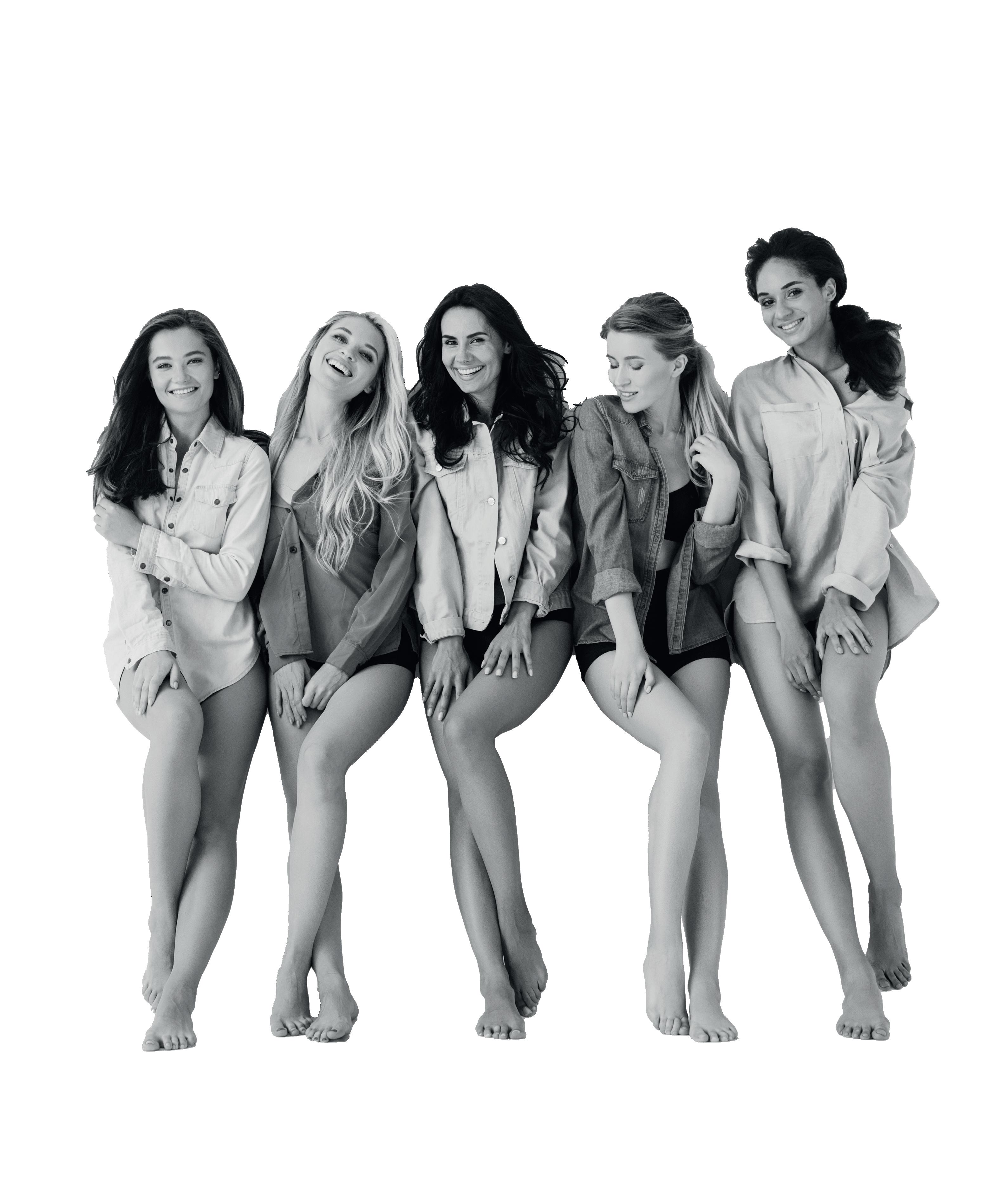


BREAKTHROUGH IN TISSUE [RE]GENERATION FOR FACE & BODY Tema Medicina S.r.l. | Bologna - Italy | Tel. +39 051 0828559 | info@temamedicina.com | www.temamedicina.com | www.attivarf.com *In the United States is indicated for treatments based on the emission of electromagnetic waves that lead to a rise of internal temperature of tissues involved in the treatment for electrocoagulation and hemostasis. It can be used on adult patients only. FDA CLEARED * PATENTED TECHNOLOGY ADVANCED TEMPERATURE CONTROL FOR MEDICAL USE ONLY 1370
NEW DATA REVEALS A SURGE IN NONSURGICAL PROCEDURES
FIGURES RELEASED BY THE AESTHETIC SOCIETY SHOW A 14% RISE IN 2022
The Aesthetic Society, the leading authority on aesthetic plastic surgery, has released its annual Aesthetic Plastic Surgery National Databank report for 2022, highlighting significant trends in the field of aesthetic plastic surgery. The data showcases a remarkable 14% increase in total aesthetic procedures, largely attributed to the soaring popularity of nonsurgical procedures, which witnessed a 23% jump last year. In an unprecedented milestone, the 2022 data was sourced from the same 200 plastic surgery practices across the United States, providing consistent quarterly data between 2019 and 2022.
‘The landscape of aesthetic plastic surgery is undergoing a transformation as revealed by The Aesthetic Society’s 2022 report,’ says Melinda Haws, MD, President of The Aesthetic Society. ‘With nonsurgical procedures witnessing a surge and surgical procedures still accounting for 70% of revenue, the industry is moving towards a future defined by dynamic trends. This showcases our industry’s ability to embrace innovation and meet evolving patient preferences. As we journey forward, The Aesthetic Society is dedicated to supporting our patients through top-tier member education.’
‘The 2022 statistics, drawn from 200 U.S. practices is a significant milestone for aesthetic data, offering consistent insights from 2019 to 2022,’ explains Dr. Kye Higdon, Communications Commissioner of The Aesthetic Society. ‘From this data we’re able to understand the trends on the horizon for our specialty and can help shape a future for aesthetics that both drives innovation and empowers our patients.’
The report reveals an interesting trajectory for surgical procedures. After experiencing a surge in the second half of 2020 and reaching its peak in the Spring of 2021, 2021’s surgical counts surpassed pre-pandemic levels by an impressive 55%. Although 2022 saw a decline in
ACNE KELOIDALIS NUCHAE STUDY OFFERS NEW HOPE
surgical procedures compared to 2021, the numbers remained a notable 37% above the counts in 2019. This increase was largely fueled by significant gains in body procedures, with liposuction (+63%) and abdominoplasty (+55%) leading the way. Conversely, nonsurgical procedures took some time to recover from the pandemic’s impact, with significant growth observed in the Spring of 2021, possibly reaching their peak in the Spring of 2022.
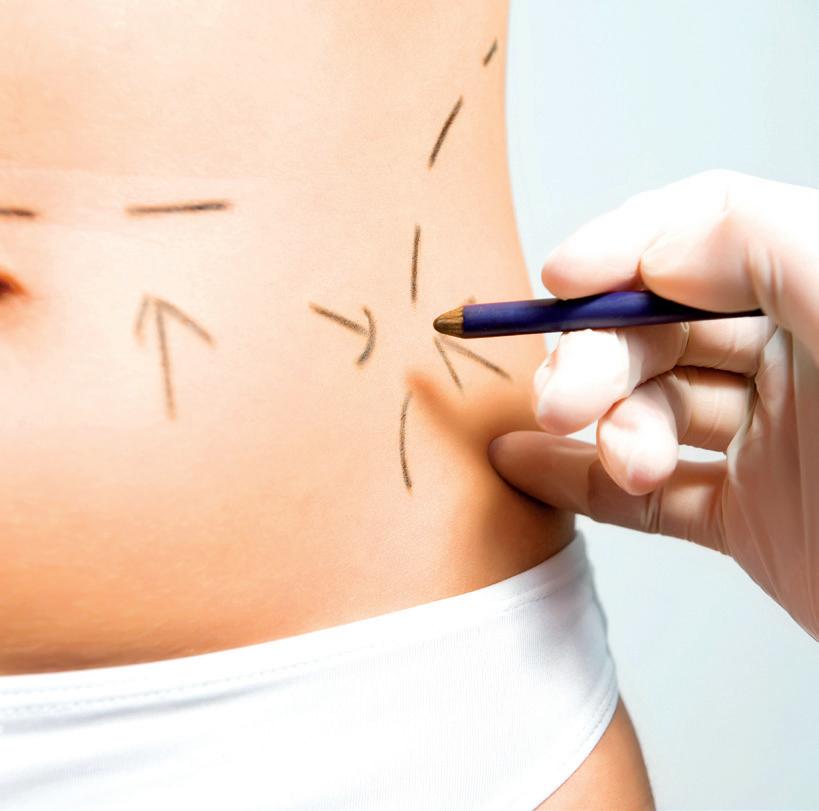
Quarterly data from the report indicates that the number of procedures performed by surgeons has been well-balanced throughout the year, with the Spring season (April–June) emerging as the most popular period for cosmetic enhancements. Approximately 55% of all surgical procedures were conducted in the first half of the year, with this pattern consistent across body and breast procedures, as well as other surgical treatments.
The average plastic surgeon performed 252 surgical procedures in 2022, showing a 13% decrease from the 289 procedures conducted in 2021. However, despite this decline, surgical counts remained an impressive 27% higher than the pre-pandemic levels of 198 procedures in 2019. 2022 saw Americans spending over $11.8 billion on aesthetic procedures overall, up 2% from the previous year.
Women continued to dominate the demographic of individuals undergoing aesthetic procedures, representing 95% of all procedures. Among surgical procedures, the most popular age group was 51–70-year-olds, accounting for 36% of all surgeries. The 36–50 age group closely followed with 30%, and 17–35-year-olds accounted for 27%. Patients over the age of 70 represented 8% of all surgical procedures.
The Aesthetic Society’s latest report offers invaluable insights into the trends shaping the aesthetic industry.
Despite the decline in surgical procedures, the overall growth driven by nonsurgical treatments demonstrates the industry’s adaptability and continued evolution.
Dr. U Hair and Skin Clinic announce a recent research report has illuminated a potential breakthrough in treating Acne Keloidalis Nuchae (AKN), a chronic and burdensome condition. The study titled ‘Papular Acne Keloidalis Nuchae Treatment Success using Follicular Unit Excision’ was published in the Journal of The American Academy of Dermatology — JAAD Case Reports.
AKN is marked by persistent inflammation, scarring hair loss (alopecia), and distressing symptoms, including malodorous discharge, keloid-like lesions, discomfort, itching, and social difficulties. While it predominantly impacts men of colour, recent studies have shown that European-descended Whites account for 9–10% of cases, with women affected the least.
The study reports the first-time use of follicular unit excision (FUE), often used in hair transplantation, as a potential remedy for AKN. FUE targets individual hair follicles within visible AKN papules, aiming to halt the disease while minimising scarring. The research highlights positive outcomes in three patients who underwent this FUE-based approach.
Dr. Sanusi Umar, the lead author of the study, explains, ‘Our study suggests that FUE could be a promising treatment for AKN, particularly when hair-bearing papules are involved. This method holds the potential for lasting remission while preserving the patient’s appearance.’
The study delves into the methods used, patient selection criteria, and the innovative FUE technology UGraft Zeus® (Dr. U Devices Inc., Manhattan Beach, CA), which enables the extraction of AKN-affected often-curly hair deeply embedded in scar tissue. The research emphasises the importance of specialised FUE devices and minimising the risk of damage to hair follicles.
Patients with confirmed AKN lesions who had not responded to standard treatments experienced lasting relief after a single FUE-based treatment session.
These findings offer hope to individuals dealing with AKN and healthcare professionals seeking novel strategies to address the condition.
NEWS | 10 ❚ September/October 2023 | prime-journal.com
2022 saw Americans spending over $11.8 billion on aesthetic procedures overall, up 2% from the previous year.

AMWC INDIA SYMPOSIUM
Looking back at the debut of the world’s leading aesthetic and anti-ageing medicine world congress in India
IM-aesthetics and the Scientific and Organising Committee were genuinely honoured and excited to welcome attendees to the inaugural AMWC India Symposium, which took place on September 15–16, 2023, in Mumbai, India.

Under the scientific supervision of the Aesthetic Multispecialty Society (AMS), AMWC India hosted two days of a multidisciplinary aesthetic and antiageing medicine programme designed to promote high-level continuing education, inspire new ideas, and celebrate the sharing of expertise. The Symposium was a great success and a selection of speakers tell us in their own words what made them want to participate in this momentous occasion.
Dr. Kashif Ali Aesthetic Physician United Kingdom

I felt honoured to be a part of AMWC India. Being a faculty member and a speaker at the symposium, I was excited to share my insights and experiences with the delegates.
AMWC stands as a pinnacle in the field of aesthetic and anti-ageing medicine. Drawing professionals, experts, and enthusiasts from around the globe, this symposium has consistently set a benchmark for innovation, knowledge exchange, and cutting-edge advancements in the industry. The first edition of AMWC India brought knowledge and innovation to one of the largest hubs of the aesthetic industry.
At AMWC India, attendees were immersed in a world of knowledge through captivating lectures delivered by some of the brightest minds in the field. These sessions covered a vast spectrum of topics, ranging from emerging technologies to novel treatment modalities, providing attendees with an in-depth understanding of the latest trends.
One of the standout features of AMWC India was its hands-on workshops and live demonstrations. These interactive sessions provided attendees with a unique opportunity to witness techniques and procedures in action, fostering a deeper comprehension of various treatment options.
AMWC India served as a melting pot for industry professionals, offering a
MEETING REVIEW | 12 ❚ September/October 2023 | prime-journal.com
conducive environment for networking. Engaging with luminaries in the field not only opens doors for collaboration but also facilitates the exchange of ideas that can drive the industry forward.
The congress acts as a hub for forging strategic partnerships and alliances. Whether you are a seasoned practitioner or a burgeoning entrepreneur, AMWC India provided the ideal backdrop to connect with like-minded individuals and explore avenues for growth.
AMWC India showcased the technological breakthroughs that are reshaping the landscape of aesthetic and anti-ageing medicine. From advanced laser systems to ground-breaking noninvasive procedures, attendees gained insights into the tools that are revolutionising patient care.
expertise and knowledge with skin of colour, while leading aesthetic physicians around the world shared their knowledge as well. It was a meeting of worlds for fruitful understanding of this evergrowing, deepening and innovating field of aesthetics.
Dr. Marva Safa Aesthetic Physician Switzerland
For me, it was such a privilege to be part of AMWC India in its first year! This symposium brings together the best in the industry, and to be able to share knowledge with like-minded colleagues in such an amazing country as India is even more thought-provoking and exhilarating. Looking forward to more meetings to come.
Dr. Noura Lebbar Cosmetic Surgeon Italy

I was so excited to be a faculty member at AMWC India. AMWC was finally held for the first time in India, and the event was absolutely successful as we shared and learned about the most advanced aesthetic techniques. It was an amazing opportunity to learn from the best faculty coming from all over the world.
Dr. Shubha Dharmana Aesthetic Physician India

AMWC is one of the world’s best platforms for aesthetic medicine that’s always provided practitioners with great learning, education and skills from the innovators and the best in the field. The conference is very thorough and covers everything you need to know in the field, such as injectables, lasers, energy devices, topicals and aesthetic treatments that every practitioner needs to know. What’s more, you get to network with allied practitioners, peers and trainers from all over the world. In this fast-paced field that’s evolving every few months, it is essential to keep oneself updated on the latest cutting-edge technology and learn from the experts’ experience and mistakes to continue to evolve and further our own practice.
As a faculty member and speaker, AMWC India allowed us to share our own research and scientific findings with a global audience. This platform not only fosters intellectual discourse but also propels the industry towards evidencebased practices. I presented my cases and experience on mid-face rejuvenation with CaHA and biostimulators.
At the core of AMWC India’s ethos was a commitment to ethical practices and patient safety. This emphasis ensures that attendees left the congress with a renewed dedication to upholding the highest standards of professionalism and care.
Dr. Kiran Lohia Aesthetic Physician India

I was thrilled to hear AMWC was bringing the latest world knowledge in aesthetics to India. It gave Indian doctors the chance to share their
I shared my experience with the latest findings in acne treatment using a very advanced energy-based device. I also demonstrated my results with regenerative medicine, especially plateletrich plasma, used for face and neck rejuvenation.
Dr. Sabine Zenkar Dermatologist Germany


I was delighted to be asked to participate in the first AMWC held in India, an amazing country with amazing doctors and patients!
As a scientific director and faculty within the AMWC family since the early years, It was great to now expand to India.
At AMWC India, I taught two of my favourite topics: treating unwanted hyperpigmentation, such as melasma, and combining facial transformation treatments, both subjects I am an expert in.
I got to present two of my papers this year at AMWC Monaco in March 2023, one of which was a poster presentation on ‘Safety and efficacy of RF microneedling as a treatment modality to improve mild to moderate skin laxity’ and the other an oral presentation on ‘Efficacy and role of toxins, peels and energy-based treatments in the treatment of excessive oiliness and open pores’. I have been attending AMWC Monaco since 2010, and to be able to present where I have always aspired and learnt from the best in the field is truly a dream come true!
I, therefore, felt really honoured to be part of AMWC again as faculty, this time happening for the very first time in India in our very own Mumbai, where I presented on two different topics ‘PRP vs GFC for hair, which and when’ in the— ‘Hair today, Here to stay’ section and ‘Microneedling for skin laxity’ in the — ‘Power up your practice: Harnessing the power of Energy-based devices for superior results and patient satisfaction’ section.
| MEETING REVIEW prime-journal.com | September/October 2023 ❚ 13
AMWC India hosted two days of a multidisciplinary aesthetic and anti-ageing medicine programme designed to promote high-level continuing education, inspire new ideas, and celebrate the sharing of expertise.
THE INDIAN AESTHETIC MARKET IN 2023
BUSINESS IS BOOMING BUT THERE COULD BE TROUBLE AHEAD
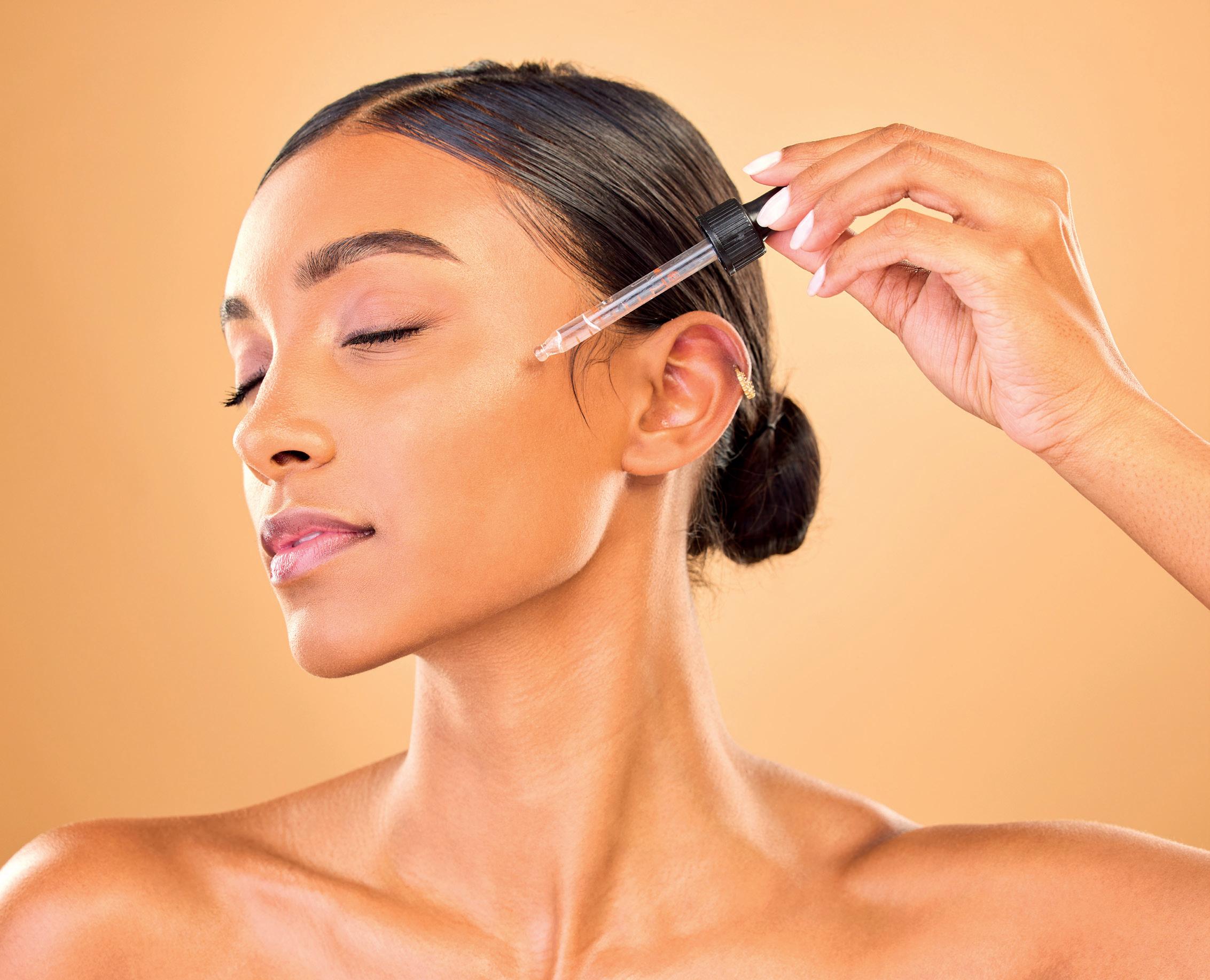
INDUSTRY INSIDER | THE INDIAN AESTHETIC MARKET | 14 ❚ September/October 2023 | prime-journal.com
BUSINESS IN INDIA IS BOOMING.
According to the World Bank1, the South Asian country has one of the fastestgrowing economies in the world. In the last 10 years alone, the country’s economic growth has seen it emerge as a global financial player — overtaking the UK as the world’s fifthlargest economy in September 2022. This global outlook is reflected in the growth of many industries in the country — not least in aesthetic medicine, where the skincare dermacosmetics market generated an estimated $188.2 million of revenue in 2021 and is expected to grow at a CAGR of 10.2% to 20302
‘The metamorphosis of the Indian aesthetic market, from its nascent stages to its present magnificence, is a narrative that fills me with a profound sense of pride,’ said Dr Jamuna Pai, a cosmetic physician based in Mumbai. ‘The infusion of advanced techniques and treatments, many of which I have had the privilege of introducing, has redefined conventional notions of beauty and aesthetics.
‘What started off as simple treatments for acne and pigmentation on the skin has now evolved and flourished into more advanced treatments like nonsurgical skin tightening, microblading, micropigmentation, laser resurfacing, microneedling, hair transplant, and also body contouring. We have observed a steady and rising demand for all these treatments and skin care products alike over the last two decades.’
‘The Indian aesthetic market has grown by leaps and bounds, and there has been rapid growth in all areas of aesthetic dermatology,’ agreed Dr Mukta Sachdev, a consultant dermatologist in Bangalore. ‘There are numerous centres and clinics opening up everywhere, and that, of course, comes with its own issues of lack of training and increasing risks of complications. This growth is also on track for the future with no signs of slowing for a while.’
Nevertheless, despite the high growth — a growth that is predicted to continue across the 2020s — the market itself is still in its relative infancy compared to its Western counterparts.
‘It’s early, it’s in its infancy, and it’s growing very fast,’ said Dr Nitin Sethi, a plastic surgeon in Punjab. ‘And the
aesthetically-oriented population is growing too. It used to be a taboo to opt for aesthetic treatments, but perceptions are changing, and the acceptability of treatments is growing quickly.’
The role of social media
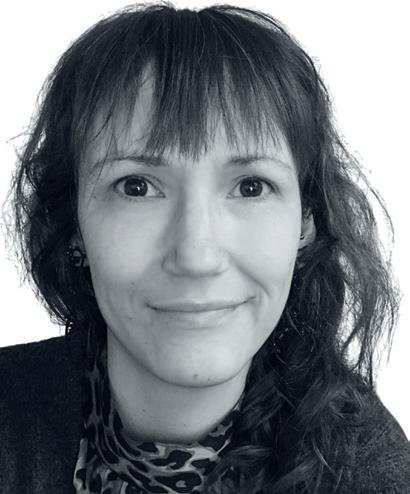
There is no doubt that social media has a lot to answer for when it comes to unrealistic beauty standards, or spreading misinformation the world over. However, when it comes to the perceptions of aesthetic treatments in India, there’s no doubt it has had an impact in shifting the previous taboos that came with visiting a doctor’s office for fillers and toxin. With one of the youngest populations in the world (the average age is 29), social media use among the young has sparked a sea-change in perceptions of beauty — and beauty treatments — that shows no sign of abating. Dr Jaishree Sharad, a cosmetic dermatologist based in Mumbai, grew her following of 200,000 on Instagram throughout the COVID-19 pandemic by answering follower questions on her channel (and has now published her third book to bring the Q&A together).
‘I realised a lot of people wanted to learn about skin; suddenly the interest was growing, and there were a lot of influencers who were talking about skincare, but they were often sharing things that were incorrect,’ she said. ‘There was misinformation because some of the influencers probably were not dermatologists or physicians, or did not have an aesthetic or scientific background.’
As with other geographies, however, India has seen its fair share of negative aesthetic trends as a result of social media, but more doctors are using it as a force for good and to educate followers on how to do skincare right, rather than relying on home remedies. Though, there is still somewhat of a mountain to climb despite the fast growth of the industry.
“I’m a plastic surgeon doing a lot of non-surgical work as well as surgical work, but generally speaking, many patients still prefer to go to beauty parlours to get their faces fixed,’ said Dr Sethi. ‘I think times are changing though. I think we’re seeing more people who are open to getting aesthetic treatments, but I think cost remains one of the major issues for Indian patients because I think
contact missrosalindh@gmail.com
prime-journal.com | September/October 2023 ❚ 15 | THE INDIAN AESTHETIC MARKET | INDUSTRY INSIDER
India is one of the fastest-growing economies in the world right now, and interest in aesthetic medicine is growing among patient groups. However, the industry is at a crossroads, with a lack of regulation stifling trust. Rosalind Hill spoke to four leading aesthetic physicians about the growth and challenges ahead
The metamorphosis of the Indian aesthetic market, from its nascent stages to its present magnificence, is a narrative that fills me with a profound sense of pride.
– Dr Jamuna Pai
ROSALIND HILL is a freelance journalist and content strategist. She was the launch editor for PRIME Journal in 2011.
Patients should be able to rest easy that a product is being injected into the right location, that it’s FDA-approved and a genuine product. People are injecting it in the name of Botox, but in reality it’s another neurotoxin entirely.
– Dr Jaishree Sharad
dissatisfaction with body appearance, which then translates to aesthetic procedure demand.’
A need for regulation
As is often unsurprising in fast-growth markets, there comes an inflection point, and for the Indian aesthetic market that inflection point may hinge on its regulation. At present, the industry is dogged by inexperienced, under-trained injectors, as well as door-to-door laser treatments (especially for hair removal), which not only gives the aesthetic treatments themselves a bad reputation, but then leaves the professionals to pick up the pieces — and of course, they just can’t compete with the low-cost offerings of industry ‘cowboys’.
‘Regulation is increasingly becoming a concern, and of course, the requirement is that trained and experienced medical professionals perform aesthetic treatments, but it’s not always the case,’ said Dr Sachdev. ‘There have been regulations imposed regarding which specialists can perform hair transplant surgeries and where it is permitted, for example, and the Indian Association of Dermatologists, Venereologists and Leprologists (IADVL) are formulating guidelines for certain procedures, but in a country as large and populated as India, it’s a huge challenge.’

Furthermore, part of the challenge lies in that even where there are regulations — about who can perform which treatments and what training is required — that regulation isn’t always followed.
‘We have regulation on who does it, but the implementation is very subjective and not at all strict,’ said Dr Sethi. ‘The more adventurous patients don’t mind going to a beauty parlour for fillers or toxins because oftentimes it’s cheaper, or it may be bundled in with other services like a massage or treatments being dubbed “hair Botox”, for example. There is no regulation to control that; what they use and the quality of what they use is not controlled, and that’s the problem. People from other specialties can also jump in and start doing aesthetic procedures when they are not specifically trained to be doing that— having formal training in aesthetic procedures is not a prerequisite, which is a further challenge. It’s like a ticking timebomb, and we’re waiting for a major issue to happen before some regulations will come into force.’
we’re still a country where people don’t prioritise their own faces. And they believe that spending on a dress is more important than spending on the face.’
However, it is the younger generations — in work, successful, with money to spend and wanting to look good because of the influence of social media — who care about prioritising their skin health.
‘I’m seeing the patient profile getting younger and younger for aesthetic treatments, with an increased willingness to undergo procedures and an increase in spending power,’ said Dr Sachdev. ‘However, I also see an increased incidence of body dysmorphic disorder and
Dr Sharad agreed. ‘This is your face, it’s not a toy. Patients should be able to rest easy that a product is being injected into the right location, that it’s FDA-approved and a genuine product. People are injecting it in the name of Botox, but in reality it’s another neurotoxin entirely. At present, the patient just doesn’t understand that or the risk of not going to a medically-trained specialist for such treatments. I think there’s a need for a lot of awareness, a lot of education, and to be able to actually look at the doctor’s qualifications and the amount of training that the doctor has undergone. It’s prima facie, really.’
Part of that awareness and education comes with building trust among patients seeking out aesthetic treatments, which so often comes with the long-term relationship between patient and physician. For
INDUSTRY INSIDER | THE INDIAN AESTHETIC MARKET | 16 ❚ September/October 2023 | prime-journal.com
Dr Sachdev, this has come through treatments and care that extend beyond the doctor’s office.
‘Skin care programmes are popular as patients are no longer just looking for quick-fix treatments,’ she said. ‘The future of prescriptive facials are long-term bespoke programmes; the same way you think about a training programme for your body, it is the same concept for the skin, mind, and body. There is a demand for luxury care both inside and outside of the treatment room, which includes pre- and post-treatment care, specialist consultancy and at-home routine recommendations for long-term results.’
Looking to the future
So where to next for the Indian aesthetics market? While the lack of regulation poses a significant challenge, the projected industry growth is an exciting prospect. Though there is a sense that it’s all balanced on a precipice, and the future of the industry could go any way at this point.
‘The market is definitely at a crossroads right now,’ said Dr Sethi. ‘It could become very popular and then a way of life for most people, or it could be destroyed by people who are not trained properly to carry out the treatments. If someone has a filler treatment carried out by someone who hasn’t been trained to carry out that treatment, it’s not the doctor that’s blamed, but the filler — the product. It’s the treatment that becomes unpopular. That said, it’s a great time to be an aesthetic practitioner precisely because the market is growing and moving so much. My only caution would be for physicians to stay up-to-date with their skills and training at all times to help it stay as high-quality as possible.’
There’s no doubt a high-quality industry— in practice and in product— will reap benefits for both physicians and patients alike. Patients themselves are taking a different approach to seeking medical aesthetic treatments. Where once it was somewhat of a secret to visit the doctor’s office, now patients are being more assertive about what they’re looking for.
‘In the metropolitan areas and larger cities, I see far less reluctance to spend, and patients are quite open and assertive about what it is they’re looking for,’ said Dr Sachdev. ‘Patients are coming into the office and asking for specific procedures — they’ve used the cream, so now they want the laser, and this wasn’t the case just
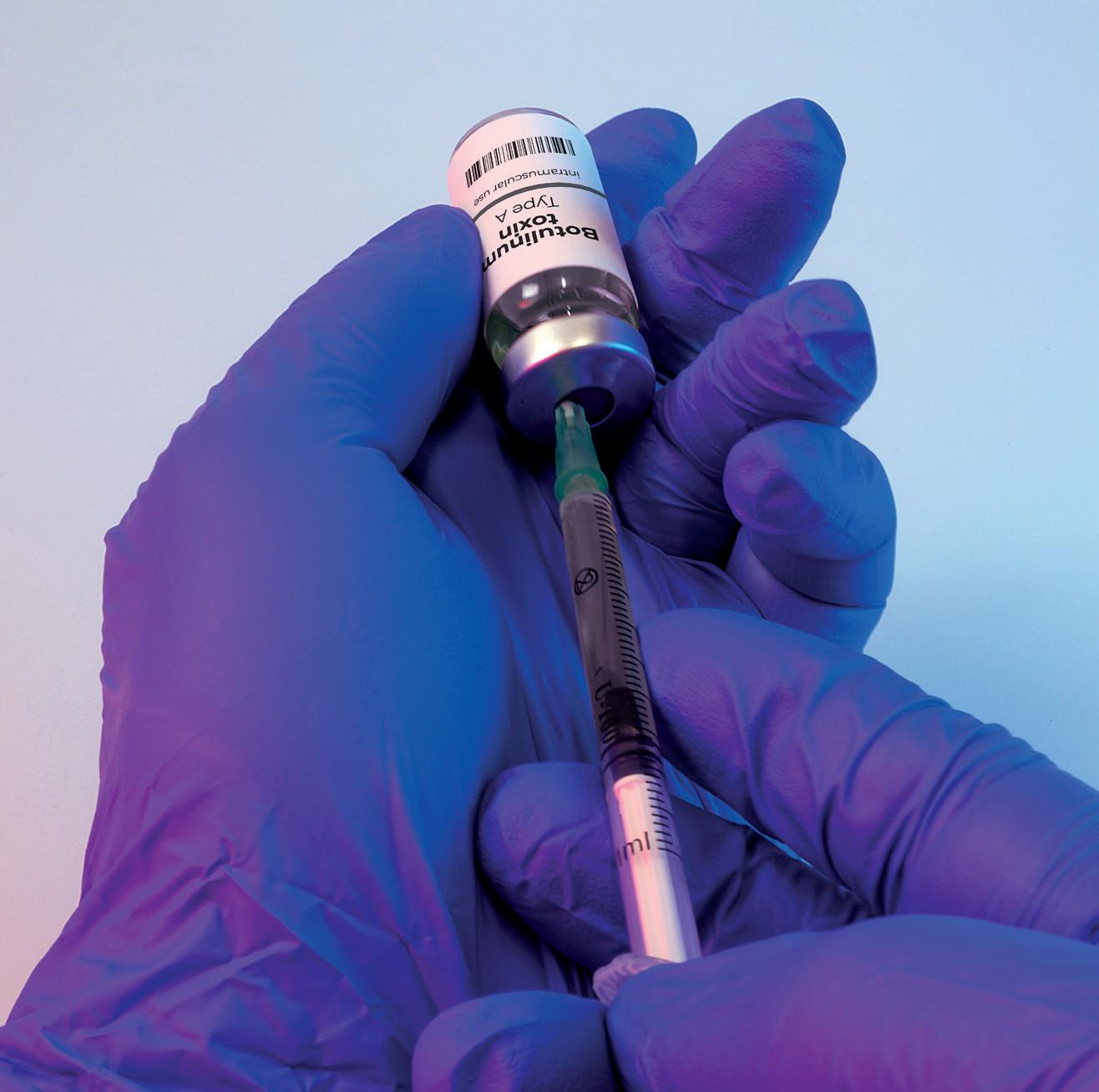
5 years ago, for example, when it seemed they’d do anything to avoid it. Overall, I think we’re still a little behind other areas of the world, and it’s hard to say just where we’re headed, but I think spending on skincare is increasing, and there’s a much more heightened awareness of skincare products.’
Again, thanks in part to the prevalence of social media. ‘A lot of celebrities are talking about skincare and endorsing certain brands, and the awareness of skincare has increased among people of all genders— and it helps that skincare products are now easily available online,’ said Dr Sharad. ‘I think because of the easy accessibility and the awareness things have changed, and the fact that “yes, why shouldn’t I look confident” and “I should look good and my skin should be flawless and it should be radiant.” That’s the current trend, and one of the reasons people are seeking out aesthetic treatments and the market is growing.’
Furthermore, the power of personalised treatment approaches has become the cornerstone of many who practise, which resonates deeply with many patient cohorts looking for natural radiance and beauty.
‘With every decade, the tapestry of aesthetic preferences has undergone a profound transformation, with a definitive shift towards nuanced enhancements that celebrate the uniqueness of each individual,’ said Dr Pai. ‘Treatments like laser hair reduction and treatments for concerns like acne and pigmentation have always been the most sought-after across the country. But it is noteworthy that treatments such as injectables, nonsurgical facelifts, and refined laser resurfacing therapies have assumed centre stage, captivating those who seek to embrace their innate beauty with subtlety and grace.’
prime-journal.com | September/October 2023 ❚ 17 | THE INDIAN AESTHETIC MARKET | INDUSTRY INSIDER
Overall, I think we’re still a little behind other areas of the world, and it’s hard to say just where we’re headed, but I think spending on skincare is increasing, and there’s a much more heightened awareness of skincare products.
References 1. The World Bank. The World Bank In India. New Delhi (India), The World Bank. July 13th 2023. Available at: https://www. worldbank.org/en/country/india/ overview [last accessed 23 August 2023] 2. Prescient & Strategic Intelligence. India Skincare Dermacosmetics Market Research Report. Delhi (India), Prescient & Strategic Intelligence, December 2021. Available at: https://tinyurl. com/2p8ctw93 [last accessed 23 August 2023]
– Dr Mukta Sachdev
Facial analysis is performed by evaluating individual sections and their correlation to the facial canvas.

LOSS OF FACIAL HARMONY A SIDE EFFECT OF HA FILLERS
Chiranjiv Chhabra, MD, explores the concept of facial harmony and what to consider when injecting the face to avoid sub-optimal results
ABSTRACT
Harmony in facial aesthetics is achieved when unity is created between distinct features. Ageing is a physiological result of natural alterations occurring in the underlying anatomical structures and functional units. Multiple tissues arranged in layers play a role in this process; therefore, there is no single universal algorithm
to reverse these changes. While predictable results can be achieved with the use of injectable hyaluronic acid fillers, an incomplete understanding or use of fillers can result in a loss of facial harmony. Early intervention is crucial in the event of undesirable treatment outcomes or loss of facial harmony caused by the incorrect use of dermal fillers. Corrective strategies
THE PERCEPTION OF HARMONY IS varied but may be understood as a pleasing arrangement of a structure’s different segments or fragments.
Harmony in facial aesthetics is achieved when congruence is created by revealing the similarities of distinct parts. Ageing is a physiological consequence of natural alterations occurring in the underlying anatomical structures, and all tissues play a role in this process; therefore, there is no universal algorithm to reverse these changes in an ageing face1. While predictable results can be achieved with the use of injectable fillers (Figures 1–2), inappropriate understanding or use of the fillers can result in a loss of aesthetic harmony.
The earliest evidence of efforts to organise facial symmetry within mathematical templates can be traced back to the Ancient Egyptian era, evolving through the Roman Empire and on to the works of Da Vinci, where the Vitruvian man was described with ideal and mathematically balanced proportions. A landmark theory in this field was the theory of Golden proportions, also referred to as the golden ratio. To this day, researchers continue to believe that the aesthetic qualities of a perfect face are based on the value of 1.618:1, also known as the Divine Proportion2,3 Research indicates
must be implemented promptly, with the primary aim of restoring a natural and balanced appearance. Avoiding and managing the loss of harmony as a consequence of filler treatment requires a multi-layered approach, including preventive measures, patient education, physician education, early intervention, and correction strategies
that the face holds the key to social interactions in many cultures2. Consequently, individuals with attractive faces are often regarded as socially more successful. The concept of facial harmony, which creates a cohesive and aesthetically pleasing appearance, is associated with a sense of serenity, inspires confidence, boosted selfesteem, and overall happiness. Facial analysis is performed by evaluating individual sections and their correlation to the facial canvas. Since ageing creates particular shadows in the upper, mid, and lower face areas, shadows and facial shapes are important in determining a youthful appearance. Anatomically, the soft tissues of the face are organised into five elementary layers, which are bound together by facial ligaments. The retaining ligaments bind the soft tissue layers of the face to the skeletal structures of the face. As the roof of individual soft-tissue space is less supported, it is more susceptible to developing laxity with ageing, causing characteristic changes in the ageing face1 Achieving symmetry and facial harmony are critical features of facial aesthetics. The use of fillers in facial rejuvenation can help address specific issues and improve facial harmony. To achieve optimal facial aesthetic results using fillers, it is essential to have a comprehensive understanding of facial anatomy, ideal proportions, and the effects of ageing on the face. Therefore, this article aims to explore the concept of facial harmony and how dermal fillers can either enhance or detract from it.
Factors in facial harmony
A desire to quantify beauty has existed throughout history, from ancient Greek scholars and Renaissance polymaths to modern-day three-dimensional
CHIRANJIV CHHABRA, MD is a Chief Dermatologist, Medical Director , Alive Wellness Clinics, Delhi, India
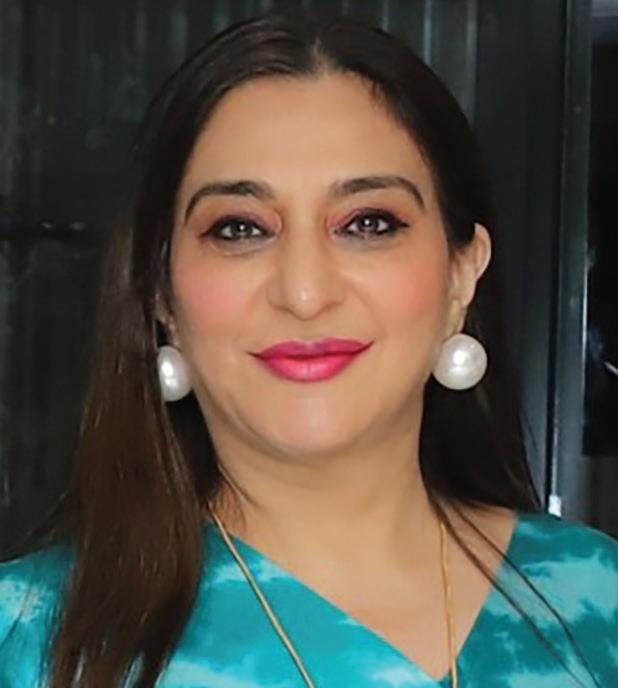
email: chiranjivchhabra@gmail.com
KEYWORDS
Ageing, Dermal Fillers, Facial aesthetics, Facial harmony, Facial Rejuvenation

| INJECTABLES | AESTHETIC FEATURE prime-journal.com | September/October 2023 ❚ 19
techniques. The evolution of these attempts throughout history can be attributed to an increasing preference for an evidence-based approach and has led to the identification of several factors that influence and contribute to facial harmony, such as facial shape, ethnic variations, age-related alterations or preferences, angles, lines, and proportions of the face.
Facial features
Assessing facial features involves evaluating a standard set of facial metrics that vary based on gender, age, and ethnicity. Facial proportions, angles, and contours are variable, but the ancient Greeks described general proportions in Caucasian individuals, which form the basis for assessing facial proportions in clinical practice. These guidelines include the placement and dimensions of different facial components, such as the brow line, eye line, nasal base, and mouth line. The guidelines may be useful for assessing and correcting facial disharmony in aesthetic procedures. While these guidelines mostly apply to Caucasians, they may still provide valuable
guidance for assessing facial harmony in other ethnicities. Gender-specific differences in facial features, such as eyebrow shape, eye size, cheekbones, nose size and shape, and lip size, should also be taken into consideration. According to facial measurements, there are distinct gender differences in various facial features4
Facial proportions
Facial features vary across different ethnicity and genders. One way to assess facial harmony is by dividing the face into three horizontal sections: the upper, middle, and lower thirds. Caucasian faces lean toward a shorter middle third than the upper third, and the middle and upper thirds are shorter than the lower third. In contrast, East Asians often possess a mid-face equal to the lower segment and longer than the upper face. The lower third of the face is usually the largest segment. Males typically have larger upper and lower lips than females, while the vermilion height is similar in both genders. The width of the lips is anticipated to be around 40% of the lower face width, and the measurable space between the medial limb is usually equal to the width of the lips. The ideal shape of the face is oval, with a width-to-height ratio of 3:4.
Figure 1
HA filler 10 ml in temple, upper, middle, and lower face. (A, left) before treatment, (B, right) 2 weeks after treatment

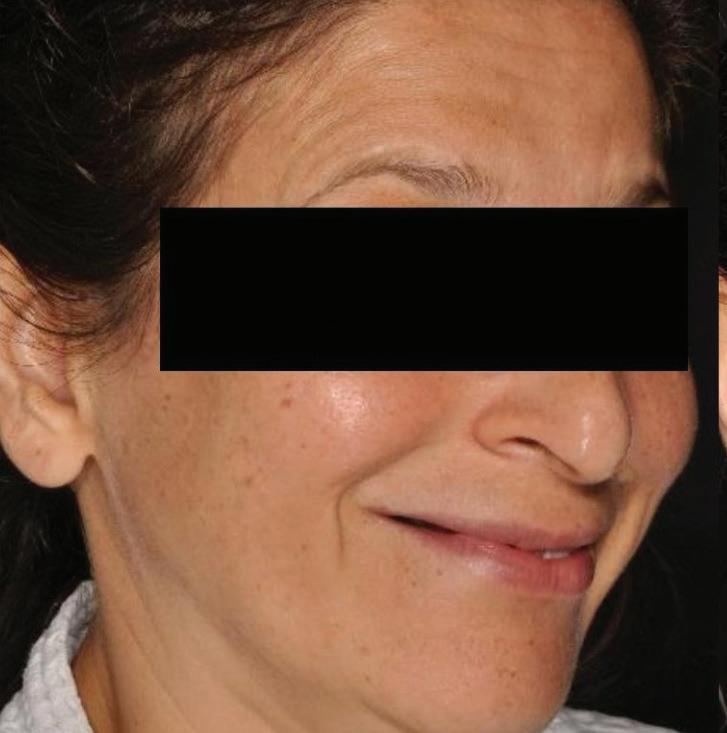
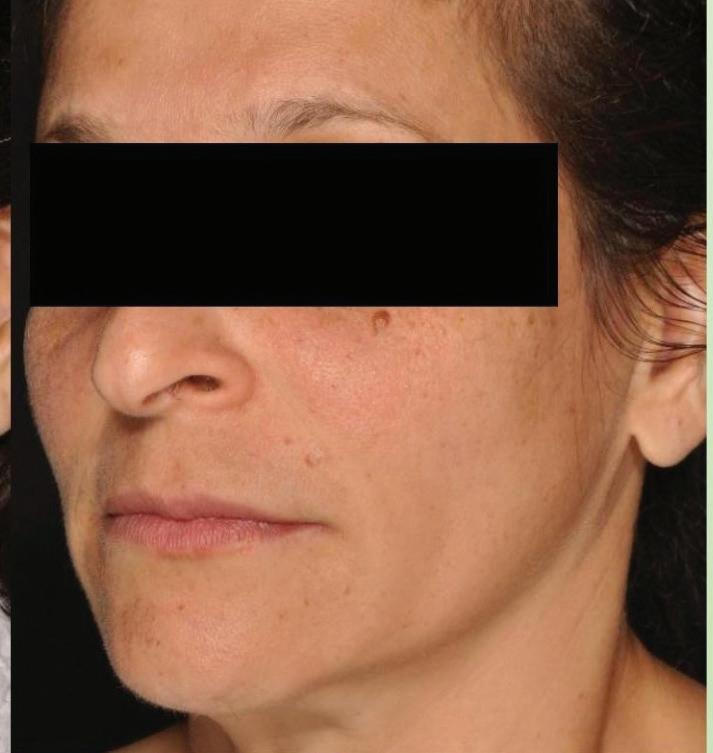


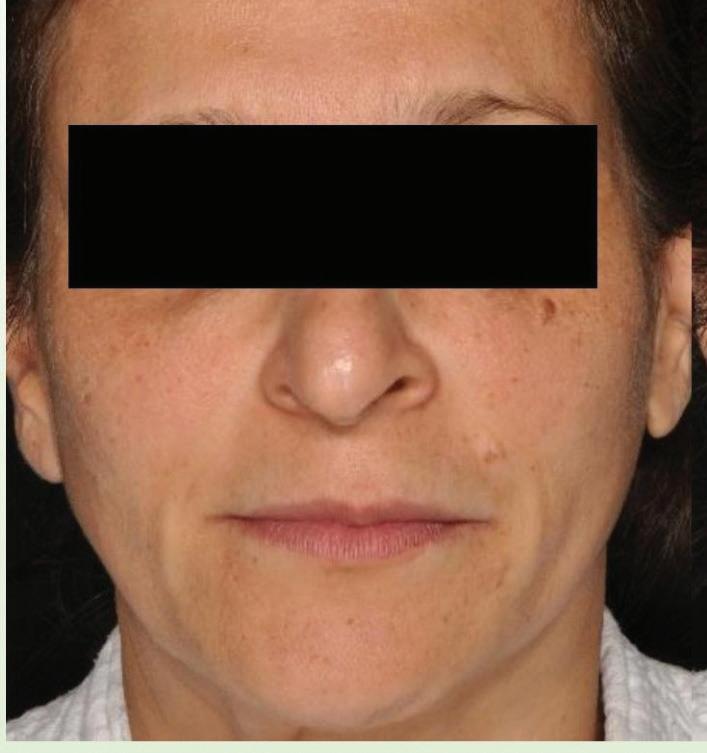
According to the neoclassical standard, the face can be vertically divided into fifths, with each eye, the intercanthal distance, and nasal width measuring one-fifth. However, studies have found variations in these proportions in Caucasian and Asian subjects. Crumley and Lancer describe various ratios, such as the 5:4:3 ratio, for the adequate proportion of the nose and nasal tip. Projection of the nasal tip can also be measured using supplementary parameters, such as the Baum and Simons ratios. The rotation of the nose is designated by the nasolabial angle, but this measurement can be inaccurate if the subject has a protruding maxilla or proclined incisors. A more precise measurement may be carried out with a line perpendicular to the Frankfurt horizontal plane instead of the subnasale to the upper lip line. From the basal view, the nose is divided into thirds, with the columella to the lobule ratio of about 2:1. A narrow nasal tip width is aesthetically preferred, and the ideal nasal tip width ratio varies depending on age and race. The orientation of nasal apertures is usually oriented at an angle of 45-60° to the vertical, with ethnic variations4–6
The golden proportion
The concept of beauty has been studied for centuries, and one recurring theme is the golden ratio. This ratio, denoted by the symbol φ, is approximately 1.618 and is derived from dividing a line in such a way that the ratio of the smaller segment to the larger segment is equal to the ratio of the larger segment to the whole line. It has been associated with aesthetically pleasing features, including in the human face. However, while some researchers have found correlations between facial attractiveness and the golden ratio, others have not. Additionally, a mathematical model based on the golden ratio for ideal facial proportions may not accurately represent the ideal female face. Therefore, while the golden ratio is a significant factor in aesthetics, it should
A A A B
AESTHETIC FEATURE | INJECTABLES | 20 ❚ September/October 2023 | prime-journal.com
B B
not be the only consideration when measuring human beauty2,3
Profile analysis
Various analyses have been developed to quantify and define the harmony of facial profiles by measuring and expressing deviations through quantitative indicators. These analyses describe the normal range of values for morphological and metric parameters, including both angular and linear measurements2,4
Angular analysis
Several angular measurements can be used to describe the harmony of the facial profile (Table 1)2,4
Linear analysis of profile
Evaluating certain profile features often requires using reference lines or planes to determine their position. Non-linear analyses commonly used include the Schwarz tangent-tangent Sn-Pg, which determines the position of the upper and lower lips about the tangent. In a balanced profile, this line should pass through the middle of the pink part of the upper lip and touch the lower lip. Steiner’s S line is also a reference line used in the analysis of facial profiles. It is a tangent that connects the Pogonion and bisects the base of the nose. In an ideal facial profile, this line should touch both the eyes and the lips. Another commonly used analysis is Ricketts’ aesthetic (E) line, which is a tangent (Pg-Prn) connecting the tip of the nose and the tip of the chin. It should be situated 3 mm in front of the upper lip and 2 mm in front of the lower lip to achieve an aesthetically pleasing profile. In addition to these analyses, biometric analysis can also be an important tool for evaluation2,4
Changes associated with ageing
The ageing process of the skin is characterised by the diminishing thickness of the dermis and epidermis, a decrease in elasticity of collagen and dermal layers, and damage caused by sun exposure, resulting in sagging wrinkles and uneven pigmentation. Loss of volume, including fat and bone, as well as weakening of the facial retaining ligaments, are believed to contribute to skin laxity. Additionally, increases in facial strain caused by ageing may exacerbate these changes in appearance.

To achieve optimal facial aesthetics through injectable treatments, the operator must have a deep understanding of facial beauty, anatomy, the ageing process, and ideal proportions. Symmetry and facial harmony are often highlighted as vital elements of facial beauty1, 7, 8
Facial analysis
To achieve facial harmony using fillers, a comprehensive facial analysis should be conducted, considering eight key parameters:
■ The vertical dimension of the face
■ The horizontal balance of the face
■ The depth of tissues
■ The overall quality of tissues
■ Facial symmetry
■ Facial dynamics
■ Ethnicity
■ Gender ideals.
It is important to evaluate factors such as skin type, skin quality, laxity and thickness, photodamage, surface contouring, fat/bony atrophy, and shifts in static and dynamic states7
Causes of filler-induced disharmony
Some drawbacks to filler treatment include the possibility of the physician overfilling or incorrectly placing the product, resulting in an undesirable outcome. This can occur if the physician lacks a comprehensive understanding of facial anatomy, as well as cultural aesthetics and beauty standards, and has received inadequate training. Additionally, some physicians may be overly aggressive in their sales tactics. Common examples of suboptimal outcomes include overfilled tear troughs, excessively full cheeks, an overly prominent projection of the cheeks, and over-correction of the lips. To minimise these issues, it would be beneficial for physicians to understand the anatomy, study beauty ideals across different cultures, and engage in structured, empathetic consultations with their patients.

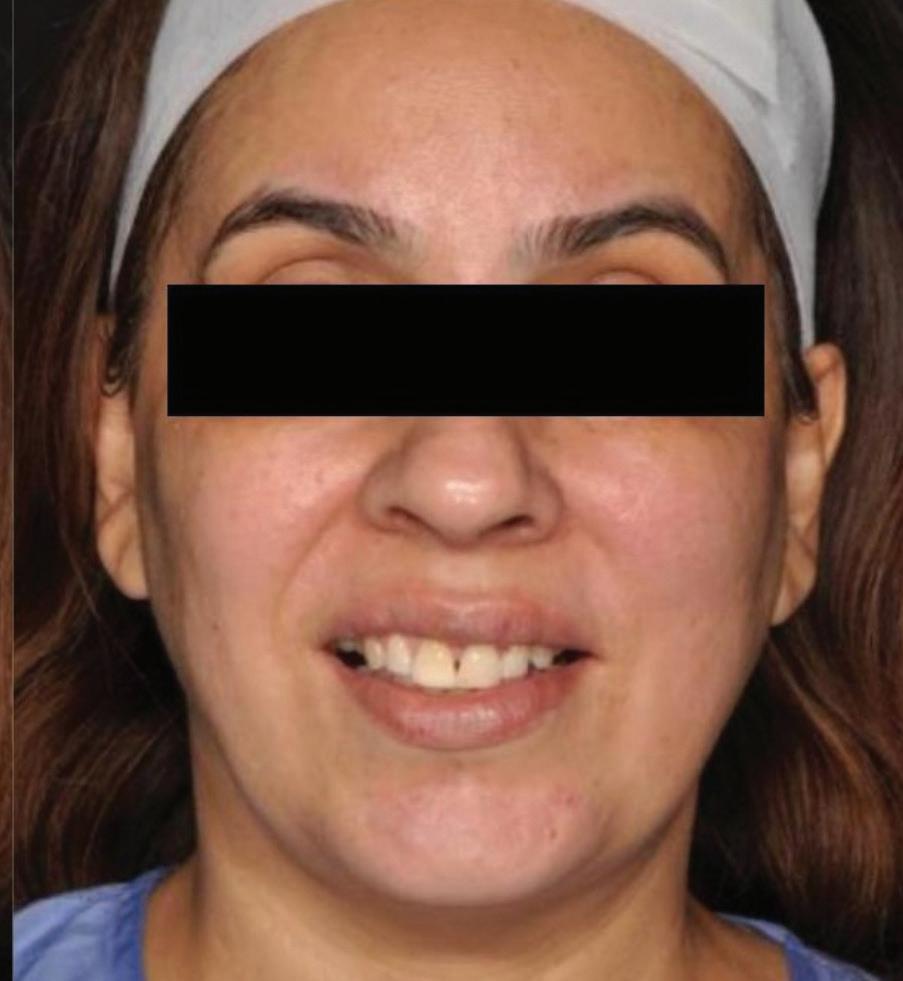

Understanding of facial anatomy
To appropriately understand facial anatomy concerning filler injections, it is imperative to view it as a 4-D
Figure 2 HA filler in middle and lower face. (A, left) before treatment, (B, right) after treatment.
A A B B | INJECTABLES | AESTHETIC FEATURE prime-journal.com | September/October 2023 ❚ 21
To achieve optimal facial aesthetics using fillers, it is essential to have a comprehensive understanding of facial anatomy, ideal proportions, and the effects of ageing on the face.
Table
11. Mentocervical Angle Tangent connecting the Prn and -120ÿ. the Pg, intersecting the mental tangent
12. Cervicomental Angle Tangent to the submentum and the 121 ÿ
tangent to the neck passing through SC
13. Merrifield’s Z-angle The tangent line between Pg’, the 8 -90ÿ (78ÿ for ages most prominent point of the upper 11-15yrs) or lower lip, and the Frankfurt horizontal
Cephalometric points. G: Glabella; Prn: Pronasale; Pg: Pogonion; Sn: Subnasale; N: Nasion; Cm: columella; Ls: Labrale superius; Li: Labrale inferius; C: Cervical point
construct, including dynamic outcomes. The subsequent paragraphs discuss the structural relationships within facial anatomy that require consideration when administering fillers. While the sections are divided into thirds for organisation, it’s important to recognise that these regions are interconnected and that filler treatment in one area can impact another area7, 9
It is imperative to understand that overenthusiastic filler deposition in the tissue planes results in compression of the vasculature and obstructs lymphatic drainage. The use of a cannula or perpendicular needle
injections can help avoid these vessels. For example, the supratrochlear and supraorbital arteries in the forehead region have a rich anatomising network that becomes more superficial towards the hairline. In the glabellar region, fillers should be injected superficially and medially to avoid the supratrochlear artery and the deeper and lateral supraorbital artery. Low-concentration and medium particle HA gels should be used, and undertreatment is essential to prevent lymphatic blockage, which can cause chronic lower lid oedema.
It’s important to note that the male temple is flatter, while the female temple has a slight depression. Therefore, female temples should not be overfilled, and the posterior aspect of the temple should be filled to result in a fuller appearance than the anterior aspect7, 9, 10
Injection techniques
The technique used for filler injections depends on a number of factors, such as the location, indication, type of filler, needle size, and the injector’s experience. Some of the commonly used techniques include fanning, linear threading, cross-hatching, layering, and depot injection. Some additional techniques used for injections are skin boosting for treating superficial wrinkles, linear periosteal threading for emphasising bony contours, and both trans-cutaneous and intraoral methods for lip augmentation via the mucosa.
To ensure safety and control during injections, it is recommended to inject no more than 0.05-0.2 cm3 per injection point, regardless of the technique used. It is also important to use cannulae and small-bore needles as they can aid in better outcomes. Aspiration before injection for at least 6 seconds can also prevent intravascular injections; however, this is no substitute for a thorough knowledge of anatomy.
When treating the glabellar region, it is important to use small boluses injected relatively superficially with moderate pressure. Injection should be stopped if blanching occurs to prevent ischaemic necrosis. Linear threading and serial puncture techniques are often useful in this area. Over-correction can lead to animation changes or lumps and must therefore be avoided. It is important to discuss the natural asymmetry of the nasolabial folds with the patient beforehand, followed by the use of linear threading or fern technique in this region.
When considering lip augmentation, the shape and proportion of the lips should be assessed, with the lower lip protruding slightly beyond the upper lip and the upper lip being two-thirds the volume of the lower lip (Asian beauty ideals suggest a 1:1 ratio between the upper to lower lips). A linear threading technique is commonly used for volume augmentation, while a microdroplet technique is rarely used for injections near the submucosal area.
In cases requiring periocular fillers, depot injection at the periosteal level is the preferred technique as it ensures long-lasting results. However, oedema and bruising are common adverse effects in this region. It is crucial to avoid placement of the filler extremely
SR. ANGLE LANDMARKS AVERAGE VALUES NO. MALES FEMALES 1. Total Facial G - Prn - Pg 7.9ÿ 7.9ÿ Convexity Angle 4.421 .77 2. Facial Convexity G – Sn - Pg 165.22ÿ 65.63ÿ Angle 5 .5 Alternatively - The angle between lines 12 4ÿ G - Sn and Sn - Pg 3. Nasofrontal Angle GN and Nd 7ÿ 136.32ÿ 7.548 6 4. Nasolabial Angle Cm-Sn-Ls 9ÿ 85.05ÿ 12.52 .93 5. Mentolabial Li-Sn-Pg 116.91ÿ 123.66ÿ Sulcus Angle 14.604ÿ 15.108ÿ 6. Nose Type Angle N-Prn-Cm 7.9ÿ 70.34ÿ 6.744 3.75 7. Nasomental Angle Prn N-Pg 3.69ÿ 32.49ÿ 3.268 3.8 8. Projection of the Ls –N – Pg 9.3ÿ 9.06ÿ Upper Lip on the Chin 2.399 0.36 9. The Angle of Li – N – Pg 0.7 ÿ 4.93ÿ Projection of the 1.445 .865 Lower Lip on the Chin 10. Upper Lip Angle Ls - Sn - Pg 19.67ÿ 8.7 ÿ 5.99 7.971
6 ÿ
AESTHETIC FEATURE | INJECTABLES | 22 ❚ September/October 2023 | prime-journal.com
1 Angular measurements used to describe the harmony of the facial profile
superficially or in individuals with thin skin, as this may lead to the appearance of pale nodules owing to the Tyndall effect. Injection in the periocular area should only be performed by a skilled and experienced injector due to the potential for serious side effects such as blindness7, 9, 11-15

Considerations when selecting a filler
Fillers may be classified according to the following criteria:
■ Crosslinking
■ Physical characteristics
■ Elasticity
■ Viscosity
■ Cohesiveness
■ Flexibility
■ Particle size.
These factors, along with the patient’s anatomy and tissue quality, influence the appropriate filler selection to ensure predictable outcomes. The complex G* modulus aids in the assessment of filler stiffness or resistance to deformation of a filler. Fillers having a low G* value are indicated for restoring shallow areas, while those with a high G* value are indicated for injection into deeper layers resulting in a volumising effect. The site of treatment and the desired outcome dictate the choice of filler.
The elastic modulus represented with a G′ indicates the material’s compression resistance. Whereas filler viscosity, denoted by n*, indicates the force required to extrude the material from the needle or cannula. However, unlike G*, G’ does not significantly impact the post-injection behaviour of the filler material. The cohesiveness of the filler denotes adhesion among the crosslinked molecules of HA. Low cohesiveness indicates an increased tendency to spread among fillers, whereas higher values ensure the structural integrity of the filler material; thereby making low and high cohesive fillers suitable for injection in superficial and deeper layers, respectively.
Finally, the flexibility of filler material denoted by strain modulus is indicative of the filler’s capacity to stretch and regress to its initial shape. The flexibility inversely correlates with G’ moduli, and fillers with high flexibility are better suited for dynamic anatomical regions of the face, such as the perioral region.
HA-based fillers are the most commonly used today. HA is a naturally occurring compound in the human body that affords structure, volume, and moisture to the skin. The concentration of HA in the skin decreases with age, contributing to wrinkle formation. The mechanism of HA-based fillers is water sorption resulting in an increase in volume and support for softtissue defects. The durability of HA fillers is variable with the type and percentage of cross-linking among molecules, the patient’s
metabolism, and the site of injection.
Polymethylmethacrylate (PMMA), Poly L-Lactic acid (PLLA), and calcium hydroxyapatite are durable, non-HAbased fillers that attain volumisation using biostimulatory mechanisms. PMMA and PLLA comprise polymer microspheres which have a stimulatory effect on collagen production over 3 months. Calcium hydroxyapatite, a natural compound in bones and teeth, also encourages collagen formation7,
Patient factors
Numerous patient aspects can lead to negative outcomes with filler treatments. These include the patient’s motivation, expectations, and desires; the influence of media in the rampant promotion of stereotypical and unrealistic beauty standards; and a casual approach towards cosmetic procedures, such as physician hopping. Patients strongly influenced by the media and the latest trends may aspire to achieve celebrity looks or follow prevalent beauty standards, leading to a loss of facial harmony. Patients with facial dysmorphia may also seek out different physicians and undergo multiple treatments to achieve a socially-acceptable or desired appearance, further increasing the risk of negative outcomes. It is important for patients to have realistic expectations and to carefully choose a qualified and experienced physician to ensure positive treatment outcomes8,16
Clinical features
Distortion of facial features caused by improper filler treatment presents as the following clinical features:
Irregularities or lumps
Asymmetry or disproportionate facial features
Exaggerated features
Loss of facial expression or movement
Unnatural or ‘scary’ appearance.
Deposition of fillers too high and superior to the orbicularis oris ligament or too superficially under the skin can cause swelling under the eyes resulting from water sorption. ‘Sunset eyes’ result from an excessive filler deposition around the eyes, leading to a drooping
Non-surgical augmentation of the nose using fillers is a popular procedure, but if overdone can yield unnatural results, especially in the region of the bridge of the nose. This leads to a disproportionate nose with a sharp tip and a straight dorsum. Excessive filler injected in the bridge of the nose may negatively impact the nasofrontal angle, consequently causing the nose bridge to appear unnaturally high and broad18
A ‘flying saucer face’ or ‘pillow face’ appearance may result from over-filled cheeks and undereye areas. While fuller cheeks are usually associated with a youthful appearance, overfilling or puffy cheeks may not agree with the individual’s age and may give an unnatural appearance.
Aestheticians may create an ‘apple cheek appearance’, which often
9, 11, 14, 15
| INJECTABLES | AESTHETIC FEATURE prime-journal.com | September/October 2023 ❚ 23
Deposition of fillers too high and superior to the orbicularis oris ligament or
Since ageing occurs as a result of natural alterations in the skin’s underlying anatomical structures and functional units, it cannot be reversed by using a single universal algorithm.
Corrective strategies must be implemented promptly
Avoiding and managing the loss of harmony requires a multi-layered approach, including preventive measures, patient education, physician education, early intervention, and correction strategies
Various factors like understanding facial features, facial proportions, golden proportions, profile analysis cumulatively play a significant role in creating harmony in a patient’s facial features
Correct injection techniques, right choice of fillers, understanding patient expectations and correctly aligning physician’s plan is mandatory to create perfect facial harmony
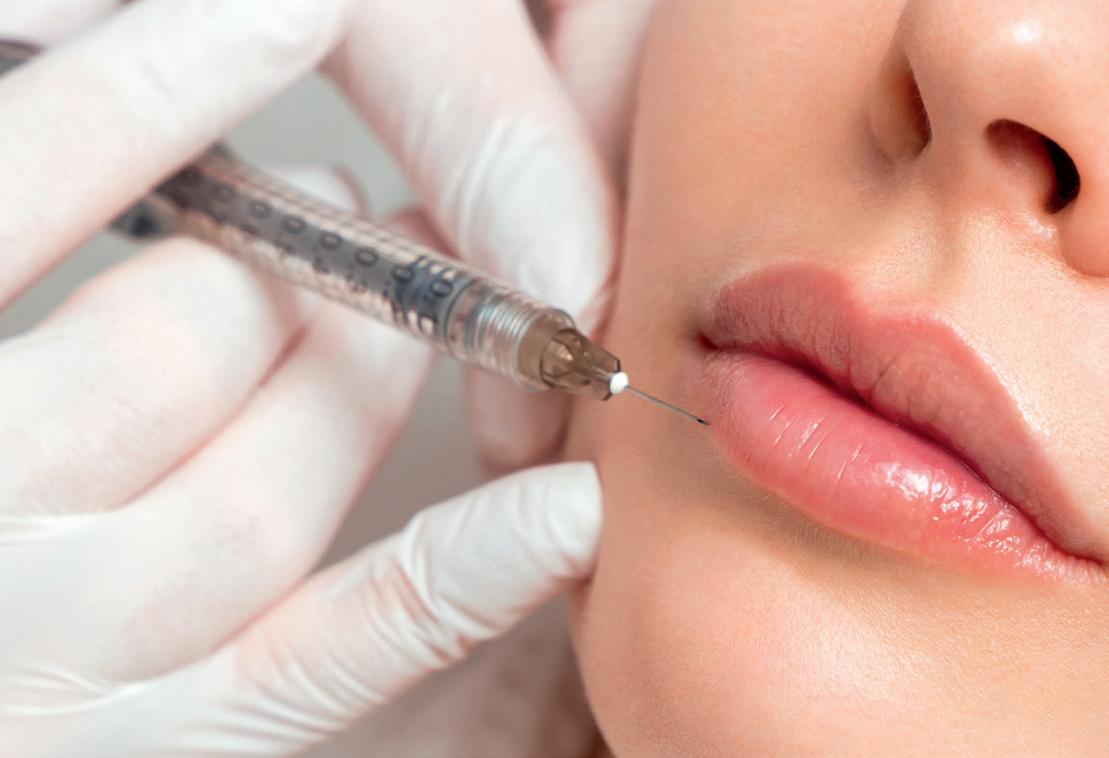
contributes to this syndrome. The overzealously filled cheeks and under-eye area destroy the natural lid-cheek junction, resulting in a mid-face that appears pillow-like with a continuous bulge, causing the eyes to appear smaller19
The injection of fillers defines a patient’s cheekbones, similar to contouring makeup. However, overdone cheeks cause the cheekbones to protrude excessively, resulting in a distorted appearance referred to as ‘chipmunk cheeks’20
‘Duck lips’ or ‘sausage lips’ result from overfilled lips. Since the filler improves appearance by inflating the lip tissue, excessive or improperly placed filler may cause the lips to become plump and lose their natural appearance. The excess filler weighs down the lips, causing them to droop and flatten out, resembling a duck’s bill or a sausage. The stretched-out lip tissue may also sag over time, requiring even more filler in future treatments17, 20
Over-injecting fillers in the chin region can result in an exaggerated or pointed appearance that resembles a witch’s chin. While a well-contoured chin helps to create a more balanced, V-shaped face, over-prominence can lead to an unnatural appearance. Excessive fillers on the forehead eliminate the natural contours, eyebrow ridges and flatness or depressions in the temple region leading to an unnatural appearance referred to as ‘flowerhorn forehead’17
The vital elements when attaining optimal treatment outcomes with the use of filler include:
■ Comprehensive knowledge of facial anatomy and its correlation with the overall appearance
■ Patient counselling, education, and assessment
■ Selecting the right filler for the specific treatment area and depth
■ Management of complications or untoward effects.
References
1. Fitzgerald R, Carqueville J, Yang PT. An approach to structural facial rejuvenation with fillers in women. Int J Womens Dermatol. 2018;5(1):52-67.
2. Perović, Tatjana. Harmony and aesthetics of facial profile. Glasnik Antropoloskog drustva Srbije. 2018; 53:107-117.
3. Harrar H, Myers S, Ghanem AM. Art or Science? An Evidence-Based Approach to Human Facial Beauty a Quantitative Analysis Towards an Informed Clinical Aesthetic Practice. Aesthetic Plast Surg. 2018;42(1):137-146.
4. P. M. Prendergast, “Facial proportions,” in Advanced Surgical Facial Rejuvenation: Art and Clinical Practice,Ed. by A. Erian and M. A. Shiffman (Springer, Berlin,Heidelberg, 2012), pp. 15–22.
5. Bashour M. History and current concepts in the analysis of facial attractiveness. Plast Reconstr Surg. 2006;118(3):741-56.
6. Nokovitch L, Panico U, Deneuve S. The Educational Role of Artistic Anatomy in Facial Plastic Surgery. Aesthet Surg J. 2021;41(7):NP996-NP999.
7. Akinbiyi T, Othman S, Familusi O, Calvert C, Card EB, Percec I. Better Results in Facial Rejuvenation with Fillers. Plast Reconstr Surg Glob Open. 2020;8(10):e2763.
8. Fakih N, Bertossi D, Vent J. The Overfilled Face. Facial Plast Surg. 2022;38(2):173-176.
9. Lipko-Godlewska S, Bolanča Ž, Kalinová L, Kermen I, Onisak B, Papp I, Rebrov M, Valančienė G. Whole-Face Approach with Hyaluronic Acid Fillers. Clin Cosmet Investig Dermatol. 2021;14:169-178.
10. Funt D, Pavicic T. Dermal fillers in aesthetics: an overview of adverse events and treatment approaches. Clin Cosmet Investig Dermatol. 2013;6:295-316.
In the event of undesirable treatment outcomes or loss of facial harmony caused by the injudicious use of dermal fillers, early intervention is of crucial importance. Corrective strategies need to be implemented promptly, with the primary aim of restoring a natural and balanced appearance. The use of hyaluronidase enzyme, which can break-down HA molecules, may aid the dissolution of the excess filler and may partially restore the former appearance. However, this approach has its risks and limitations, which must be discussed with the patient in detail.
Conclusion
Preventing further damage to the facial appearance is essential and may be accomplished with the use of an appropriate filler for the specific concern and depth; possessing a thorough understanding of facial anatomy and the impact of anatomical units on the whole face; and proper counselling, education, and assessment of patients before the treatment. Devoting time to align patients’ expectations and moulding the attitudes of patients towards mindful concepts of aesthetics can also encourage positive outcomes and minimise future complications16. In summary, managing the loss of harmony due to filler treatment requires a multi-layered approach, including early intervention, correction strategies, prevention measures, and patient education.
Declaration of interest
None
11. Sánchez-Carpintero I, Candelas D, Ruiz-Rodríguez R. Materiales de relleno: tipos, indicaciones y complicaciones [Dermal fillers: types, indications, and complications]. Actas Dermosifiliogr. 2010;101(5):38193.
12. Oranges CM, Brucato D, Schaefer DJ, Kalbermatten DF, Harder Y. Complications of Nonpermanent Facial Fillers: A Systematic Review. Plast Reconstr Surg Glob Open. 2021;9(10):e3851.
13. Chiang YZ, Pierone G, Al-Niaimi F. Dermal fillers: pathophysiology, prevention and treatment of complications. J Eur Acad Dermatol Venereol. 2017;31(3):405-413.
14. Vedamurthy M, Vedamurthy A. Dermal fillers: tips to achieve successful outcomes. J Cutan Aesthet Surg. 2008;1(2):64-7.
15. Sherman RN. Avoiding dermal filler complications. Clin Dermatol. 2009;27:S23–32.
16. Laughter MR, Anderson JB, Maymone MBC, Kroumpouzos G. Psychology of aesthetics: Beauty, social media, and body dysmorphic disorder. Clin Dermatol. 2023 Mar 5:S0738-081X(23)00029-9.
17. Lim TS. Facial overfilled syndrome complications of inappropriate filler delivery. International journal of aesthetic and antiageing medicine. 2018;1-11.
18. Jung GS. Filler rhinoplasty based on anatomy: The dual plane technique. JPRAS Open. 2019 ;20:94-100.
19. Cotofana S, Gotkin RH, Frank K, Lachman N, Schenck TL. Anatomy Behind the Facial Overfilled Syndrome: The Transverse Facial Septum. Dermatol Surg. 2020;46(8):e16-e22.
Figures 1–2, Table 1 © Chiranjiv Chhabra
20. Ramirez O. Treating the aging face: “high-definition—high-tech” comprehensive facial rejuvenation. MKG-Chirurg. 2019;12:68–77.
AESTHETIC FEATURE | INJECTABLES | 24 ❚ September/October 2023 | prime-journal.com
Key points Devoting time to align patients’ expectations and moulding the attitudes of patients towards mindful concepts of aesthetics can also encourage positive outcomes and minimise future complications.
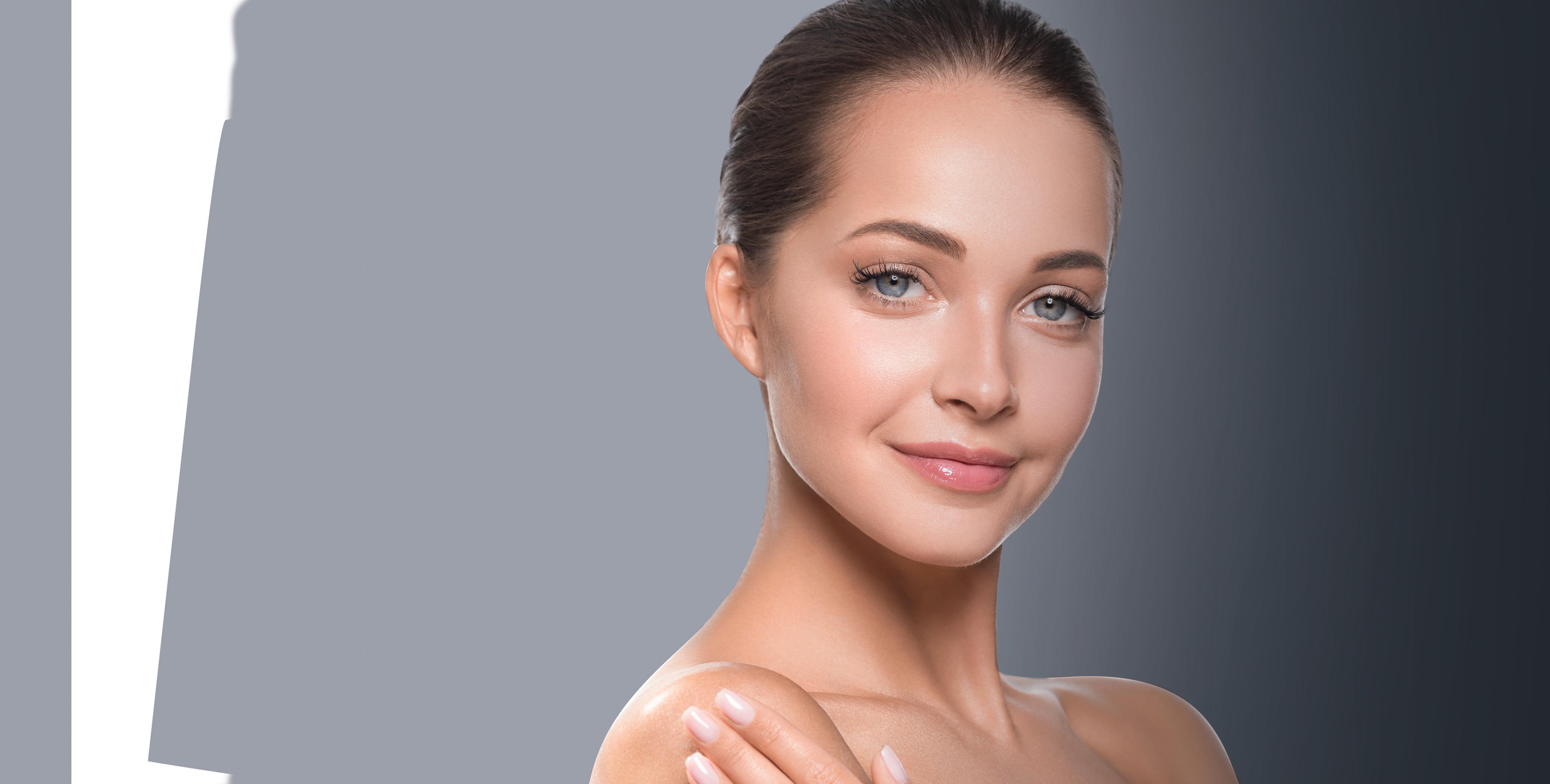

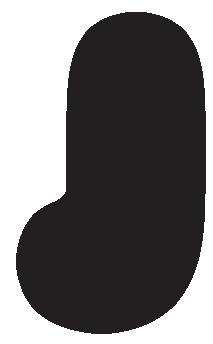


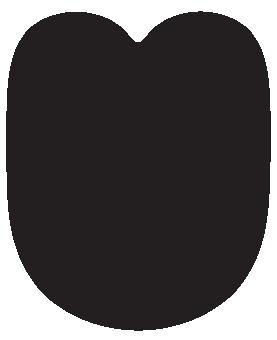



Although temporal hollowing significantly contributes to the appearance of an ageing face, many practitioners overlook it as a primary aesthetic concern.


AESTHETIC FEATURE | INJECTABLES |
TEMPORAL HOLLOW AUGMENTATION USING HYALURONIC ACID FILLERS
Jamuna Pai, MD, discusses how best to restore volume and contour to the temporal hollows and address a common sign of facial ageing


ABSTRACT
Temporal hollowing is a common sign of facial ageing which make the brows appear short and the upper face look narrow contributing to the inversion of beauty triangle. Restoring volume and contour in the temporal hollows is an efficacious way to achieve a harmonious, balanced and proportionate look to restore youthful features. New age HA fillers have transformed the aesthetic field making them the most sought after treatment to achieve a smooth, youthful, three-dimensional look with a minimal invasive approach and almost no downtime with minimal complications. Though injecting fillers in the temporal area is a relatively less common indication, this article discusses the approach to treat them to attain a more aesthetic appearance.
THERE ARE A HOST OF FACTORS THAT affect ageing and lead to wrinkles and sagging skin. Gravitational pull, weight loss, photodamage, hormonal changes, smoking, and poor lifestyle habits all accelerate the deterioration and descent of cutaneous facial structures. Along with these changes, skeletal remodelling and subcutaneous fat redistribution and loss are also recognised as key elements responsible for the appearance of an ageing face1. A study conducted by Rohrich & Pessa2 suggests that the subcutaneous fat is partitioned into multiple, independent anatomical compartments, which can age independently and result in abrupt contour changes between them.
Reviewing the anatomy of the face, we find three distinct cheek fat compartments: the medial, middle, and lateral-temporal. The lateral-temporal fat is the most lateral compartment of cheek fat and lies immediately superficial to the parotid gland. It connects the temporal fat to the cervical subcutaneous fat, and the lateral cheek septum can be located anterior to this compartment2 Descent and deterioration of this fat compartment and the septum contribute to temporal hollowing. This loss of volume can result in a gaunt, wasted appearance contributing to the inversion of the beauty triangle. One solution is to augment the temporal hollows using hyaluronic acid (HA) soft tissue fillers, which replace lost volume to achieve a more balanced and youthful appearance3
Although temporal hollowing significantly contributes to the appearance of an ageing face, it is overlooked as a primary aesthetic concern by many practitioners. The following patients were selected for temporal hollow augmentation using HA soft tissue fillers. A thorough
KEYWORDS Ageing, dermal fillers, temporal hollowing, hyaluronic acid

| INJECTABLES | AESTHETIC FEATURE prime-journal.com | September/October 2023 ❚ 27
JAMUNA PAI, MD is a Dermatologist/Cosmetic Physician, Skin Lab, Mumbai, India
email: jamunabpai@gmail.com
facial analysis and consultation was conducted to identify the nature of the hollowing and whether it was the result of ageing, weight loss or a genetic predisposition. A pre-treatment photograph was recorded, and the informed consent was signed by all the patients being treated.

Patients and filler selection
Patient 1: A 45-year-old air hostess presented with temporal hollowing, which looked more pronounced when her hair was swept back. Further facial assessment indicated that her right side showed more volume loss than the left.
Patient 2: A 38-year-old fashion designer, earlier treated
for mid-face hollowing, presented with volume deficit in the temporal region that, on further investigation, was revealed to be a familial trait.
Patient 3: A 41-year-old doctor noticed hollowing in her temporal area following weight loss.
To address the deficit noticed in the temporal fossa, a soft tissue filler that achieves a greater degree of lifting while at the same time providing an optimal balance of longevity and ease of injection is ideal. Juvederm Voluma with Lidocaine (Allergan Aesthetics, Irvine, CA, USA) was selected as the preferred HA-based soft tissue filler as it conformed to these properties. Another property of soft tissue fillers that practitioners look for is their gel hardness or G (G Prime) value. G is a measurement of gel hardness and is obtained by measuring the lateral force of two plates on the soft tissue filler material. The greater the resistance, the greater the elastic modulus or G 4. Rohrich et al. suggest that HA soft tissue fillers with a greater G value are capable of giving a higher degree of lifting effect to achieve maximum anterior projection with a limited
1600 1400 1200 1000 800 600 400 200 0 G Prime (Pa) Radiesse Restylane SubQ 863 Radiesse plus 0.3% lidocaine 554 Perlane 531 Restylane 513 Juvederm Voluma 274 Juvederm Ultra Plus 74 Juvederm Ultra 28 1407
To address the deficit noticed in the temporal fossa, a soft tissue filler that achieves a greater degree of lifting while at the same time providing an optimal balance of longevity and ease of injection is ideal.
AESTHETIC FEATURE | INJECTABLES | 28 ❚ September/October 2023 | prime-journal.com
Table 1 G Prime values of a number of fillers 6
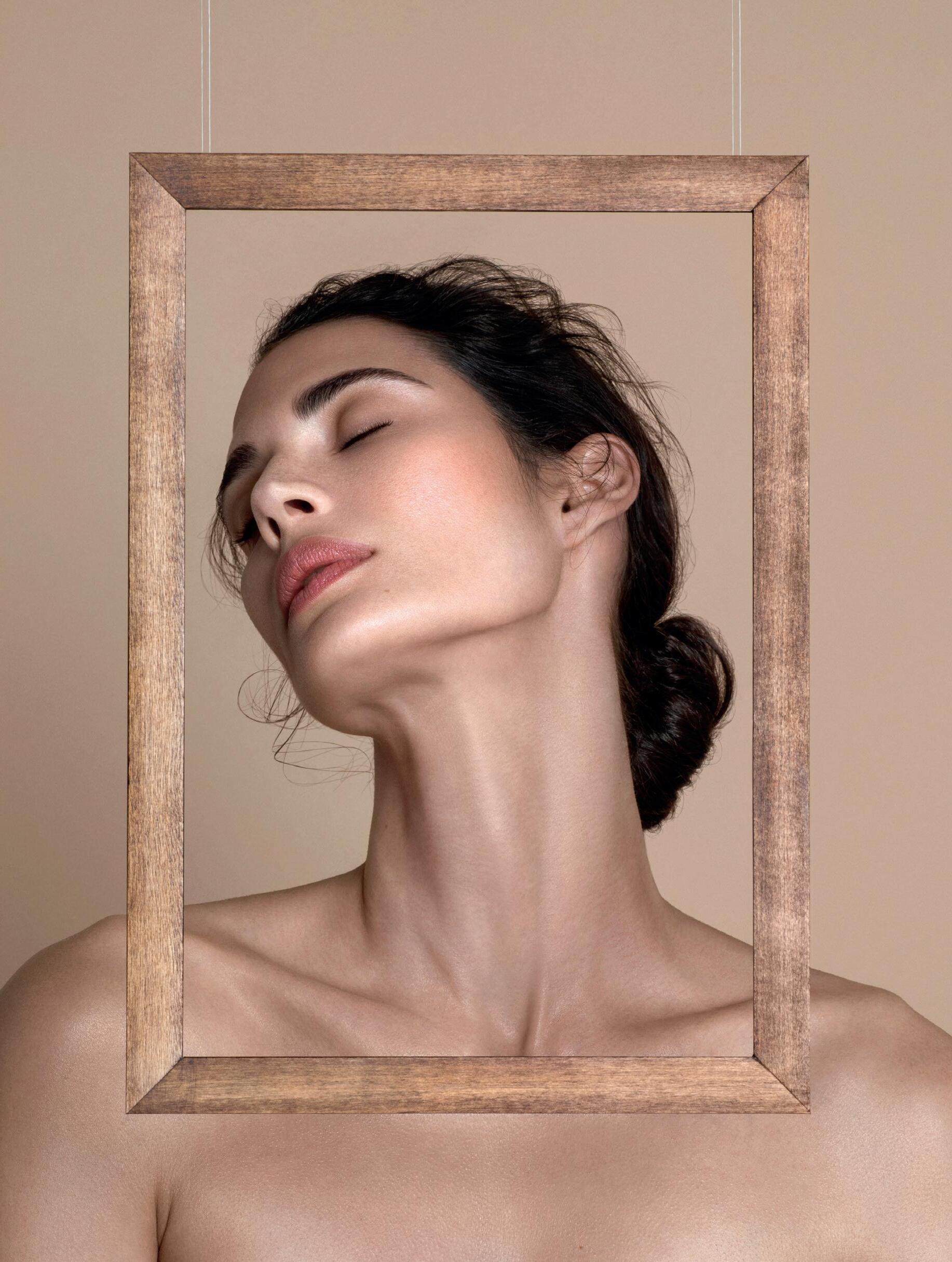
quantity of the soft tissue filler material2. Juvederm
Voluma with Lidocaine (Allergan Aesthetics) has a higher degree of cross-linking but a lower G value than some other fillers such as Radiesse (Merz Aesthetics, Raleigh, NC, USA), Restylane and Perlane (Galderma, Zug, Switzerland)5, as shown in Table 16; however, simply relying on one factor to determine lifting capacity is
A B
A B
inaccurate and it is rather a complex interaction between G, cohesivity, viscosity, and cross-linking that bring about the desired lifting effect7. The degree of cross-linking in HA increases the viscosity and reduces free radical and enzymatic degradation. Therefore the more cross-linked the filler, the more viscosity and cohesivity, thus giving a sustained dermal lift8
Method
A thorough cleansing of the treatment site was performed prior to the injection for all three patients. This minimises the risk of complications such as biofilm. The treatment area was marked as shown in Figure 1. The temporal fusion line was marked as the upper border, the hair implantation line as the posterior border, the superior border of the zygomatic arch as the lower border, and the lateral orbital rim as the anterior border. The temporal hollow formed an oblong rectangle, which was further divided into four smaller quadrants. It is usually witnessed that the deepest area is lateral to the orbit and above the arch. Selecting this site to deposit the filler gives the best outcome, and this area is free of pulsation, indicating an absence of vasculature.
Patient 1
Using a 27 gauge, 0.5-inch needle, 1 ml of Juvederm Voluma with Lidocaine was injected on each side in a ‘gun-shot’ technique (deep supra-periosteal bolus). The material was injected after careful palpation to avoid the frontal branch of the superficial temporal artery and vein. The treatment site was aspirated before depositing the filler material. The thumb of the non-dominant hand was used to prevent product migration towards the hairline. The needle was withdrawn very slowly to prevent any bruising. The product was moulded to avoid any lumps and achieve a smooth contour. The discomfort was minimal due to the in-built lidocaine. Immediate results were visible post-treatment (Figure 2).





Patient 2
Since the temporal hollows were deep, 1 ml of Juvederm Voluma with Lidocaine was injected on either side. After identifying the temporal artery and vein, the area of greatest volume loss was located. The needle was positioned 1 cm posterior to the orbital rim and 1 cm inferior to the temporal suture line. Using a 27 G, 0.5-inch needle, a bolus of 1 ml of the filler material was injected into the antero-superior quadrant. The same technique was repeated on the other side (Figure 3).
Patient 3
This patient presented with deep hollows in the temporal region; however, due to budget constraints, 0.5 ml of Juvederm Voluma with Lidocaine was injected on each side instead of 1 ml. A bolus was injected on the periosteum, deep to the deep temporal fascia, as in the previous two cases. As seen in Figure 4, the patient’s posttreatment pictures show a change; however, the hollowing persisted posterior to the injection point. After 2 weeks the patient called back, and a further 0.5 ml of
Figure 2 Patient 1 (A) pre and (B) post treatment
Figure 3 Patient 2 (A) pre and (B) post treatment
AESTHETIC FEATURE | INJECTABLES | 30 ❚ September/October 2023 | prime-journal.com
Figure 1 Marking of temporal hollows for augmentation with soft tissue fillers
A B C
the filler material was injected on either side. Using a 25G, 0.5-inch needle, a pilot entry point was made in the centre of the zygomatic arch, mid-way between the outer canthus and the tragus. Using a 27G, 38 mm cannula, a deep subcutaneous plane was sought, and the filler material was placed in the hollow using a fanning technique and moulded in place. The results were far superior and visually satisfying, as seen in the 2 ml posttreatment image in Figure 4
Conclusion
In conclusion, a systematic and customised treatment approach must be considered while treating facial temporal hollows. Initial facial analysis and assessment to correctly identify the nature and type of hollowing to be treated, pre and post-photographs for documentation and recording results, injecting technique, and selecting the correct soft tissue filler that will offer the right balance of longevity and lifting are of utmost importance to achieve superior results. Compromising on the amount of filler being deposited will not bring about the desired volumisation and lift. A patient on a limited budget must be counselled with regard to the downside of undertreatment.
Also of equal importance is the understanding of the underlying facial anatomy. The presence of the anterior branch of the superficial temporal artery, in addition to the nerves and veins, presents a risk in treating this area. An intravascular injection could cause tissue necrosis
and, in some cases, even embolisation of the product, which could lead to blindness. A superficial injection in this region is low risk; however, it can cause engorgement of the blood vessels due to the pressure of the soft tissue filler material. Therefore, if one carefully palpates the temporal artery and avoids it, injecting deep into the supra-periosteal plane is found to be the safest technique for temporal hollow augmentation.
Declaration of interest None
Figures 1–4 © Jamuna Pai
Table 1 © Jamuna Pai
References
1. Coleman, S. and Grover, R. (2006). The anatomy of the aging face: Volume loss and changes in 3-dimensional topography. Aesthetic Surgery Journal, 26(1), pp.S4-S9.
2. Rohrich, R. and Pessa, J. (2007). The Fat Compartments of the Face: Anatomy and Clinical Implications for Cosmetic Surgery. Plastic and Reconstructive Surgery, 119(7), pp.2219-2227.
3. Carruthers, J. (2010). Commentary: Novel Hyaluronic Acid Dermal Filler: Dermal Gel Extra Physical Properties and Clinical Outcomes. Dermatologic Surgery, 36(Suppl 3), p. 1842.



4. Baumann, L. (2008). Hyaluronic acid gel preparations in the treatment of facial wrinkles and folds. Clinical Interventions in Aging, Volume 3, pp.629-634.
5. Sundaram, H., Voigts, B., Beer, K. and Meland, M. (2010). Comparison of the Rheological Properties of Viscosity and Elasticity in Two Categories of Soft
Tissue Fillers: Calcium Hydroxylapatite and Hyaluronic Acid. Dermatologic Surgery, 36 (Suppl 3), pp.1859-1865.
6. Sundaram H. Going With The Flow: An Overview of Soft Tissue Filler Rheology and its Potential Clinical Applications, Part I. Practical Dermatology. [online] Available at: https://assets.bmctoday.net/ practicaldermatology/pdfs/PD1110%20 CosmChallenge.pdf [Accessed 17 August. 2023].
7. Dermatology Times. (2016). Filler lift a result of more than G prime. [online] Available at: http:// dermatologytimes. modernmedicine.com/dermatologytimes/news/filler-lift-result-more-gprime? page=full [Accessed 10 Dec. 2016].
8. Tezel, A. and Fredrickson, G. (2008). The science of hyaluronic acid dermal fillers. Journal of Cosmetic and Laser Therapy, 10(1), pp.35-42.
Figure 4 Patient 3 (A) pre and (B) post 1ml and (C) post 2ml of soft tissue filler treatment
| INJECTABLES | AESTHETIC FEATURE prime-journal.com | September/October 2023 ❚ 31
A systematic and customised treatment approach must be considered while treating facial temporal hollows.
TREATMENT OPTIONS FOR NECKLACE LINES
Chytra Anand, MD, explores neck ageing and the range of treatment options available, such as injectables, radiofrequency, and threads to address this often overlooked area
ABSTRACT
The neck’s role in the ageing process has gained unprecedented attention, highlighting its significance in the pursuit of holistic rejuvenation. In a world predominantly focused on facial aesthetics, this article underscores the importance of
addressing the neck’s unique challenges. The neck’s distinctive attributes, including thinner skin and fewer sebaceous and sweat glands, result in overt ageing manifestations, notably necklace lines. Beyond chronological age, factors like posture, genetics, and lifestyle further
contribute to these changes. With a growing array of interventions, the article guides practitioners toward a comprehensive understanding of neck ageing and an informed selection of interventions for optimal and enduring results.
CHYTRA ANAND, MD

is Snr Cosmetic Dermatologist and Founder of Kosmoderma Clinics, Bangalore, India email: dr.chytra@gmail.com
AGEING OF THE NECK HAS BEEN gaining tremendous interest in recent years. The neck is often overlooked when treating facial ageing concerns, which results in an uneven appearance and visible ageing across the neck. Ageing is more prominently visible across the neck due to the thinner skin and smaller number of sebaceous and sweat glands in the area1
Necklace lines are one of the earliest visible changes in the neck and present as horizontal linear furrows on the anterior side of the neck. Age is not the sole aetiology for necklace lines, as they are also visible in children and young adults2. Other aetiological factors include twisting motions to the neck, posture habits such as looking down at mobile phones or tablets for a long duration of time, and habits such as chronic smoking and alcohol consumption. Intrinsic factors such as genetics and race also seem to play a role in the appearance of necklace lines. Necklace lines can have an exaggerated appearance when combined with other signs of ageing; hence, an understanding of the ageing of the neck is required in order to be able to treat necklace lines optimally3
Ageing of the neck
KEYWORDS
Necklace lines, neck ageing, injectables, energy-based devices, threads,

loss, prominent platysmal bands and jowling of the mandibular border5. Other factors determining the grade of ageing are the impact of gravity, muscle hypertrophy, volume loss, redistribution of superficial and deep fat pads, and resorption of the mandible and maxillary bone structure6. Ageing of the neck should be discussed in accordance with each layer.
Skin changes
With increasing age, there is a reduction in the proliferation of fibroblasts, which results in a reduction of collagen deposition and, thereby, volume loss, leading to features such as laxity and wrinkling7. External aggressors such as unprotected chronic sun exposure may lead to premature ageing of the skin along with hyperpigmentation and xerosis8
Necklace lines can have an exaggerated appearance when combined with other signs of ageing; hence, an understanding of the ageing of the neck is required in order to be able to treat necklace lines optimally.
Ageing of the neck can occur due to various extrinsic and intrinsic factors4. Extrinsic factors include sun exposure, pollution, toxins, and radiation. Intrinsic factors include genetics, hormones, and metabolic conditions. An ageing neck is characterised by a cumulation of the abovementioned factors and results in skin changes and anatomical structural change, including subcutaneous fat
Subcutaneous fat
Ageing results in the accumulation of pockets of fat in the deep compartments of the neck and lower face between the skin and the platysma muscle, leading to exaggerated melolabial folds and jowls, the appearance of which contributes to an aged look of the neck9
Platysma
The tone of the platysmal muscle tends to decline with age, leading to the appearance of platysmal bands, and a herniation of fat through the platysmal fibres further adds to the aged appearance of the neck10
Bone changes
Facial bone resorption occurs due to increasing age and declining oestrogen levels in women; resorption of the mandible and maxilla results in loss of demarcation of the
AESTHETIC FEATURE | NECK REJUVENATION | 32 ❚ September/October 2023 | prime-journal.com
lower face and neck, aggravating the aged appearance8
Treatment modalities
Neuromodulation
The bacteria Clostridium botulinum produces a strong neuromodulator known as botulinum toxin, which inhibits the release of acetylcholine from presynaptic vesicles at the neuromuscular junction, resulting in flaccid paralysis. The patient is advised to forcibly flex their neck by clenching their teeth in order to clearly detect the platysmal bands. Each ring is taken hold of separately and securely grasped with the index and thumb. Starting at the jaw line and descending to the clavicular border, injections are made straight into the platysmal band at intervals of 1.0–1.5 cm at the deep dermal level7
Another application of botulinum toxin is microbotox; this technique first came into use in 2015 and involved injecting serial micro aliquots of the botulinum toxin into the superficial dermis of the neck. This leads to paralysis of the superficial platysmal fibres, thereby letting the skin mould to the underlying neck tissue, giving a homogenous appearance.

Usually, a combination of techniques is required as microtox tends to be more effective for superficial lines and skin tightening, while deep lines are targeted by deeper injections into the platysmal bands11
In order to achieve sustained results, the procedure has to be repeated at an interval of 3–6 months, depending on the degree of correction needed.
Dermal fillers and other injectables
In our clinic, we have noticed that the most promising therapy in the treatment of horizontal lines or ‘tech neck’ is injecting hyaluronic acid in the subdermal space. This treatment option is used extensively worldwide despite there being a paucity of literature on the technique and safety of the procedure12. In a study performed by Tseng et al., improvement in the horizontal lines was seen up to 36 weeks following the filler injection2 Rongthong et al. reported following their study that improvement of lines was seen post dermal filler; improvement peaked at 4 weeks post-treatment and was sustained for 6 months12
VYC-12 (Juvéderm Volite; Allergan plc, Dublin, Ireland), an injectable hyaluronic acid gel, is used to treat skin hydration, fine lines, and skin quality. A topical anaesthetic is applied to the injection area 40 minutes prior to the procedure to make the treatment more comfortable for the patient. Following aseptic precautions, a 32 gauge needle is used to deposit 0.01 ml of product with an approximate 1 cm gap between each deposit. A total of 3ml can be injected into the neck during the initial treatment. Follow-ups are conducted at 1-month intervals to assess the changes. The treatment should be repeated at an interval of 6–9 months13
Another injectable showing promising results is

| NECK REJUVENATION
Profhilo®, a patented HA preparation by IBSA based on stable hybrid cooperative complexes (HyCoCos). It contains 32 mg (H−HA) + 32 mg (L−HA) of hyaluronic acid in a 2 ml prefilled syringe14. Post local anaesthetic application, Profhilo® is injected using the 10-point BAP technique, and the treatment is repeated after a 1-month interval once a year as per the protocol. The injection of Profhilo® results in tissue remodelling by stimulating the fibroblasts and keratinocytes15
Focused ultrasound energy
It is a non-invasive and non-ablative treatment where focusing the ultrasound energy on the treatment area generates selective thermal coagulation points in the superficial or deep dermis, the subcutaneous tissue, as well as the superficial musculoaponeurotic system (SMAS) layer and the platysma, without any damage to the surrounding tissue or the epidermal layer. The energy generated leads to skin tightening through intra-dermal elastin and collagen production as a part of the healing process. HIFU and ultherapy are the two treatment options available in focused ultrasound energy16
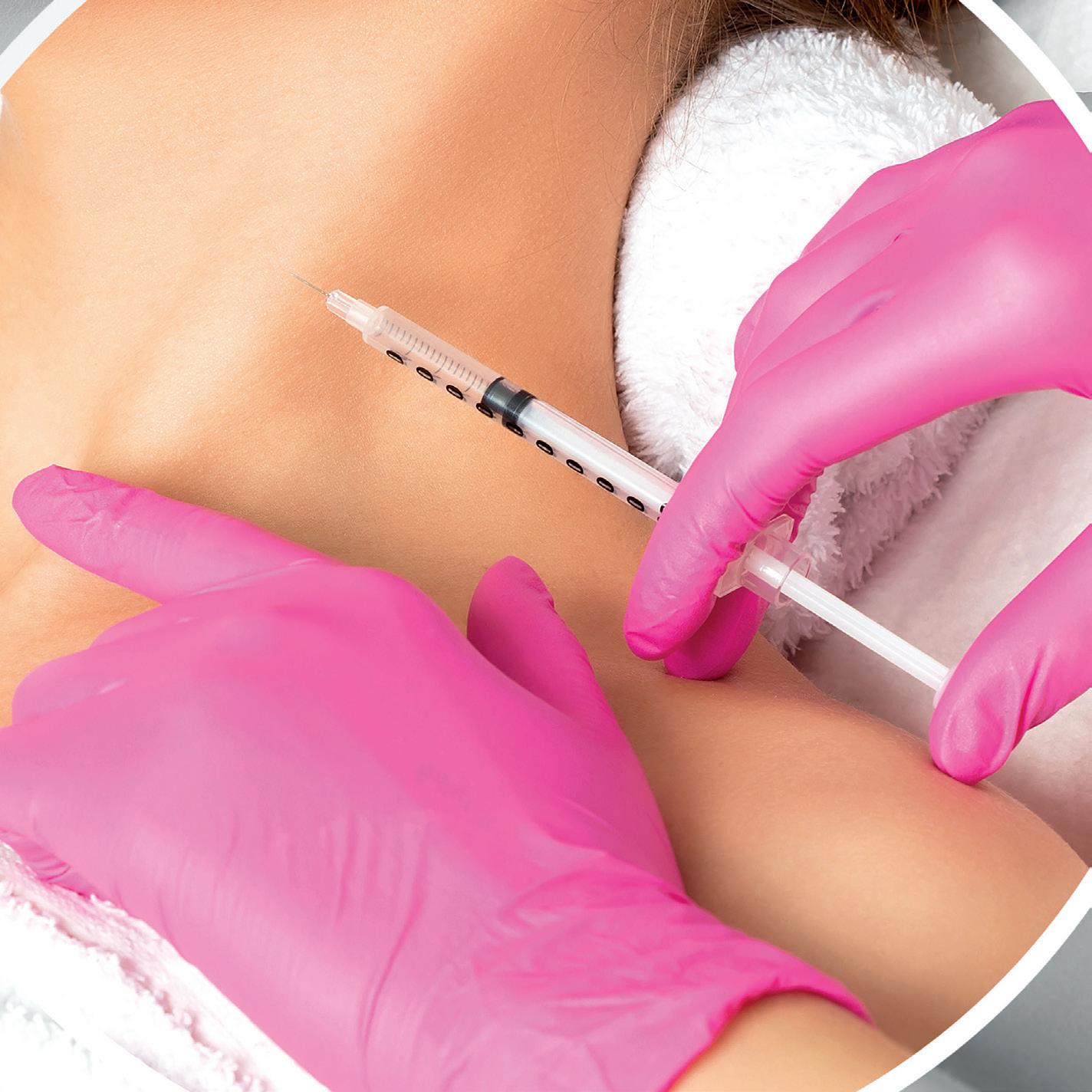
After anaesthetic application, an ultrasound gel is applied and transducers are placed firmly on the skin and energy is delivered in a uniform pattern. Transducers of different depths, i.e. 1.5 mm, 3 mm or 4.5 mm, are chosen according to the extent of the patient’s concerns; energy is set according to the patient’s pain tolerability. Approximately 250–300 ultrasound shots are administered for the neck area. Focused ultrasound energy was also seen to improve skin laxity, wrinkling, and offer a cervical lift. Post treatment swelling, erythema and bruising may be noticed. Results take up to 3–6 months to appear, and treatment should be repeated once a year16. Focused ultrasound is also considered to be safe in skin of colour, whereas other light-based treatments cannot be chosen due to chances of scarring or post-inflammatory hyperpigmentation17
Radiofrequency
Intragen is a 6-MHZ monopolar non-ablative radiofrequency technology with relatively no downtime, being used in our clinic to treat mild horizontal lines of the neck or early signs of ageing, such as skin laxity or fine lines. It is hypothesised
that RF heat alters the collagen molecule’s triple helix molecular structure, causing intramolecular hydrogen bonds to dissolve and denaturing collagen fibrils with rapid contraction. As a result of this thermally mediated healing response, fibroblasts are propelled to increase fresh collagen synthesis and remodelling over time, which leads to greater collagen tightness and an increase in collagen content overall18
Post topical anaesthetic application, a conductive coupling fluid is applied to the treatment site to promote uniform energy conduction and improve the thermal and electrical contact between the treatment tip and the skin. Two to three energy passes are performed on the treatment site according to the patient’s tolerability, with post-procedure oedema and redness a possibility at the treatment site. Treatments are repeated at an interval of 2 weeks and for approximately 3 months.
Thread lift
To attain the perfect visual appeal, threads can be utilised to improve the texture, wrinkling, and suppleness of the skin. They allow for minimum friction between the skin of the neck and face.
Threads function by continuously presenting the cell with mechanical stimuli, a process known as mechanotransduction. It boosts cellular metabolism and encourages the synthesis of fresh collagen.
Threads made of polydioxanone (PDO) and poly L-lactic acid (PLLA) are frequently utilised. Threads promote neoangiogenesis, collagenisation, and fibroblast growth. Mild bruising and oedema are frequent adverse effects19. Similar to other aesthetic procedures, several sessions could be required to attain and maintain the desired outcome.
Ablative and non-ablative lasers
Fractional CO2 is considered a gold standard treatment for neck remodelling, resulting in dermis remodelling and collagen induction20. In a study using a fractionated CO2 laser for neck rejuvenation, Tierney and Hanke showed a 63% improvement in skin texture, a 57% mean improvement in skin tightness, and a 51.4% improvement in skin rhytides two months after treatment. Likewise, our research unequivocally demonstrates that fractional CO2 laser
AESTHETIC FEATURE | NECK REJUVENATION | 34 ❚ September/October 2023 | prime-journal.com
In our clinic, we have noticed that the most promising therapy in the treatment of horizontal lines or ‘tech neck’ is injecting hyaluronic acid in the subdermal space.
therapy is helpful for treating neck ageing, even after just one session21. Even though it is considered a gold standard therapy for rejuvenation, the chances of postinflammatory hyperpigmentation and scarring are very likely side effects when performed on skin of colour.
Microneedling
To produce an even effect across the entire area, microneedling requires producing tiny punctures in the skin, preferably in series. A derma-roller, derma-stamp, or derma-pen are variations of microneedling devices available on the market. The punctures initiate the release of growth factors, such as transforming growth factoralpha, epidermal growth factor, and platelet-derived growth factor, which immediately promote fibroblast activity. By activating the fibroblasts in charge of producing collagen and elastin, micro-punctures lead to skin remodelling22
Cryolipolysis
The preplastysmal submental compartment’s subcutaneous fat buildup causes loss of the mandibular line definition and an aged or overweight appearance. The most common method of treating sub-mental fat is surgical liposuction, including laser- and ultrasoundassisted liposuction. Recently, due to its efficacy, good patient tolerance, and evidenced safety, cryolipolysis has attracted a lot of attention23
Lipolytic injections
Phosphatidylcholine and deoxycholic acid are the commonly used lipolytic injections. Phosphatidylcholine causes the adipocytes to burst and enhances the release of triaglycerol-rich lipoproteins after being injected subcutaneously into fat tissue. Deoxycholic acid physically damages adipocytes’ cell membranes, leading to cell death. Relatively protein-poor tissues like fat are more
References
1. Wang, S., Niu, H., Liu, Y. et al. Clinical Efficacy and Safety of Non-Cross-Linked Hyaluronic Acid Combined with L-carnosine for Horizontal Neck Wrinkles Treatment. Aesth Plast Surg 45, 2912–2917 (2021). https://doi. org/10.1007/s00266-021-02307-2
2. Tseng F, Yu H. Treatment of Horizontal Neck Wrinkles with Hyaluronic Acid Filler: A Retrospective Case Series. Plast Reconstr Surg Glob Open. 2019 Aug 19;7(8):e2366. doi: 10.1097/ GOX.0000000000002366. PMID: 31592383; PMCID: PMC6756638.
3. Li Y, Liao M, Zhu Y, Gao J, Song Y, Zhai Y, Zhu M, He Y, Dong W. Hyaluronic Acid Compound Filling Plus Mesotherapy vs Botulinum Toxin A for the Treatment of Horizontal Neck
Lines: A Multicenter, Randomized, Evaluator-Blinded, Prospective Study in Chinese Subjects.
Aesthet Surg J. 2022 Mar
15;42(4):NP230-NP241. doi:
10.1093/asj/sjab387. Erratum in:
Aesthet Surg J. 2022 Apr 02;: PMID: 34758056; PMCID:
PMC8972830.
4. Young MB, Lai W, Kononov T, Zahr AS. A Rejuvenating treatment targeting “tech neck”
Key points
Neck ageing results from a combination of intrinsic and extrinsic factors including sun exposure, genetics, hormones, and metabolic conditions.
Visible changes in an ageing neck encompass skin alterations, subcutaneous fat accumulation, platysmal muscle tone decline, and bone resorption
Treatment modalities for neck rejuvenation include neuromodulation, dermal fillers, focused ultrasound energy, radiofrequency, thread lifts, ablative/non-ablative lasers, microneedling, cryolipolysis, and lipolytic injections
Invasive options like surgical neck lift are recommended for severe jowling or significant demarcation loss between the face and neck.
Tailored treatment plans, accounting for individual anatomical changes and causal factors, are essential for effective and lasting results.
vulnerable to deoxycholic acid’s cytolytic actions than are comparatively protein-rich tissues like skin and muscle24
Invasive options
Non-invasive treatments for the neck are not recommended when in the presence of severe jowling or demarcation loss between the face and neck. In such cases, a surgical neck lift would be the preferred option. Necklift surgery requires a proper and complete assessment of all three planes, i.e., superficial, intermediate, and deep plane, to select an ideal candidate who would achieve optimal results from the procedure. A number of steps are involved in a surgical necklift, such as fat excision, myotomy of platysma and digastric muscles, excision of the submandibular glands, and excision of the extra skin. Steps are chosen after careful assessment of each patient. Complications include contour irregularities or a ‘hammocked effect’ perhaps seen due to improper liposuction or over-correction10
Conclusion
When compared to previous years, there are a larger number of options available to treat necklace lines or ‘tech neck’ as well as an ageing neck. A significant knowledge of the anatomy of the neck is required to understand the causative factors and to understand the various signs of an aged neck. Treatments should be tailored to each individual after careful history and examination of each case. Most often, one or more treatments may have to be combined in accordance with causative factors and anatomical changes to achieve optimal and longer-lasting results.
Acknowledgments Thank you to my doctor, Dr Ranjitha for her help.
2022 Dec 27. PMID: 36575878.
lines and wrinkles in Chinese women: A prospective, open-label, single-center study. J Cosmet Dermatol. 2023 Jan;22(1):226-235. doi: 10.1111/ jocd.15497. Epub 2022 Nov 14. PMID: 36374589.
5. Dibernardo BE. The aging neck: a diagnostic approach to surgical and nonsurgical options. J Cosmet Laser Ther. 2013 Apr;15(2):56-64. doi: 10.3109/14764172.2012.758383. Epub 2013 Mar 6. PMID: 23464846.
6. Ganceviciene R, Liakou AI, Theodoridis A, Makrantonaki E, Zouboulis CC. Skin anti-aging strategies. Dermatoendocrinol. 2012 Jul 1;4(3):308-19. doi: 10.4161/derm.22804. PMID: 23467476; PMCID: PMC3583892.
7. Brandt FS, Boker A. Botulinum toxin for rejuvenation of the neck. Clin Dermatol. 2003 Nov-Dec;21(6):513-20. doi: 10.1016/j. clindermatol.2003.11.004. PMID: 14759585.
8. Vedamurthy M, Hande M. Characteristic features of neck aging. CosmoDerma 2022;2:35.
9. Ramírez OM. Advanced considerations determining
procedure selection in cervicoplasty. Part one: anatomy and aesthetics. Clin Plast Surg. 2008 Oct;35(4):679-90, viii. doi: 10.1016/j.cps.2008.05.002. PMID: 18922321.
10. Mejia JD, Nahai FR, Nahai F, Momoh AO. Isolated management of the aging neck. Semin Plast Surg. 2009 Nov;23(4):264-73. doi: 10.1055/s-0029-1242178. PMID: 21037862; PMCID: PMC2884910.
11. Awaida CJ, Jabbour SF, Rayess YA, El Khoury JS, Kechichian EG, Nasr MW.
Evaluation of the Microbotox
Technique: An Algorithmic Approach for Lower Face and Neck Rejuvenation and a Crossover Clinical Trial. Plast Reconstr Surg. 2018 Sep;142(3):640-649. doi: 10.1097/ PRS.0000000000004695. PMID: 29879010.
12. Rongthong A, Wanitphakdeedecha R, Maiprasert M, Cembrano KAG, Voravutinon N, Rakchart S, Sermswan K, Koonngam P. Efficacy and safety of hyaluronic acid filler on the treatment of horizontal neck lines. J Cosmet Dermatol. 2023 Feb;22(2):433438. doi: 10.1111/jocd.15539. Epub
13. Niforos F, Ogilvie P, Cavallini M, Leys C, Chantrey J, Safa M, Abrams S, Hopfinger R, Marx A. VYC-12 Injectable Gel Is Safe And Effective For Improvement Of Facial Skin Topography: A Prospective Study. Clin Cosmet Investig Dermatol. 2019 Oct 24;12:791-798. doi: 10.2147/CCID. S216222. PMID: 31749628; PMCID: PMC6817835.
14. Cassuto D, Delledonne M, Zaccaria G, Illiano I, Giori AM, Bellia G. Safety Assessment of High- and Low-Molecular-Weight Hyaluronans (Profhilo®) as Derived from Worldwide Postmarketing Data. Biomed Res Int. 2020 Jun 20;2020:8159047. doi: 10.1155/2020/8159047. PMID: 32685528; PMCID: PMC7327616.
15. Agolli E, Diffidenti B, Di Zitti N, Massidda E, Patella F, Santerini C, et al. Hybrid cooperative complexes of high and low molecular weight hyaluronans (Profhilo®): review of the literature and presentation of the VisionHA project. Esperienze Dermatol 2018;20:5-14. DOI: 10.23736/S1128-9155.18.00470-3
16. Azuelos A, SidAhmed-Mezi M, La Padula S, Aboud C, Meningaud JP, Hersant B. High-Intensity
Focused Ultrasound: A Satisfactory Noninvasive Procedure for Neck Rejuvenation. Aesthet Surg J. 2019 Jul 12;39(8):NP343-NP351. doi: 10.1093/asj/sjz093. PMID: 30923813.
17. Kim J, So BJ, Ryu HJ. Clinical Effectiveness of a High-Intensity
Focused Ultrasound in Skin Lifting. Medical Lasers 2014;3:55-58. https://doi. org/10.25289/ML.2014.3.2.55
18. Araújo AR, Soares VP, Silva FS, Moreira Tda S. Radiofrequency for the treatment of skin laxity: mith or truth. An Bras Dermatol. 2015 Sep-Oct;90(5):707-21. doi: 10.1590/abd1806-4841.20153605. PMID: 26560216; PMCID: PMC4631236.
19. Liao ZF, Yang W, Lin FC, Wang SW, Hong WJ, Luo SK. A Case Study: Comprehensive Approach for Treating Horizontal Neck Wrinkles Using Hyaluronic Acid Injections and Thread-Lifting. Aesthetic Plast Surg. 2023 Apr;47(2):765-771. doi: 10.1007/ s00266-022-03071-7. Epub 2022 Aug 25. PMID: 36008497; PMCID: PMC10070208.
20. Oram Y, Akkaya AD. Neck Rejuvenation with Fractional CO2 Laser: Long-term Results. J Clin
Aesthet Dermatol. 2014 Aug;7(8):23-9. PMID: 25161757; PMCID: PMC4142817.
21. Tierney EP, Hanke CW. Ablative fractionated CO2, laser resurfacing for the neck: prospective study and review of the literature. J Drugs Dermatol. 2009;8:723–731.
22. Pająk J, Szepietowski JC, Nowicka D. Prevention of Ageing-The Role of Micro-Needling in Neck and Cleavage Rejuvenation: A Narrative Review. Int J Environ Res Public Health. 2022 Jul 25;19(15):9055. doi: 10.3390/ ijerph19159055. PMID: 35897441; PMCID: PMC9332435.
23. Kilmer SL, Burns AJ, Zelickson BD. Safety and efficacy of cryolipolysis for non-invasive reduction of submental fat. Lasers Surg Med. 2016 Jan;48(1):3-13. doi: 10.1002/ lsm.22440. Epub 2015 Nov 26. PMID: 26607045; PMCID: PMC5396277.
24. Talathi A, Talathi P. Fat Busters: Lipolysis for Face and Neck. J Cutan Aesthet Surg. 2018 Apr-Jun;11(2):67-72. doi: 10.4103/ JCAS.JCAS_59_18. PMID: 30210208; PMCID: PMC6128158.
| NECK REJUVENATION | AESTHETIC FEATURE prime-journal.com | September/October 2023 ❚ 35
TARGETING THE EXTRACELLULAR MATRIX TO RESTORE AND REJUVENATE THE FACE
Irina Poleva explains the importance of connective tissue to facial ageing and how a new dermal biorevitaliser could be a game changer
ABSTRACT
Facial ageing is largely caused by the ageing of the connective tissue: with the deterioration of the quality of the extracellular matrix and collagen, sagging of the retaining ligaments occurs in the skin and the alteration of the fat pads and of the lobules, everything slides downwards and modifies the oval
of the face. Restoring the connective tissue and extracellular matrix could be a game-changing factor in anti-ageing strategy.

The purpose of this article is to inform about a new innovative product based on a blend of hyaluronic acid of different weights, amino acids and peptides that aims to restore the connective tissue of the face
starting from the extracellular matrix.
To conclude, the injectable gel Jalupro Superhydro enriched in seven amino acids and three biomimetic peptides is a game-changing product providing an innovative, previously impossible opportunity for aesthetic practitioners to regenerate the connective tissue and extracellular matrix.
AESTHETIC FEATURE | FACIAL REJUVENATION | 36 ❚ September/October 2023 | prime-journal.com
WE, AS AESTHETIC PHYSICIANS and those working in the aesthetic and anti-ageing industry, know how complex the ageing process is. It involves all the tissues and structures of the face: from the facial skeleton, which undergoes resorption processes; to the fat pads, which lose their compactness and sag down through gravity; to the facial muscles straining the ageing skin and creating wrinkles.
Connective tissue, one of our body’s four main tissue groups, is involved in all these processes. We can even propose that the ageing of the body is correlated to the ageing of the connective tissue, including the extracellular matrix (ECM).
Connective tissue
The role of connective tissue in the body is very important1. Firstly, it serves as an interstitium, or stroma, in many organs and tissues; it fills the space between the main functional elements of organs and connects them into a whole (hence the term connective tissue).
Secondly, this tissue creates anatomical formations — fascia and capsule, tendons and lymph nodes, cartilage and bones, the non-epithelial part of the skin, and septa of fat tissue. It is a significant structural agent of our body.
Connective tissue consists of three main components: a primary substance, fibres (elastin and collagen), and cells.

The primary substance of connective tissue contains interstitial fluid where growth factors and cytokines reside, as well as cell adhesion proteins (fibronectin, laminin), proteoglycans (chondroitin sulphate,
IRINA POLEVA, MD, is a board-certified dermatologist who graduated from ‘La Sapienza’ University, Rome, Italy. Compagnie Generale des Hopitaux di Roma, Gruppo Saniroma

Via Nomentana 173, 00161, Rome, Italy
email: i.poleva@libero.it
hyaluronic acid), metalloproteinases, integrins (transmembrane proteins). Among the fibre content, collagen is the leading agent.
Collagen is one of the most plentiful proteins present in mammals, and it is responsible for performing a variety of important biological functions. It is most well-known for the structural role it plays in the body. Collagen is present in large quantities in connective tissue and provides tendons and ligaments with tensile strength and skin with elasticity. It often works in conjunction with other important proteins, such as keratin and elastin.
About one-quarter of all the protein in our body, collagen is a major structural protein, forming molecular cables that strengthen the tendons and resilient sheets that support the skin and internal organs. Its tensile strength is extraordinary.
Each collagen fibre contains thousands of individual collagen molecules bound together through crosslinking. Covalent bonds are the strongest bonds that can exist among protein molecules. The collagen molecules themselves are made from three individual polypeptides or strings of amino acids. The strands wind around one another in an alpha-helix—the helix forms because of the regular amino acid sequence of the strands.
The glycine-proline-hydroxyproline sequence, the socalled ‘collagen melody’, is fundamental to its structure.
Elastin is the second main fibre in connective tissue, almost playing the opposite role to collagen. It consists of long, thin, branched fibre; it is highly stretchable and stretches up to 150% of its original length.
KEYWORDS
Biostimulation, connective tissue, extracellular matrix
The elastin molecule consists of four polypeptide chains composed of glycine (33%), proline, valine, and alanine.
| FACIAL REJUVENATION | AESTHETIC FEATURE prime-journal.com | September/October 2023 ❚ 37
Collagen is present in large quantities in connective tissue and provides tendons and ligaments with tensile strength and skin with elasticity.
Connective tissue cells can be classed as:
■ stationary (e.g., fibroblasts), and
■ migratory (lymphocytes, macrophages).
Fibroblasts are the most common cells found in connective tissue and are responsible for producing the extracellular matrix (ECM). They are also involved in wound healing, as they migrate to the wound site and produce ECM to form scar tissue. They play a role in maintaining tissue homeostasis by remodelling the ECM in response to changes in mechanical stress or injury. Unsung heroes of connective tissue, they play a key role in connective tissue maintenance.
They can take different names according to the type of connective tissue. Called fibroblasts in most places, they are called tenoblasts and tenocytes in ligaments and tendons.
They are a fantastic little factory, maintaining the structural integrity of our body and our skin.
Lastly, macrophages are responsible for cleaning and keeping the ECM free of waste of old fibres (fragmented old collagen or elastin, metabolites of the cellular function).
Connective tissue constitutes a large part of our face2, in particular, important anatomical structures such as ligaments. Ligaments are composed of collagen, and as we age, ligaments lose their strength and, with it, their supportive function.
In the deep layers of the face, we find a subcutaneous network of collagenous fibres known as the retinacula cutis (RC). K. Tsukahara, in Archives of Dermatology, 2012, showed that the depth of wrinkles correlated to the loss of density of the retinacula cutis3
It is also important to remember fat tissue4. Connective tissue surrounds fat deposits, giving them shape and firmness, which creates a youthful-looking face. Maintaining healthy collagen improves the structure of adipose tissue.
In summary, facial ageing is largely caused by the ageing of the connective tissue: with the deterioration of the quality of the extracellular matrix and collagen, the retaining ligaments in the skin will begin to sag, and with the alteration of the fat pads and the lobules, everything slides downwards and modifies the oval of the face. Because collagen is the main component of connective


tissue, we should preserve it for as long as possible to maintain good skin and facial structure, considering the importance of deep connective tissue to facial structure and the ageing process.
Why does the amount of collagen in our skin decrease?
There are different intrinsic and extrinsic reasons (genetics, lifestyle, age, etc.) Understanding homeostasis and the balance of metabolic processes is crucial to maintaining anabolic processes and to slow down catabolic ones.
Building good-quality collagen
There are three essential factors:
■ Appropriateness of the type and quantity of amino acids (glycine, proline, lysine), the so-called ‘functional cluster’
■ Constant availability of amino acids in a given ratio
■ Availability of cofactors (vitamins and minerals). The functional cluster of amino acids is responsible for the multiplication of fibroblasts, stimulates the synthesis of collagen and growth factors, and slows down the degradation of collagen.
The natural production of collagen in the body requires a few other components as co-factors, including vitamin A, vitamin C, manganese, copper, zinc, etc. It is evident from published scientific reports that a deficiency of vitamins and minerals alters the production of collagen in the body.
We have many available collagen-stimulating treatments for the skin, with most of them acting upon the fibroblasts. However, we have very few options for ligaments and deep connective tissue strengthening. It was even believed for a long time that ligaments had no cells and that the ageing of the ligament was simply fatigue. Existing options for the ligaments and, therefore, the structure of the face were surgical lift, injection of cross-linked hyaluronic acid at the base of the ligament to replace the loss of the deep fat compartment and support the base of the ligament, or tightening with an energybased device (HIFU) or thread lifting.
Along with fibroblasts being present in the dermis, fibroblasts are also found in ligaments and deep connective tissue as tenoblasts and tenocytes. They fulfil the same function of production of the connective tissue component and collagenase, explaining why collagen in deep connective tissue is decreasing but can be replaced and maintained as well.
A new dermal biorevitaliser
A new product with an innovative formulation recently appeared in the market (Jalupro Superhydro, Professional Derma, Lugano, Switzerland). This gel, composed of high and low molecular weight hyaluronic acid (HA) and a unique blend of amino acids (AAs) and peptides, is a medical device according to Directive EEC 93/42 MDD. It has been on the European market since 2021.
A group of seven AAs provide a rapid glycine, proline, and lysine concentration. The addition of alanine and valine helps strengthen collagen and elastin, while arginine and leucine improve hydration.
Three biomimetic peptides (acetyl decapeptide 3,
Figure 1 Example of the evaluation of the wrinkles conditions using 3D Photosystem (MiniViz, Quantificare, USA)
AESTHETIC FEATURE | FACIAL REJUVENATION | 38 ❚ September/October 2023 | prime-journal.com
As a result of the improvement of the ECM, strengthening of the ligaments and regeneration of the connective tissue of the subcutaneous fat, the patient obtains tighter, glowing, firm skin and improved facial structure without unwanted volume.
oligopeptide 24 and acetyl tetrapeptide 3) allow for the rapid activation of fibroblasts and inhibit glycation.
The blend of low and high-molecular-weight HA allows for the long-term hydration and stimulation of fibroblasts. All these natural ingredients work together to stimulate collagen production, the ECM, and improve the overall texture and appearance of the skin.
Injection technique
The technique for injections is coherent with the objective of the treatment: reinforce the deep connective tissue, ligaments, and retinacula cutis.
Six deep points (subdermal or periosteum) are targeted corresponding to the ligaments (orbital thickening, zygomatic ligament, superior masseteric ligament, Lora’s fascia, masseteric ligament, and mandibular septum). The last point of injection in the centre of the chin is optional, though it aims to maintain the connective tissue in that area.
The protocol expects three monthly sessions of the injections.
Results
As a result of the improvement of the ECM, strengthening of the ligaments and regeneration of the connective tissue of the subcutaneous fat, the patient obtains tighter, glowing, firm skin and improved facial structure without unwanted volume.
Alongside this subjective evaluation of the patients, which is very positive, an ongoing investigation ascertains that there is an objective improvement of wrinkle conditions proved using a 3D photosystem (Life Viz Mini, Quantificare, USA) (Figure 1) and visible lifting effect documented by lifting vectors (Figure 2).


The new formulation for biostimulation differs from other products currently present on the market:
■ A particular cluster of AAs, on the one hand, guarantees a perfect proportion and quantity of amino acids required for collagen synthesis (glycine, proline, lysine). On the other hand, alanine and valine promote even better collagen and elastin production4, while arginine and leucine improve hydration6
■ The innovative composition of Jalupro Superhydro is enriched in peptides
■ The presence of very high molecular weight HA provides a deep and long-lasting moisturising effect, while low molecular weight HA works as a perfect carrier for other components of Jalupro Superhydro, such as amino acid clusters and peptides.
The procedure itself is not time-consuming; the 6+1 injection point protocol takes 10 minutes to be performed. It is loved by the patients since the procedure is not painful and the risk of bruising is low. The outcome is visible a few hours after the treatment, and the skin glows for weeks after the first session.
Jalupro Superhydro offers several benefits for those looking to improve the appearance of their skin. Firstly, it provides long-lasting hydration, which can help to reduce the appearance of fine lines and wrinkles. Secondly, it stimulates collagen production strengthening ligaments
Key points
Connective tissue, including collagen and fibroblasts, strongly influences facial ageing by affecting structure and elasticity

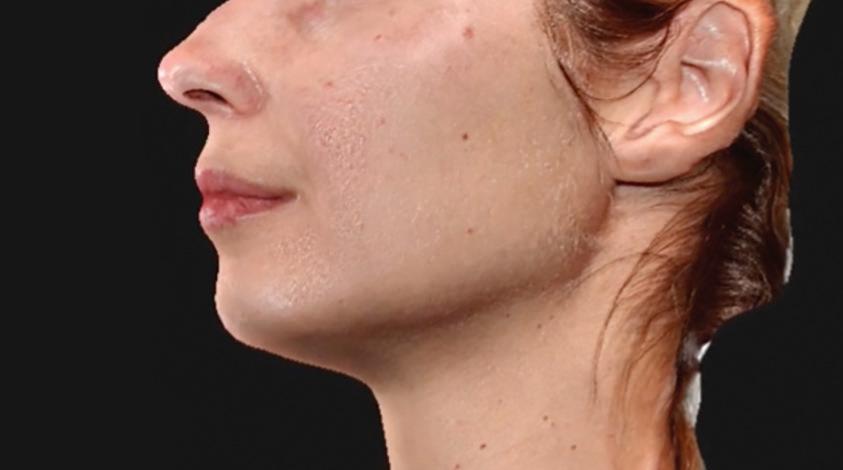
Jalupro Superhydro is a combination of native hyaluronic acid, amino acids, and peptides that stimulates collagen synthesis, targeting ligaments and deep connective tissue
The treatment protocol yields a subtle lifting effect and enhances wrinkle conditions.
References
and regenerating the ECM, which helps to improve the overall texture and firmness of the skin. Finally, it is a safe and effective treatment that can be used on all skin types.
Jalupro Superhydro is also a versatile product that can be used in combination with other treatments, such as Botox and dermal fillers, to provide even more dramatic results.
Like all cosmetic treatments, Jalupro Superhydro may cause some side effects. These are generally mild and temporary and include redness, swelling, and bruising at the injection site; they usually last no more than a few hours.
Conclusion
The new HA-based gel enriched in seven AAs and three biomimetic peptides is a game-changing product providing an innovative, previously impossible opportunity for aesthetic practitioners to regenerate the connective tissue and ECM in a single procedure or to prepare the patients for other anti-ageing treatments enhancing the aesthetic outcomes and patient satisfaction.
Acknowledgements
Irina Poleva received lecture fee from Professional Derma but not related to this article.
PMID: 33325497; PMCID: PMC8438644.
3. Tsukahara K, Tamatsu Y, Sugawara Y, Shimada K. Relationship Between the Depth of Facial Wrinkles and the Density of the Retinacula Cutis. ARCH DERMATOL, Jan 2012: 148 (No 1)
4. Rohrich RJ, Avashia YJ, Savetsky IL. Prediction of Facial
Aging Using the Facial Fat Compartments. Plast Reconstr Surg. 2021 Jan 1;147(1S-2):38S-42S. doi: 10.1097/ PRS.0000000000007624. PMID: 33347073.
5.
6. Kanwa N,
May-Jun;32(3):517-527. PMID: 29921376
and dehydration phenomena. Phys Chem Chem Phys. 2020 Feb 14;22(6):3234-3244. doi: 10.1039/ c9cp06188f. Epub 2020 Jan 29. PMID: 31994545.
Figure 1-2 © Irina Poleva
1. Nezwek TA, Varacallo M. Physiology, Connective Tissue. 2022 Sep 19. In: StatPearls [Internet]. Treasure Island (FL): StatPearls Publishing; 2023 Jan–. PMID: 31194383.
2. Swift A, Liew S, Weinkle S, Garcia JK, Silberberg MB. The Facial Aging Process From the “Inside Out”. Aesthet Surg J. 2021 Sep 14;41(10):1107-1119. doi: 10.1093/asj/sjaa339.
De Servi B, Orlandini A, Caviola E, Meloni M. Amino acid and hyaluronic acid mixtures differentially regulate extra cellular matrix genes in cultured human fibroblasts. J Biol Regul Homeost Agents. 2018
De SK, Maity A, Chakraborty A. Interaction of aliphatic amino acids with zwitterionic and charged lipid membranes: hydration
Figure 2 Example of the evaluation of vectors of traction and their average length.
2.46mm
| FACIAL REJUVENATION | AESTHETIC FEATURE prime-journal.com | September/October 2023 ❚ 39
1.66mm
FOUR-STAGE RHINOPLASTY WITH PDO BARBED THREADS
Aaron Hsieh, MD, discusses a new approach to rhinoplasty that avoids the pitfalls of filler and the downtime of surgical rhinoplasty

ABSTRACT
Minimally invasive rhinoplasty with filler is very popular in Asia. However, due to the frequent complication of vessel obstruction or compression, we are searching for a new method to substitute the filler.
Research design and methods: Two patients were enrolled in the study. We used PDO cog threads as the augmentation material, preparing the threads in advance and inserting them through the nasal tip and medial eyebrows, then followed up with the patients for
at least 6 months. Four regions are treated, including the nasion, nasal bridge, nasal tip, and nasal columella, which is why we call it the fourstage rhinoplasty.
Results: The results showed a noticeable elevation to the nose and lasted more than 6 months.
Conclusions: Four-Stage Rhinoplasty with PDO barbed threads is a safe and effective method for nasal augmentation. The effect will gradually subside, but according to our observation, it could last for more than 6 months.
email: jasonwilliamsmvp@ gmail.com
KEYWORDS
Minimal invasive rhinoplasty, nasal augmentation, PDO barbed threads

RHINOPLASTY IS A POPULAR surgical treatment in parts of East and Southeast Asia due to negatively perceived natural traits among the population and the pursuit and growing trend in modern aesthetics for a stereoscopic nasal expression. However, the risk of complications due to unsuccessful surgical procedures and the lengthy downtime has made many aesthetic suitors hesitate. Therefore, some medical practitioners have tried to substitute ‘traditional surgical rhinoplasty’ with much less invasive methods such as hyaluronic acid injections, which have significant shortcomings such as deformation over time, skin necrosis and, most seriously, optical blindness due to the treatment uncertainty of the product placement. Fortunately, with the arrival of the PDO cog thread for the application of rhinoplasty, physicians can now avoid the occurrence of such frightening dilemmas. Using PDO threads with innovative techniques, we are achieving satisfactory outcomes while also surpassing the aesthetic and safety results of filler injections. In the study, I will introduce the use of the PDO barbed thread with a four-stage method for micro-invasive rhinoplasty.
Patients and methods
Two female patients, 28 and 32 years old, were enrolled in the study, respectively. The product we used contains two types of threads, which are PDO barbed threads (Miracle thread, made by Diamond Biotechnology Co., Ltd, Taipei, Taiwan) with USP 1 and 3-0 in diameter and 17 cm in length (Figure 1).
We started from the nasion. Before the treatment, we prepared the threads — as the thread was 17cm in length, but the barbed part was only 10 cm; we cut off the smooth part in advance in order to prevent thread protrusion after treatment, which is a major complication after thread nasal augmentation. For the nasion, because it is short, about 1 to 2 cm, we cut the threads into four segments, 2.5 cm in length for each, with every segment containing barbs. Then we fold 6 cm in length of thread and put it into the blunt cannula, with half of the thread outside and half inside the cannula.
After local anaesthesia, we introduce the cannula from the medial point of the eyebrow, penetrate the procerus muscle and go deep to the nasal bone. We repeat the procedure until all four segments
AARON CHIA-HSIEN HSIEH, MD, is a Dermatologist, Taipei City Hospital, Taipei, Taiwan
AESTHETIC FEATURE | RHINOPLASTY | 40 ❚ September/October 2023 | prime-journal.com
Now, using PDO threads with innovative techniques, we are achieving satisfactory outcomes while also surpassing the aesthetic and safety results of filler injections.

| RHINOPLASTY | AESTHETIC FEATURE
are inserted and then go to the other side with the same method.
For the nasal bridge, we also prepare the threads in advance but because the nasal bridge is longer we only cut each thread into two segments. We then put the thread into the blunt cannula and fold it, introduce the cannula from between the nasal cartilages and go upward, positioned deep under the muscles (Figure 2A). We use six pieces of USP 1 PDO cog thread for the nasal bridge, which means 12 segments were inserted. For the columella, as the nasion, we cut every thread into four segments because it is also short. We introduce the cannula from the same entry point as the nasal bridge downward to the maxillary bone (Figure 2B). We use 2 USP 1 PDO cog threads for the columella. Finally, for the nasal tip, only the second patient received the treatment. Because it’s the most delicate part of the nose, we used the USP 3-0 thread. This time we didn’t cut the threads but put them into the cannula and introduced it into the nasal tip repeatedly until all of the threads merged into the nasal tip (Figure 2C).
Results
Immediately after the procedure, we took a number of photographs to evaluate the height of the nose, including the 45-degree plain picture and the images taken and processed by the 3D camera (LifeViz Mini, Quantificare, Biot, France). These methods show a prominent elevation of the nasion, nasal bridge, nasal tip, and columella.
For the first case, the colour image analysis shows the elevation of the nasion and nasal bridge at a height of about 2.58 mm (Figure 4). We can see the angle between the nasion and nasal bridge increased from 151.8 to 157.6 degrees, and followed up for 3 months we can see the angle is 156.3 degrees (Figure 5).
For the second case, not only did we find the nasion and nasal bridge to be elevated (2.58 and 1.3 mm, respectively), but the nasal tip was also elevated around 2 mm after treatment, and this persisted for 6 months. The angle between the nasion and nasal bridge increased (from 141.8 degrees before treatment to 145.8 degrees right after treatment, and 143.4 degrees after 6 months), but also the angle between the nasal bridge and the nasal base increased from 26.9 to 36.0 degrees after treatment and 27.4 degrees after 6 months (Figure 6).
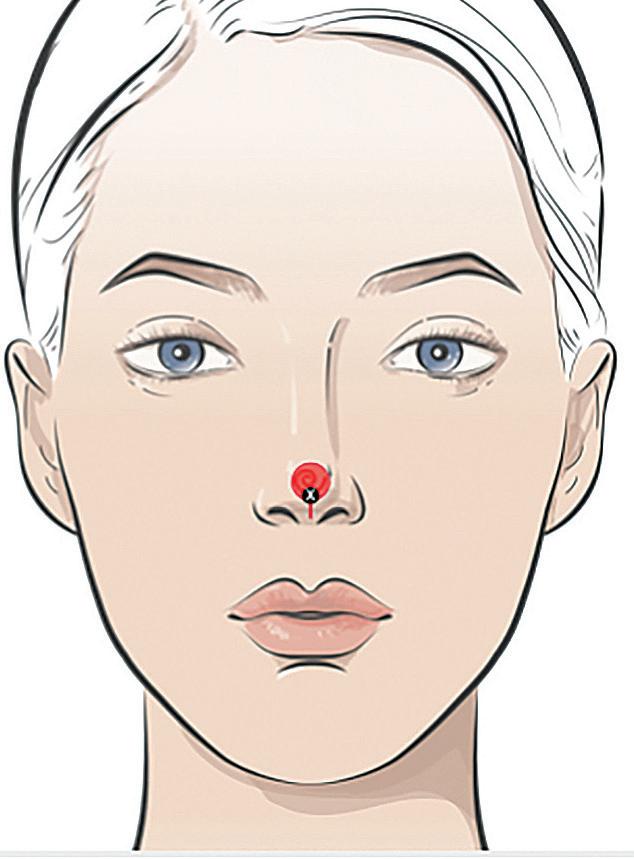


We can see only tiny holes on the medial eyebrows and below the nasal tip right after the treatment. Following up at 3 months (Patient 1) and 6 months (Patient 2), we can see the persistence of the results in both patients. There is only mild swelling and skin colour change due to local anaesthesia, and no severe


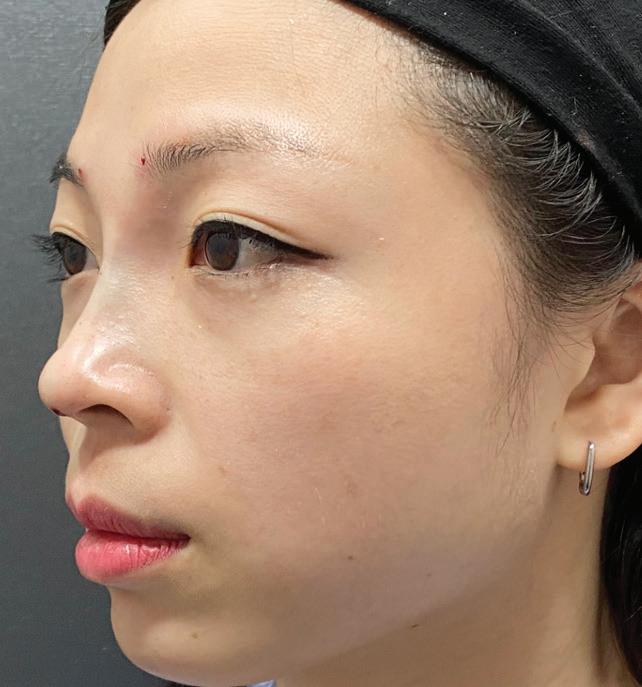
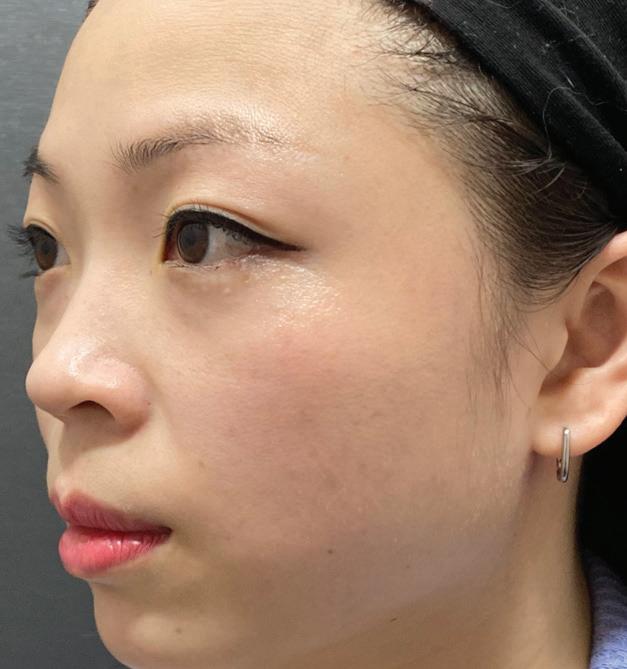
 Figure 1 The structure of the barbed thread we used, USP 1 and 3-0 in diameter, 17 cm in length, with bilateral barbs
Figure 2 Illustration of the method of 4-stage nasal augmentation. (A) nasion and nasal bridge, (B) nasal columella. (C) nasal tip.
Figure 1 The structure of the barbed thread we used, USP 1 and 3-0 in diameter, 17 cm in length, with bilateral barbs
Figure 2 Illustration of the method of 4-stage nasal augmentation. (A) nasion and nasal bridge, (B) nasal columella. (C) nasal tip.
5cm A
Figure 3 Photographs of a 28-year-old woman who underwent thread minimal invasive nasal augmentation on the nasion, nasal bridge, and nasal columella. (A) before treatment, (B) immediately after treatment, (C) 1 month after treatment, (D) 3 months after treatment.
A B C D
B C
AESTHETIC FEATURE | RHINOPLASTY | 42 ❚ September/October 2023 | prime-journal.com
One of the most common complications when using threads for nasal augmentation is thread protrusion from the insertion point.
complications were found immediately after the procedure or at the 6-month follow-up.
Discussion
The PDO barbed thread is a safe and effective material for nasal augmentation. Compared with fillers, the thread won’t cause vessel compression or obstruction. Additionally, the thread won’t diffuse to the adjacent tissue, so it will not make the nose wider.
According to our study, we placed 10 pieces of USP 1 PDO barbed threads into the nose in both cases and two pieces of USP 3-0 PDO barbed threads in the nasal tip of the second case. Both cases had mild swelling after the procedure, but the results looked natural after 1 week. The elevation of the nasion and nasal bridge is pronounced, which could be identified not only by the plain photos but also by the colour images, silhouette images, and the calculation mode supported by the 3D camera. Although it is more subtle, we can see the elongation and pronunciation of the nasal columella. The nasal tip elevation was also evident in the second case.

One of the most common complications when using threads for nasal augmentation is thread protrusion from the insertion point. Therefore, we prepared the threads before treatment by cutting the smooth part of the thread off and folding the thread into the cannula to position the thread at least 1 cm away from the skin after insertion.
Finally, we find the threads’ results and effects subsided gradually but persisted for over half a year.
A B
Conclusion
Thread nasal augmentation is a safe and effective way to improve the appearance of the nose. Four-stage rhinoplasty means nasal augmentation on four parts of the nose, including the nasion, nasal bridge, nasal columella, and nasal tip. Using this method makes the effect better and more natural and prevents further complications, such as thread protrusion.

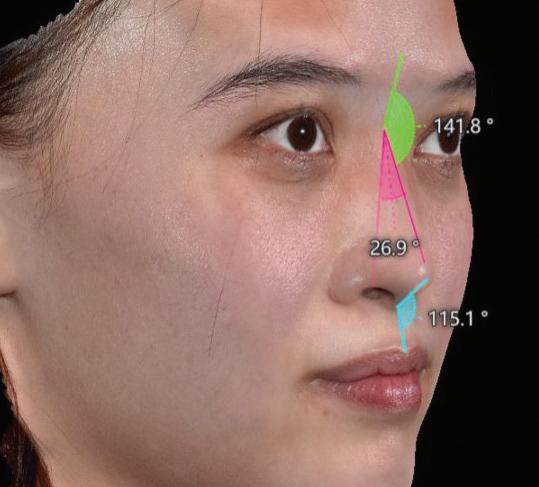



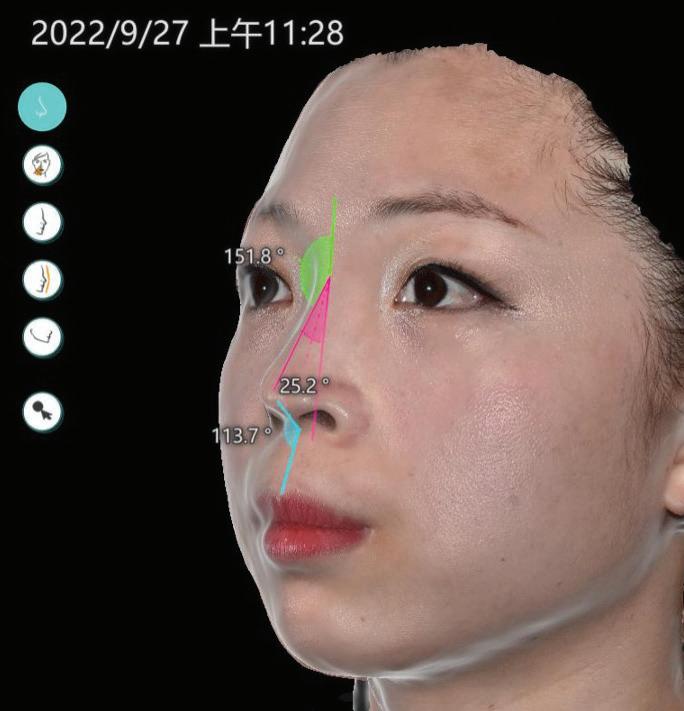

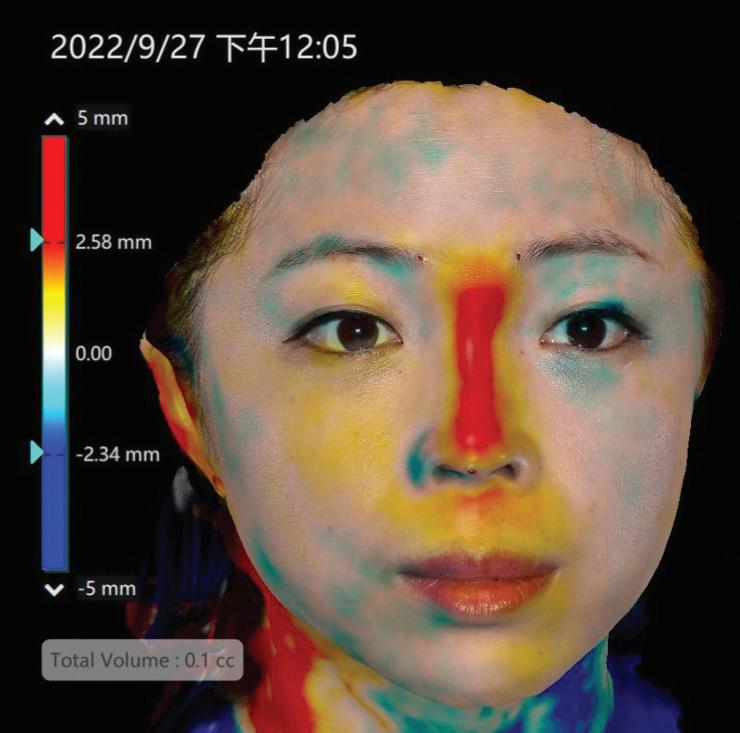
Declaration of interest None
 Figure 6 The silhouette image analysis also showed the elevation of the nasion and nasal bridge. (A) before treatment (the silhouette image) and immediately after treatment, (B) before treatment and 1 month after treatment
Figures 1–6 © Aaron Hsieh
Figure 4 The colour image analysis shows the elevation of the nasion and nasal bridge. (A) before treatment, (B) immediately after treatment, (C) 1 month after treatment, (D) 3 months after treatment
Figure 6 The silhouette image analysis also showed the elevation of the nasion and nasal bridge. (A) before treatment (the silhouette image) and immediately after treatment, (B) before treatment and 1 month after treatment
Figures 1–6 © Aaron Hsieh
Figure 4 The colour image analysis shows the elevation of the nasion and nasal bridge. (A) before treatment, (B) immediately after treatment, (C) 1 month after treatment, (D) 3 months after treatment
A
B
C C D D | RHINOPLASTY | AESTHETIC FEATURE prime-journal.com | September/October 2023 ❚ 43
Figure 5 The calculation mode shows the increase of the angle between nasion and nasal bridge, which indicate the elevation of the nasion. (A) before treatment, (B) immediately after treatment, (C) 1 month after treatment, (D) 3 months after treatment.
A
B
Nata Maghalashvili, MD, discusses her experience using the ARES® Hair Booster

ABSTRACT
Currently, many people suffer from hair loss due to factors such as stress, malnutrition, and autoimmune diseases. Experts propose a variety of techniques to treat this condition. One such treatment that has proved to be very effective is using a mesotherapy product with active ingredients that help strengthen hair, giving it a healthier appearance and promoting hair follicle growth on areas of the scalp that had previously lost their vitality.
AIR LOSS IS A COMMON CONDITION THAT CAN IMPACT AN individual’s self-esteem. In many hair loss cases, understanding the underlying cause is vital for treatment1
MESOTHERAPY TO PREVENT HAIR LOSS AND PROMOTE HAIR REGROWTH H
There are many different factors that can cause and contribute to hair loss. Some of the more common factors include stress, nutritional deficiencies, autoimmune conditions, and hormonal changes2–4
Hair loss is a common and challenging condition, as no standard treatment is completely effective, and side effects can be of concern.
email doctornatamagal@gmail. com
Fortunately, in modern aesthetic medicine, there are a number of options available to help patients, such as injection, laser or drug treatment5–7. The author has found success with treating hair loss with the ARES® Hair Booster (HB).
Mechanism of action
ARES® HB is a complex solution for treating the most common scalp disorders. It contains the following active ingredients:
■ Sh-oligopeptide-11, sh-oligopeptide-2, sh-oligopeptide-3, and sh-oligopeptide-4 promote the revitalisation of the hair, stimulation of hair follicle metabolism, growth of the hair bulb, and increase the number of stem cells within the hair bulb.
■ Fucoidan promotes hair growth by stimulating the production of GAG and collagen.
■ Sh-polypeptide-1, Sh-polypeptide-9, and Copper tripeptide-1 improve skin circulation at the level of the hair follicles and stimulate angiogenesis and microcirculation to the base of the hair bulb, revitalising the follicles.
KEYWORDS mesotherapy, hair loss, ARES HB
■ Arginine promotes the production of nitric oxide by carrying out a vasodilating action and improving microcirculation.
NATA MAGHALASHVILI, MD, is a Doctor Cosmetologist at Welkin Aesthetic Clinic, Tbilisi, Georgia
CASE STUDY | HAIR LOSS | 44 ❚ September/October 2023 | prime-journal.com
■ Swertia Japonica extract assists the inhibiting action of 5a-reductase and the production of DHT. It promotes thicker hair and protects it from damage. Biotin is essential in hair bulb metabolism, promoting healthy hair growth.
■ B vitamins, such as B1 and B6, provide the bulb with the energy to stimulate the metabolism of amino acids essential for hair structure. Panthenol, the precursor of vitamin B5, ensures the cohesion of the hair scales. It repairs and strengthens the hair making it healthy.
■ Keratin protein, formed by long chains of amino acids and vitamins, stimulates hair regrowth and improves its structure.
■ Ferrous gluconate is essential for the transportation of oxygen to the hair bulb.
ARES® HB is often delivered through microneedling8. It is a minimally invasive technique used to treat different skin pathologies. The microneedles puncture the epidermis layer, which is the main obstruction to the penetration of the active ingredients. The actives can now penetrate through microchannels created on the skin by the device. It stimulates the skin cells to produce and

| HAIR LOSS | CASE STUDY prime-journal.com | September/October 2023 ❚ 45
There are many different factors that can cause and contribute to hair loss. Some of the more common factors include stress, nutritional deficiencies, autoimmune conditions, and hormonal changes.
promote collagen and elastin deposition in the dermis, just below the skin surface. The depth of the needles depends on the skin condition and the results we would like to achieve.
Objective
ARES® HB acts on hair regrowth, hair loss prevention, microcirculation, and micronutrient supplementation. The formula contains growth factor complexes, such as hyaluronic acid, polypeptides, oligopeptides, vitamins B1, B5, B6, keratin, ferrous gluconate, Swertia japonica extract, and biotin, which provide the energy to promote hair growth and improve its structure, stimulate the hair bulb, and revitalise hair follicles.
Case report
The patient is a 35-year-old male who suffered from severe hair loss due to covid-199,10. A prior medical treatment had not improved the outcome, and he was not satisfied with the result. After coming to the clinic and consultation, it




was decided that a course of mesotherapy would be conducted, and the results would be observed.
I chose the most effective meso product for hair loss and hair vitality, among those products that are used to solve various problems.
The first procedure lasted 10–15 minutes. After the first treatment, while washing and brushing, the patient already noticed less hair loss.
After 2 weeks, the patient was scheduled for a second procedure. After 3 weeks, the patient showed a trend of visible new hair growth and less hair loss. Therefore, we proceeded with a protocol of 6 procedures at two-week intervals. After 3 months, the patient had a significant increase in the number of new hairs and the hair loss stopped. To maintain the result, we are performing one procedure every 2 months.
Materials and methods
■ Cleanse and disinfect the skin
■ Microneedle the skin with the appropriate depth (the depth of the needle during our procedure was 2 mm)
■ Apply 2 ml of ARES® HB on the treated area
■ Microneedle treated area again (2–3 passes in total)
■ Allow 5 minutes for product absorption. Remove the excess product with a cloth, if necessary
■ Number of sessions: 5 or 6 treatments every two weeks
■ The treatment series can be repeated 2 to 3 times a year.
Conclusion
As a result of observing treatments performed with ARES® HB, we noticed that the product moisturises the scalp, improves hair quality, stops hair loss, stimulates new hair growth and strengthens hair follicles. So, we can indeed confirm that it is an effective and safe treatment to work on hair regrowth and hair loss prevention.
Declaration of interest
None
References
1. Mounsey AL, Reed SW Diagnosing and treating hair loss. Am Fam Physician. 2009 Aug 15;80(4):356-62.PMID: 19678603
2. Alessandrini A, Bruni F, Piraccini BM, Starace M. Common causes of hair loss - clinical manifestations, trichoscopy and therapy. J Eur Acad Dermatol Venereol. 2021 Mar; 35(3): 629-640. doi: 10.1111/jdv.17079. Epub 2021 Jan 8. PMID: 3329061
3. Rushton DH. Nutritional factors and hair loss. Clin Exp Dermatol. 2002 Jul; 27(5):396-404. doi: 10.1046/j.13652230.2002.01076.x.PMID:
12190640
4. Saini K, Mysore V. Role of vitamin D in hair loss: A short review. J Cosmet Dermatol. 2021 Nov; 20 (11): 3407-3414. doi: 10.1111/jocd.14421. Epub 2021 Sep 22. PMID: 34553483
5. Vañó-Galván S, Camacho F. New Treatments for Hair Loss. Actas Dermosifiliogr. 2017 Apr; 108 (3): 221-228. doi: 10.1016/j.ad.2016.11.010. Epub 2017 Jan 3.PMID: 28061966
6. Lourith N, Kanlayavattanakul M. Hair loss and herbs for treatment. J Cosmet Dermatol. 2013 Sep; 12(3): 210-22. doi: 10.1111/ jocd.12051.PMID: 23992163
7. Nestor MS, Ablon G, Gade
A, Han H, Fischer DL.
Treatment options for androgenetic alopecia: Efficacy, side effects, compliance, financial considerations, and ethics. J Cosmet Dermatol. 2021 Dec; 20(12): 3759-3781. doi: 10.1111/
jocd. 14537. Epub 2021 Nov 6.
PMID: 34741573
8. Fertig RM, Gamret AC, Cervantes J, Tosti A. Microneedling for the treatment of hair loss? J Eur Acad Dermatol Venereol. 2018 Apr; 32(4): 564-569. doi:
10.1111/jdv.14722. Epub 2017
Dec 21. PMID: 29194786
9. Czech T, Sugihara S,
Nishimura Y. Characteristics of hair loss after COVID-19: A systematic scoping review. J Cosmet Dermatol. 2022 Sep; 21(9): 3655-3662. doi: 10.1111/ jocd.15218. Epub 2022 Jul 19. PMID: 35801366
10. Gentile P. Hair Loss and Telogen Effluvium Related to COVID-19: The Potential Implication of AdiposeDerived Mesenchymal Stem Cells and Platelet-Rich Plasma as Regenerative Strategies. Int J Mol Sci. 2022 Aug 14;23(16):9116. doi: 10.3390/ ijms23169116.PMID: 36012383
Figures 1-2 (A) Before and (B) after treatment with ARES® HB for hair loss
A
CASE STUDY | HAIR LOSS | 46 ❚ September/October 2023 | prime-journal.com
Figures 1–2 © Nata Maghalashvili
B A B



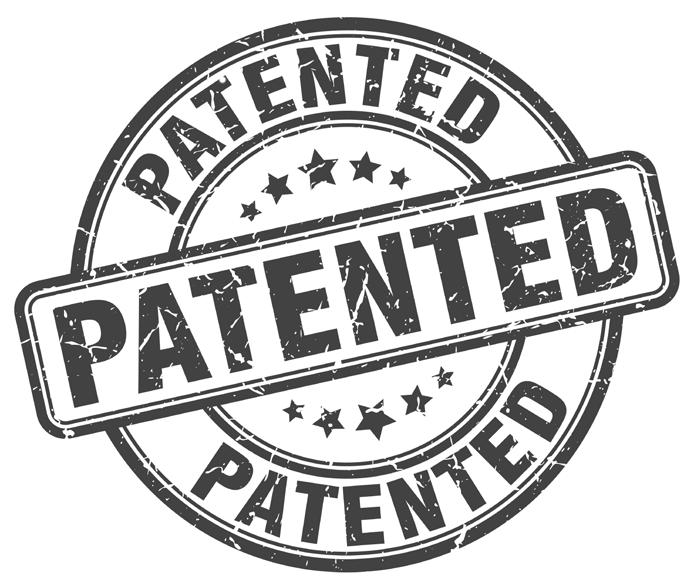

LASER TREATMENT FOR SKIN REJUVENATION
Agnieszka Lew-Mirska, MD, discusses the clinical results she experienced using the Secret 1540 nm non-ablative fractional Er:Glass laser for skin rejuvenation
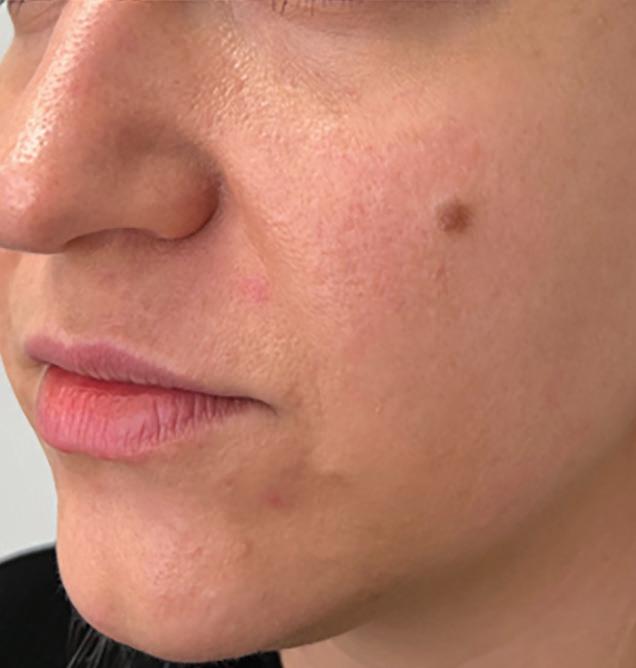


THIS STUDY FOCUSES on evaluating the potency and skinimproving effects of a non-ablative fractional erbium glass laser alone. Patients in this study were Fitzpatrick skin types II-III and 27-42 years of age. Under topical anesthesia they each had three sessions of the 1540 nm non-ablative Er:Glass laser at 3–4-week intervals. Pre- and post-treatment photographs and satisfaction surveys were taken at each session.
Treatment
Output energy settings were selected based on many years of experience in working with Er:Glass lasers and tissue reactions, and increased with each treatment. For delicate skin or delicate face areas like the periorbital region, the parameter ranges used were 10.8mJ/900 μs to 14.4mJ/1,200 μs. At the beginning i-Motion mode was preferred, later changed into stamp mode. Normal skin was treated with parameters ranging from 12mJ/1,000 μs to 18mJ/1,500 μs, while acne scars or male skin was treated with ranges from 15.6mJ/1,300 μs to 20.4mJ/1,700 μs and 18mJ/1,500μs to 22.8mJ/1,900μs.
Deeper tissue coagulation and minimising unnecessary heating were achieved in accordance with the principle that depth of penetration was maximised with a higher energy level, a 600 μm lens, and the micro thermal zones (MTZ) were decreased using low density on the same level 0.8 mm–0.9 mm. A cooling system was used from the second treatment
to achieve even more selective dermal heating. Two or three passes were performed for full coverage of the treated area at each session. Post-treatment recommendations included the use of cooling, posttreatment creams for several days and permanent sun protection SPF 30 to 50. Patients had no restrictions on normal activity.
The majority of treatments were well tolerated with minimal adverse effects, such as burning sensation and mild erythema. Prolonged erythema, which required the use of a mild steroid cream was observed in two cases. Immediate erythema and oedema appeared and resolved upto 48 hours later for more aggressive procedures. Patients were followed up 1 month after the last treatment.
Conclusion

The non-ablative fractional 1540 nm laser, preserving epidermal barrier function, is an effective and safe alternative for ablative methods. All the
clinically proven and literature described methods of the laser action have been observed in treated patients. With very short downtime, it may significantly improve neocollagenesis, reorganisation of elastin fibres, and epidermal differentiation, finally leading to smoother skin texture including acne scars, skin lifting, tightening and lightening (some of the pigments and vessels are coagulated during procedure). Pre and post-treatment photographs and satisfaction surveys show that at least three sessions must be completed to achieve a satisfactory level of dermal remodeling and clinical improvement. Further improvement was observed at 1 month follow up in each case. The FDA has approved the use of the non-ablative fractional 1540 nm laser to treat acne and surgical scars, skin laxity, wrinkles, skin resurfacing, melasma, and pigmented lesions.
For more information, visit eng.ilooda.com
48 ❚ September/October 2023 | prime-journal.com
PROMOTION SECRET DUO 1540
ER:GLASS
NM
Figure 1 Secret 1540 nm non-ablative fractional Er:Glass laser result in smoothing skin texture including acne scars, skin lifting, tightening and lightening. (A) Before and (B) after.
AGNIESZKA LEW-MIRSKA, MD, Internal medicine specialist, Board certified aesthetic doctor of American Academy of Aesthetic Medicine, CEO, Self Esteem Aesthetic Clinic, Warsaw, Poland

BUTTOCK VOLUMIZING AND LIFTING USING HYALURONIC ACID DERMAL FILLER
Hanbit Hong, MD, explains why he believes the monophasic HA dermal filler e.p.t.q.® is the ideal product for buttock lifting

BEFORE PERFORMING any HA dermal filler treatment, design is the most important thing to consider, no matter which part you are injecting. Considering the characteristics of the treatment site, the degree of sagging of the current skeleton and tissue, and the overall harmony with other parts. It is also important to think of a design with the rheology of HA dermal filler in mind, proceed with the treatment according to the design, and check and modify the details as you inject if necessary.

Unlike an implant, HA dermal filler can be injected in small quantities into the necessary area, and it has a surprising advantage in that it can be applied to a large area through a small puncture. Additionally, if the patient does not like the result, you can use hyaluronidase to dissolve the HA dermal filler.
The book ‘Tumescent Technique’1 by Jeffrey A. Klein, MD, mentions,
‘The rapid subcutaneous infiltration of lidocaine for a facelift proved fatal at a dose of 2.5 g at a commercially available concentration2 Instantaneous absorption occurs with an IV injection of lidocaine, and a dosage of 20mg/kg can produce cardiovascular collapse and generalised convulsions3.’
Therefore, I conduct the procedure with a maximum 200 mg of lidocaine for facial treatments and 400 mg for the body. In general, I try to control the total lidocaine dosage below 100mg for the face and 200 mg for the body.
I prefer to use HA dermal filler without lidocaine for body procedures (over 100ml). The e.p.t.q.® series supply both types, with and without lidocaine.
Also, the high cohesiveness and lifting capacity of HA dermal filler helps to maintain the shape without migration. The cohesive strength of HA dermal filler gel can also be confirmed through a simple experiment (Table 1).
Cohesivity test and results
The monophasic HA dermal filler e.p.t.q.® series shows high cohesivity and gel integrity (Table 1).
Case review
When we look at the case in (Figure 1), the patient had some volume at the posterior buttocks, but the volume at the side pelvis was relatively insufficient, resulting in their legs looking shorter.
In general, the most protruding area in a woman’s side profile is the area marked ‘B’, which is the greater trochanter part of the femur. The area marked ‘A’ is the ASIS (anterior superior iliac spine), which is usually the second protruding area, and ‘C’ is usually a recessed area, which is why it is usually called a hip dip. The subject of the case needed volume at the lateral pelvis, but she did not want her legs to look shorter by having too wide and flat hips, so instead of B, A was the new pelvic point, and C was not fully filled but
50 ❚ September/October 2023 | prime-journal.com
PROMOTION
Table 1 JETEMA. Data on file.4 Experiment with ‘Gavard-Sundaram Cohesivity Assay’ 5 , Cohesivity tested at room temperature using 0.1 mg of methylene blue to 1.0 ml of each HA gel, Constant rotational frequency of 160rpm. Rheology Test using TA instrument DHR-2, 2022.
Product e.p.t.q.® Lidocaine S 500 356.87 68.82 15s 70s 95s G’ (Pa) G” (Pa)
HANBIT HONG, MD, President of LUXWELL Clinic, Korea; Seoul National University College of Medicine, Seoul, Korea
only moderately filled to give a ‘not too fat’ image.
I punctured both sides with an 18G needle, then injected 30cc of tumescent on each side using a 19G disposable cannula and treated the site using e.p.t.q.® (HA dermal filler without lidocaine, JETEMA Co., Ltd., Korea) with the 70mm 19G disposable cannula. If the area injected with HA dermal filler is stimulated by the movement of the muscles, it is likely to be uncomfortable, so most of the volume is filled in a moderately deep fat layer that is not very close to the fascia, and some areas that are not easily volumised were filled in a slightly shallow fat layer.
When I re-evaluated the volume after volumising areas A and C, the protruding area B was lifted and appeared less protruding, so the patient and I agreed to create more lifting by filling area D rather than filling part C. There was no complaint of pain during and after the procedure, and a total of 200 ml was used (almost the same amount in both the left and right sides). The patient was asked if she wanted a touch-up procedure after 1 month, but the patient said it was unnecessary, and she was very satisfied with the result.
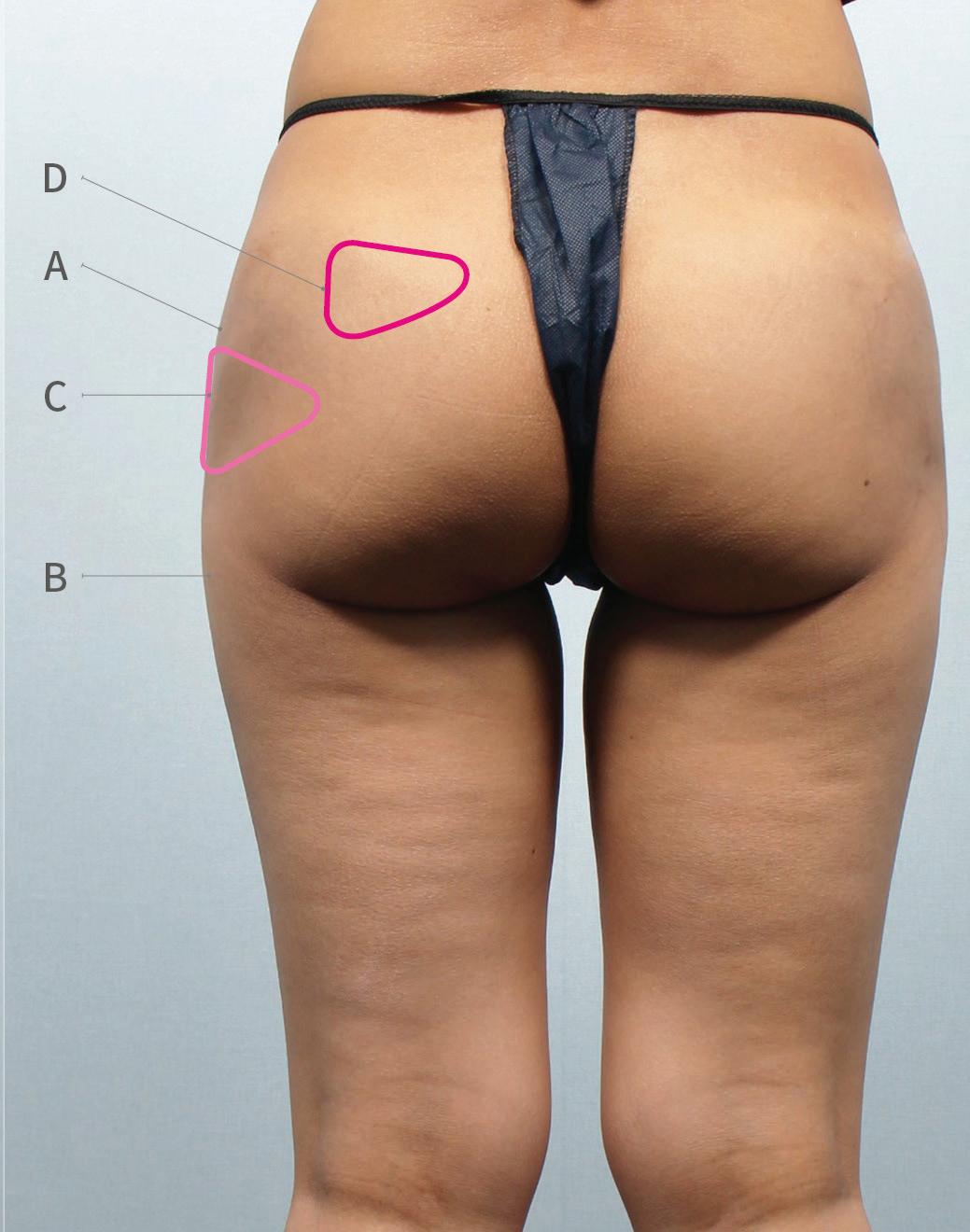
I recommend checking the patients’ condition around 2 weeks to 1 month after the procedure, and if it feels that the initial volume is not enough, perform an additional touch-up procedure at the 1 month mark.
Why do you choose to use e.p.t.q.®?
I like e.p.t.q.® because it has excellent safety due to the small amount of chemical crosslinker (BDDE). When
injecting filler on the nose bridge, it is common for the filler to spread over the glabellar region and result in an ‘avatar’ nose, but with e.p.t.q.®, I do not see those side effects as much as others because of its stable rheology6 and cohesiveness6. That is why I love using e.p.t.q.® filler.
What do you like most about e.p.t.q.®?
e.p.t.q.® is excellent for large-volume injection because there are almost no side effects due to the minimum addition of chemical crosslinker (BDDE), an essential additive for the HA dermal filler manufacturing process. In addition, I like the fact that it has a product line with a variety of excellent rheology. e.p.t.q.® Lidocaine S500 is a good choice for the nose tip and chin that is required to withstand strong compression,
Further Reading
1. Klein, Jeffrey A. Tumescent Technique: Tumescent Anesthesia & Microcannular Liposuction. Mosby. 2000.

2. Sunshine I, Fike WW: Value of thin-layer chromatography in two fatal cases of intoxication due to lidocaine and mepivacaine, N Engl J Med 271:48, 1964.
3. Yukioka H, Hayashi M, Fujimori M: Lidocaine intoxication during
whereas e.p.t.q.® Lidocaine S100 is apt for fine wrinkles. e.p.t.q.® has sufficient G’6 and cohesivity6 to withstand the muscle and dynamic movement. In conclusion, e.p.t.q.® is excellent for body contouring as well as the face.
For more information, contact global@jetema.com
general anesthesia, Anesth Analg 7:207, 1990.
4. JETEMA. Data on file.
Experiment with Gavard-Sundaram Cohesivity Assay, and Rheology Test. April 2022.
5. Hema Sundaram et al., Cohesivity of Hyaluronic Acid Fillers: Development and Clinical Implications of a Novel Assay, Pilot Validation with a Five-Point Grading Scale,
and Evaluation of Six U.S. Food and Drug AdministrationApproved Fillers. Plast Reconstr Surg. 2015 Oct;136(4):678-686
6. Lee, Won, et al. Clinical application of a new hyaluronic acid filler based on its rheological properties and the anatomical site of injection. Biomedical Dermatology 2.1 (2018): 1-5.
prime-journal.com | September/October 2023 ❚ 51
“It is also important to think of a design with the rheology of HA dermal filler in mind, proceed with the treatment according to the design, and check and modify the details as you inject if necessary.”
Figure 1 (A) Before, (B) after buttock procedure using HA dermal filler. Patient: 41-year-old female. Treated area: Hip (Buttock). Product used: e.p.t.q.® (JETEMA, Korea). Amount injected: Total 200ml (100ml/side).
EFFICACY AND SAFETY OF A RECOMBINANT ENZYME TREATMENT WITH COLLAGENASE FOR OEDEMATOUSFIBRO-SCLEROTIC PANNICULOPATHY
the results from a recent study

EDEMATOUS Fibrosclerotic
Panniculopathy (EFP), also known as cellulite, is a frequent cause for consultation in aesthetic medicine due to its multifactorial origin. In order to address this condition, an experimental and longitudinal study was carried out using recombinant collagenase enzymes as a treatment.
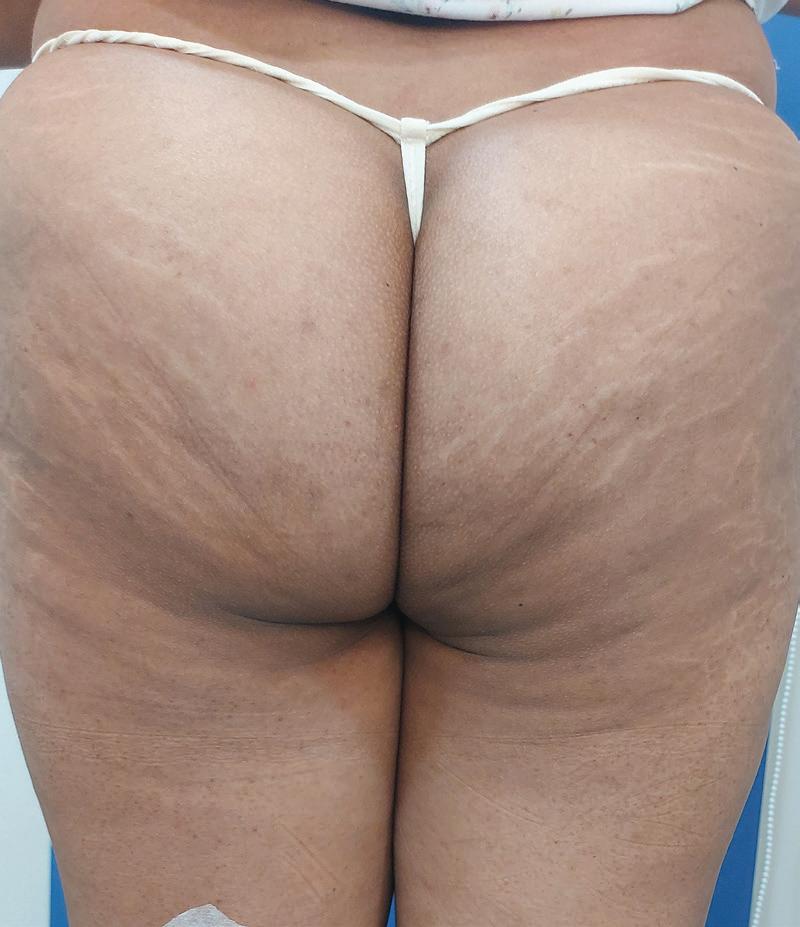
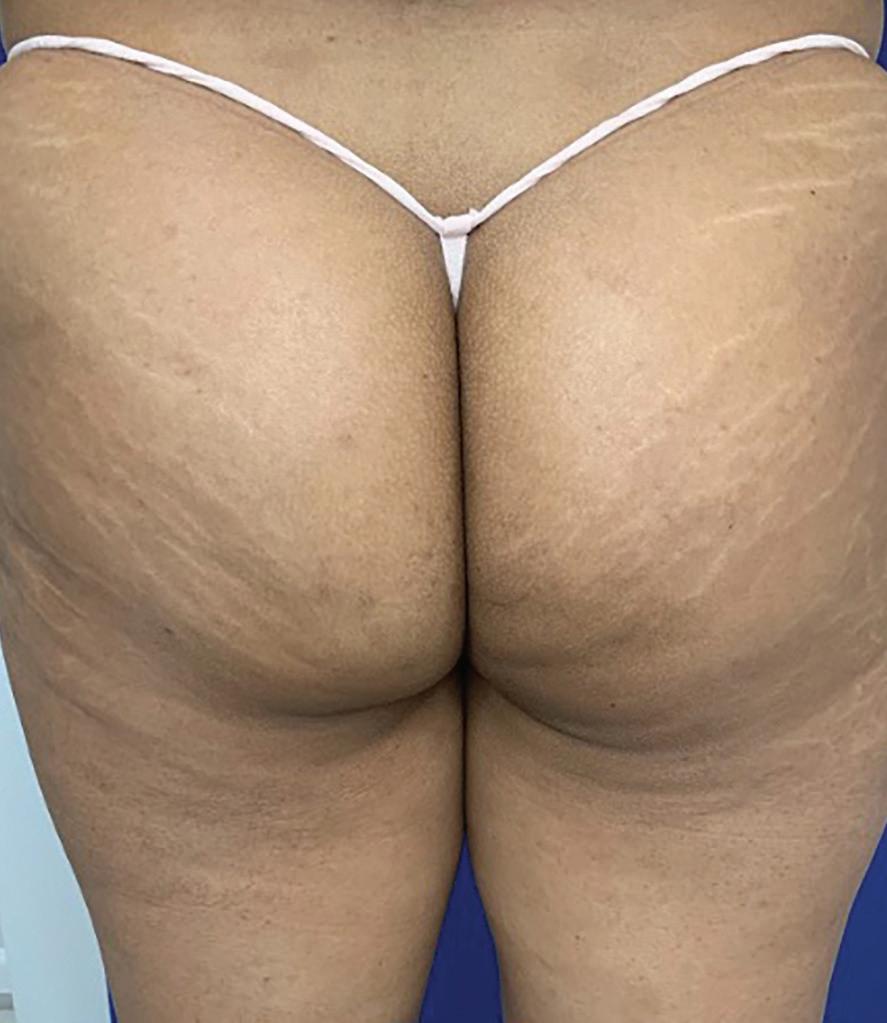
MAGHIELL GORDÓN, MD, International Master’s Degree in Aesthetic Medicine and Longevity by the University of Alcalá (Spain).

KATHERINE JAÉN, MD, International Master’s Degree in Aesthetic Medicine and Longevity by the University of Alcalá (Spain)
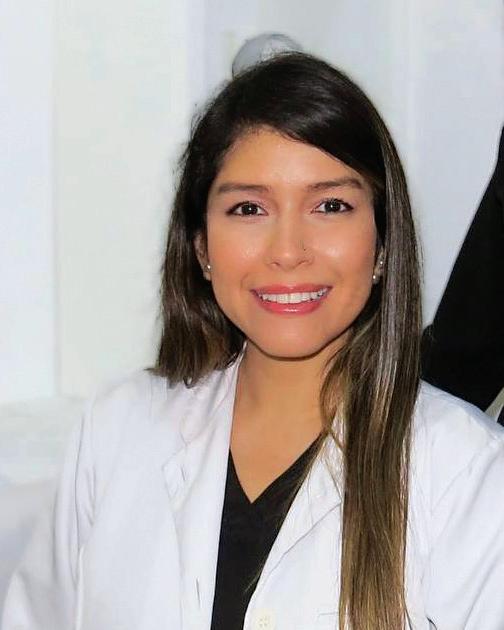
A total of 19 patients participated in this study who were given collagenase injections in the gluteal area. During a period of four months, each patient received two 5 ml vials of enzymes every 21 days. The results obtained showed a significant improvement in panniculopathy, evidenced by a decrease in the orange peel appearance of the
patients’ gluteus after the end of the collagenase treatment.
Collagenase breaks down the peptide chains of collagen I, which promotes the degradation and modulation of connective tissue. It
also stimulates wound healing and angiogenesis by increasing fibroblast proliferation and migration, thereby generating the formation of new collagen. This enzyme also has a high fibrinolytic capacity, which
52 ❚ September/October 2023 | prime-journal.com
PROMOTION
Drs Maghiell Gordón, Katherine Jaén, Jamel Fares, and Carlos Aznar discuss
Figure 1 (A) Initial evaluation, Grade II cellulite (B) Final evaluation, Grade I cellulite.
Table 1 Shows the number of patients with grade II cellulite before (14) and after (5) treatment. Source: Gordon and Jaén (2022)
allows it to dissolve collagen fibres around adipocytes found in cellulite nodules.
Material and methodology
The study was carried out at the Hospital Pacifica Salud (Panama) over a period of four months and included 19 female patients with gluteal cellulite classified as grade II or III according to the Hexsel Scale. Patients with grade I or IV cellulite, according to the Hexsel scale, were excluded.





The treatment consisted of the administration of the collagenase enzyme from the Spanish Simildiet Laboratory (Basic Enzyme Collagenase 150 IU) in four sessions with an interval of 21 days between each other. In every session, 5 ml (1 vial) of the product was injected into each gluteal area, specifically into the dimples produced by the cellulite, using 21G needles and following adequate asepsis with 90% alcohol. Each vial was reconstituted in 4 cc of saline 0.9% and 1 cc lidocaine.


Subsequently, the effects of the treatment were evaluated in patients with grade II cellulite. Of the 14 patients initially classified as having grade II cellulite according to the Hexsel Scale, 9 were reclassified as grade I after treatment with collagenase, while 5 patients maintained the same grade classification.
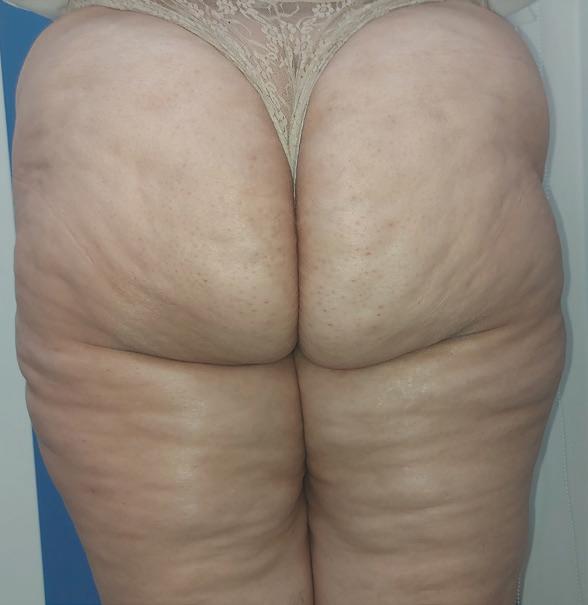
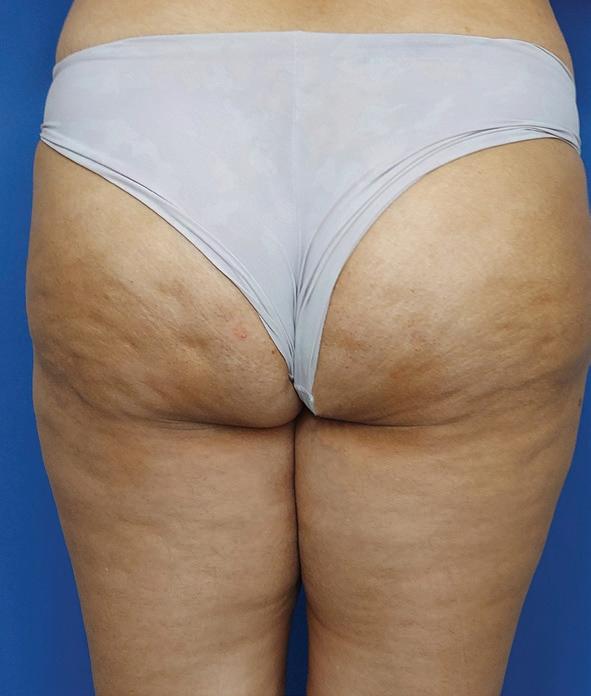
In conclusion, this study demonstrated that the use of recombinant enzymes, such as collagenase, is an effective and safe treatment to address oedematousfibrosclerotic panniculopathy.
Find out more at: simildiet.com

prime-journal.com | September/October 2023 ❚ 53
“The results obtained showed a significant improvement in panniculopathy, evidenced by a decrease in the orange peel appearance of the patients’ gluteus after the end of the collagenase treatment.”
JAMEL FARES, MD, CEO of Global Skin; CARLOS AZNAR SÁNCHEZ, MD, Master in Aesthetic medicine by L’Union International de Médecine Esthétique, General Manager of Simildiet Laboratorios
Figure 2 (A) Initial evaluation, Grade II cellulite (B) Final evaluation, Grade I cellulite.
Figure 3 (A) Initial evaluation, Grade II cellulite (B) Final evaluation, Grade I cellulite.
Figure 4 (A) Initial evaluation, Grade III cellulite (B) Final evaluation, Grade II cellulite.
JEAN-YVES COSTE

From your perspective, how would you compare the health and status of the medical aesthetic market today vs. prepandemic?
Medical Aesthetics' dynamics are still hitting on all cylinders, growing from an estimated $11.7bn in 2019 to $21bn in 2026, a ca. 9% CAGR (Source: Clarivate LLC), due to a formidable resiliency against global geostrategic, macro fundamental and economic crises. Even during the most tragic times of the pandemic, the 'show went on' online with telemedicine, telediagnostic and e-commerce related to booming professional skincare and developed an
immersive experiential journey for patients, which improved their stickiness. Post-pandemic, patients engaged in a revenge spending splurge. This is driven by sustainable demand as a result of ageing demographics, urbanisation, and the democratisation of aesthetics as a status symbol in emerging markets.
Patients find themselves engaged in an ecosystem enticing them into a captive personalisation of their treatment, which generates loyalty once a certain regularity in the treatment protocol has been reached. Zoom Boom, connectivity to social networks and digitalisation accelerate the conversion, thanks to the constant interaction with HCPs, telediagnostication, telemedicine, and
visualisation of results, social network pressures among Gens Y and Z aspiring to self-transcendence and instant gratification, and active senior Boomers striving to increased beauty standards.
This technologically is powered by accurate instrumentation of medical devices and faster adoption fueled by a new generation of practitioners attracted by disruptive and incremental innovations to improve safety, efficacy, longevity, speed of onset of action (instant gratification, no downtime), and precision targeting for best results.
Post-COVID, safety to reduce procedure anxiety for patients was supported by the digitalisation of imaging to enable them to visualise the
PRIME PEOPLE | JEAN-YVES COSTE | 54 ❚ September/October 2023 | prime-journal.com
Wendy Lewis spoke to Jean-Yves Coste, Co-Founder of WINDOME BANKING PARTNERS in Paris, to get his perspective on the global aesthetic market today and what the future holds for companies, investors, practitioners and patients
simulation of results with amazing precision.
The rise of more noninvasive to minimally invasive face and bodyenhancing treatments is driving steady interest for more consumers to enter the market. What are the top trends you are watching closely?
For facial treatments, natural beauty without overcorrections, facial resurfacing, rhinoplasty, blepharoplasty, reshaping of the face, rejuvenation of smile for women, masculinisation of the face for millennials, hair restoration, prejuvenation and lunchtime procedures such as mesotherapy and microneedling have gained traction in Europe, China and MENA. This is prevalent in younger generations who pursue an ideal 'skin fitness' by postponing the first signs of ageing, through submental fat reduction and retexturising their skin. For body procedures, cellulite, body reshaping and tightening, vulvovaginal and pelvic treatments are popular. Body sculpting treatments benefit from the trend of a 'one stop shop' for the client, inviting patients to engage in immersive experiential journeys by combining energy-based devices, picosecond laser or RF microneedling with dermal fillers or post-op dermocosmetics.
How is the rapid emergence of AI and deep learning impacting medical aesthetics from all angles?
The gravitational pull of generative AI, the metaverse, blockchain, machine learning and deep learning are impacting aesthetics, and the skincare vertical (dermatology, dermocosmetics, skincare) is the vanguard of new developments:
■ Empowering patients: To visualise themselves in a simulated augmented vision post-procedure, accelerating the conversion from considerer to patients
■ Research: Genomics and transcriptomics data analytics tools are used to accelerate screening of novel libraries of potential molecules, implementation of Open-Source
Body sculpting treatments benefit from the trend of a 'one stop shop' for the client, inviting patients to engage into immersive experiential journeys by combining energy based devices, Picosecond laser or RF microneedling with dermal fillers or post-op dermocosmetics.

Application Programming Interfaces, blockchain and AI to screen massive online molecule repositories
■ Development: Profiling new drugs and intelligent drug design to drive efficiencies, quantitative analytics for statistical extrapolation, virtualisation of clinical study phases to reduce risks
■ CRM: AI, machine learning, deep learning, big data analytics to enhance the customer journey and develop immersive ecosystems with infinite modalities to retarget them with related treatments after gateway procedures and track their personal aesthetic journey
■ Metaverse: Will empower patients to create their digital avatars revealing their self-image perception and engage in real-time human-like conversations with chatbots or other patients and doctors
■ Promotion: Through virtual trade shows and live congresses, such as Hydrafacial’s Virtual AMWC, to attract more visitors to their platforms
■ Education and Training: Webinars and online courses to leverage KOLs to showcase product usage
■ Post-marketing surveillance: Enhanced interconnectivity with aesthetic social networks, such as Realself in the US/UK and SoYoung Gengmei in China. Digitalisation of the flywheel model for better patient interaction and retention
■ Promote post-operative homecare: Through IOMTs (Internet of Medical Things) patients can learn how to create personalised products tailored to their skin issues
■ Digital Hall of Famers: Will eclipse competitors by acquiring and retaining new patients for increased market-share.
prime-journal.com | September/October 2023 ❚ 55 | JEAN-YVES COSTE | PRIME PEOPLE
At every congress, more brands from Asia are introducing innovative products and technology. What is the impact of these emerging markets?
There is a rise in regenerative medicine developments propelled by DNA-based personalised care. Genetic profiling SNPs, skin-microbiota symbiosis, tissular homeostasis, nano-biotechnologies and cellular targeting, stem cells and cellular therapies (PRP, fat-based tissue transplants), deglycation to inhibit collagen decay; human, plant-derived, and new forms of synthetic recombinant exosomes; biostimulators driven by PCL, PMMA, PLLA, and tissular inductors powered by PDRN and PN in Korea. Stimulated by a more liberal regulatory environment, Korean players advance claims regarding rheological parameters and boosting deep dermis penetration to enhance plasticity, homogeneity, 'silkiness', cohesiveness and longevity. In Europe, a new class of dermocosmetics is at the forefront of skin microbiota and telomerase inhibitors.
clinically validated CO2, Erbium Glass and Q-switched ND:YAG lasers, hyaluronic acid, calcium hydroxyapatite (CAHA-based) skin rejuvenation tissular inductors, semi-permanent fillers in their portfolio to harness the effects of regenerative medicine and energy-
digital imaging, machine learning and deep-learning, database capabilities to analyse skin conditions and recommend protocols, taking advantage of augmented reality to enable the visualisation of treatment results, and machine learning to evaluate the urgency of treatments.
Smartphone applications, such as ‘Spotscan’ by LaRoche-Posay Effaclar, represent a pioneering AI-powered telediagnostic instrument developed with dermatologists to analyse the severity of facial and body acne and provide a daily care solution for acneprone skin.
AI-powered chatbots engage customers with the ability to retarget patients with complementary product offerings via quantitative analytics.

Eric Schmidt, executive chairman of Alphabet, has said the perfect dermatology startup 'will be crowd-sourced, AI- and MLbased and that model is a highly likely candidate to become a $100 billion corporation.'
New technology will disrupt dermatology. Google AI can now accurately detect 26 skin conditions. Technology has the potential to accurately diagnose diseases, assist doctors in choosing the most effective treatments, and help patients better manage their condition.
Digital skincare apps personalise the relationship with customers by leveraging synergies with personalised skincare IOT systems and subscriptions to enrich the treatments for patients.
Combination treatments are being used to deliver better and longer lasting outcomes for patients such as pairing hyaluronic acid or other dermal fillers, PEG with energy-based devices such as multipolar and fractionated RF, plasmabased or fractional RF, can leverage cross-selling. For example, the integrated minimally invasive aesthetics player MatexLab SA in Switzerland offers standardised treatments combined with
based devices, and pairing skin boosters with revitalisation agents and energybased devices to penetrate the deep dermal tissues to enhance the skin boosters.
What is your take on the emergence of the personalisation trend among skincare brands?
Skincare brands have introduced telediagnostic platforms leveraging AI,
Jean-Yves Coste is Co-Founder and Chairman along with Florian Puchly of WINDOME BANKING PARTNERS, a new Financial Advisory Platform dedicated to Healthcare, Holistic Well-Being and Lifestyle, Medical Aesthetics, Dermocosmetics and Regenerative Medicine as well as digital health based in Paris with offices in Frankfurt and San Francisco.
The rise of combination treatments, such as skin boosters, devices paired with topical agents, and weight-loss drugs with body sculpting, offer new opportunities for clinics to differentiate from the competition. What do you recommend practitioners add to their menu of services?
PRIME PEOPLE | JEAN-YVES COSTE | 56 ❚ September/October 2023 | prime-journal.com
AI-powered chatbots engage customers with the ability to retarget patients with complementary product offerings via quantitative analytics.

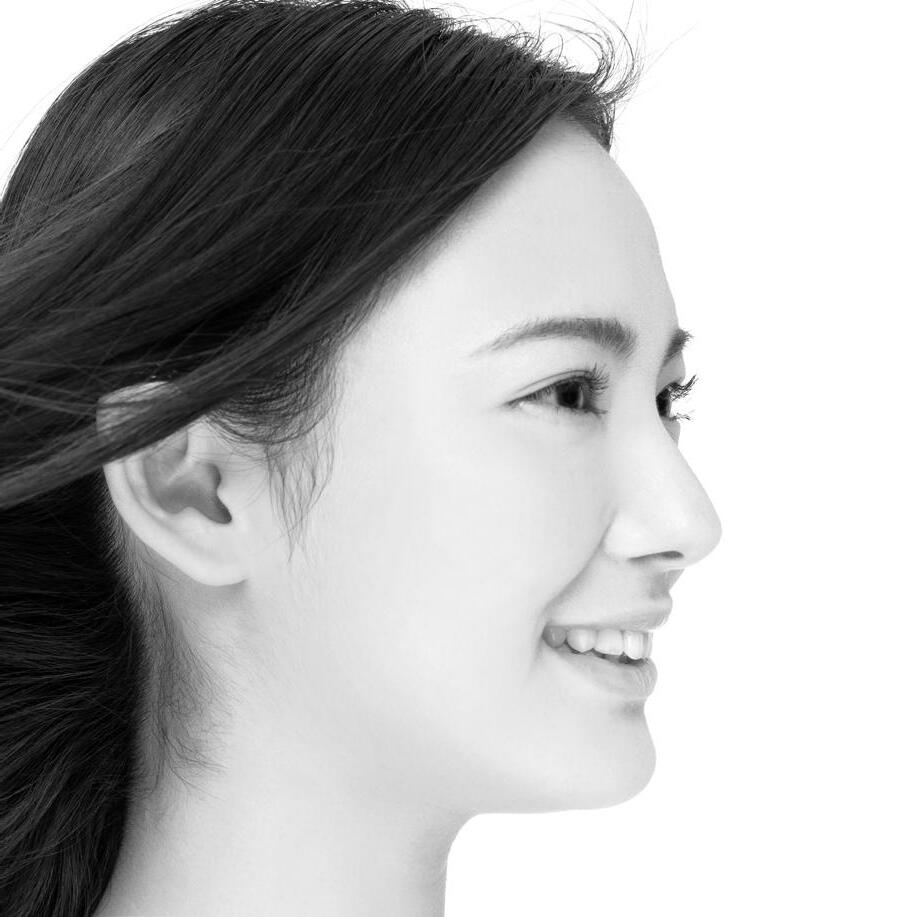



WWW.EUROMEDICOM.COM ASEAN POWERED BY Bali INDONESIA BALI NUSA DUA CONVENTION CENTER 7-8 OCTOBER 2023
EUROPE
28–29 SEPTEMBER 2023
BAAPS 2023
London, UK
baaps.org.uk/
5–7 OCTOBER 2023
AGORA 2023
Milan, Italy www.congressomedicinaestetica.it

11–14 OCTOBER 2023
EADV 2023
Berlin, Germany eadvcongress2023.org/
19–20 OCTOBER 2023
CCR 2023
London, UK

www.ccrlondon.com/about-ccr/
Industry events in 2023/24 for the aesthetic and anti-ageing market


17–18 NOVEMBER 2023
VISAGE 2023
Monte Carlo, Monaco www.visagecourse.com
17–19 NOVEMBER 2023
SCARS 2023
Berlin, Germany www.scars-meeting.com/
15–16 MARCH 2024
ACE 2024
London, UK www.aestheticsconference.com/
27–29 MARCH 2024
AMWC 2024
Monte Carlo, Monaco

www.euromedicom.com
REST OF WORLD NORTH AMERICA

26–29 OCTOBER 2023
Plastic Surgery: The Meeting Austin, TX www.plasticsurgerythemeeting.com
1–3 DECEMBER 2023
Beauty Through Science New York, NY www.bts-newyork.com/nyc
22–24 FEBRUARY 2024
AMWC Americas Miami, FL www.amwcamericas.com
7–8 OCTOBER 2023
FACE ASEAN Bali, Indonesia
www.euromedicom.com
20–22 OCTOBER 2023
AMWC China Chengdu, China www.euromedicom.com

18–19 NOVEMBER 2023
AMWC Japan
Kyoto, Japan
www.amwc-japan.com/en

EVENTS CALENDAR |
events
58 ❚ September/October 2023 | prime-journal.com









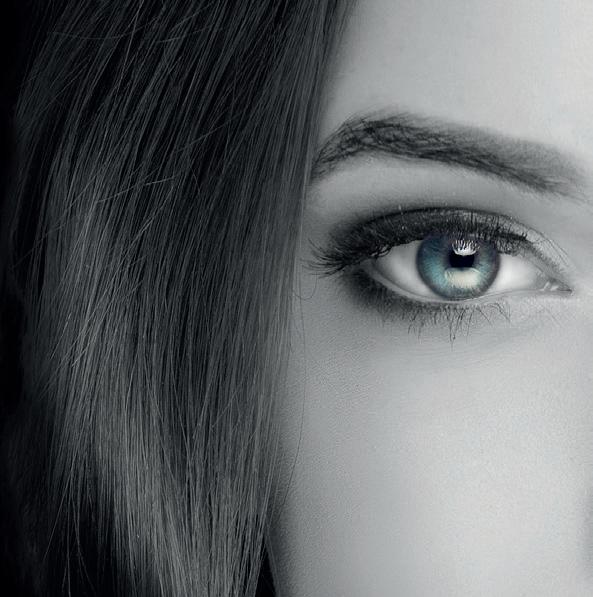









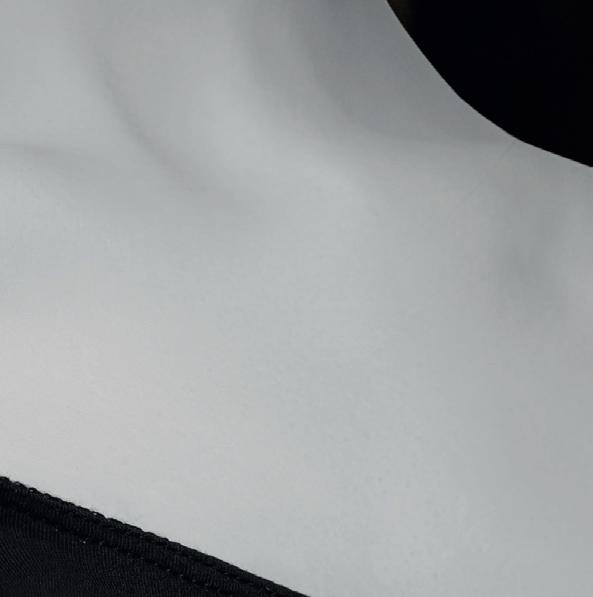
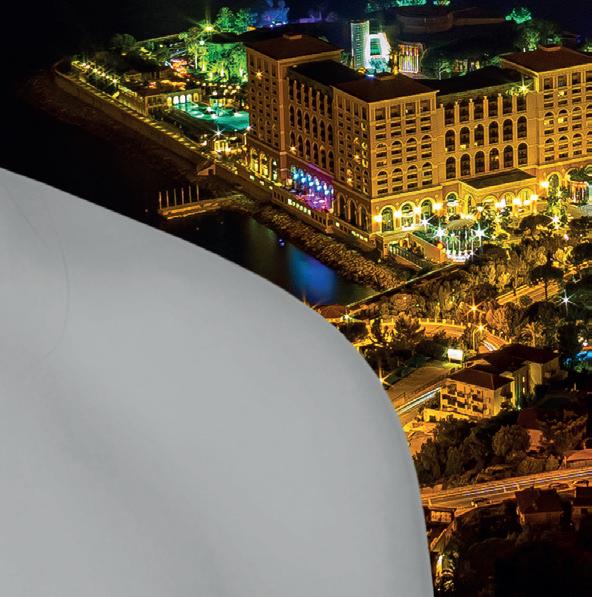


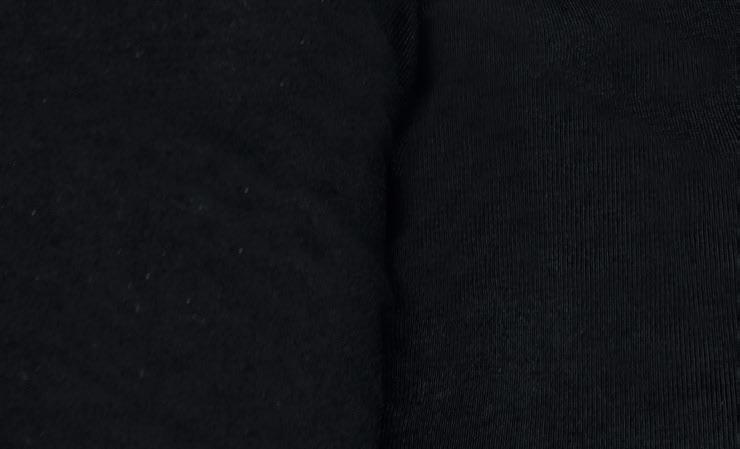




27-28-29 MARCH 2024 MONTE-CARLO, MONACO GRIMALDI FORUM Under the scientific supervision of the Aesthetic Multispecialty Society (AMS) Under the High Patronage of H.S.H. Prince Albert II of Monaco WWW.AMWC-CONFERENCE.COM EXPERTISE EVIDENCE EXCELLENCE ENGAGEMENT


























 Balraj Juttla Editor, PRIME balraj.juttla@informa.com
Balraj Juttla Editor, PRIME balraj.juttla@informa.com










































































































































 Figure 1 The structure of the barbed thread we used, USP 1 and 3-0 in diameter, 17 cm in length, with bilateral barbs
Figure 2 Illustration of the method of 4-stage nasal augmentation. (A) nasion and nasal bridge, (B) nasal columella. (C) nasal tip.
Figure 1 The structure of the barbed thread we used, USP 1 and 3-0 in diameter, 17 cm in length, with bilateral barbs
Figure 2 Illustration of the method of 4-stage nasal augmentation. (A) nasion and nasal bridge, (B) nasal columella. (C) nasal tip.









 Figure 6 The silhouette image analysis also showed the elevation of the nasion and nasal bridge. (A) before treatment (the silhouette image) and immediately after treatment, (B) before treatment and 1 month after treatment
Figures 1–6 © Aaron Hsieh
Figure 4 The colour image analysis shows the elevation of the nasion and nasal bridge. (A) before treatment, (B) immediately after treatment, (C) 1 month after treatment, (D) 3 months after treatment
Figure 6 The silhouette image analysis also showed the elevation of the nasion and nasal bridge. (A) before treatment (the silhouette image) and immediately after treatment, (B) before treatment and 1 month after treatment
Figures 1–6 © Aaron Hsieh
Figure 4 The colour image analysis shows the elevation of the nasion and nasal bridge. (A) before treatment, (B) immediately after treatment, (C) 1 month after treatment, (D) 3 months after treatment













































































